June, 2025
now browsing by month
Post Marathon Massage for Optimal Recovery
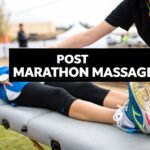
You’ve crossed the finish line. The euphoria is real, but so is the deep, profound ache settling into your muscles. A post-marathon massage isn't just a well-deserved treat; it's a crucial first step in your recovery, helping your body clear out the debris of a massive effort and begin the healing process.
Your Post-Race Reward: What Is a Post-Marathon Massage?
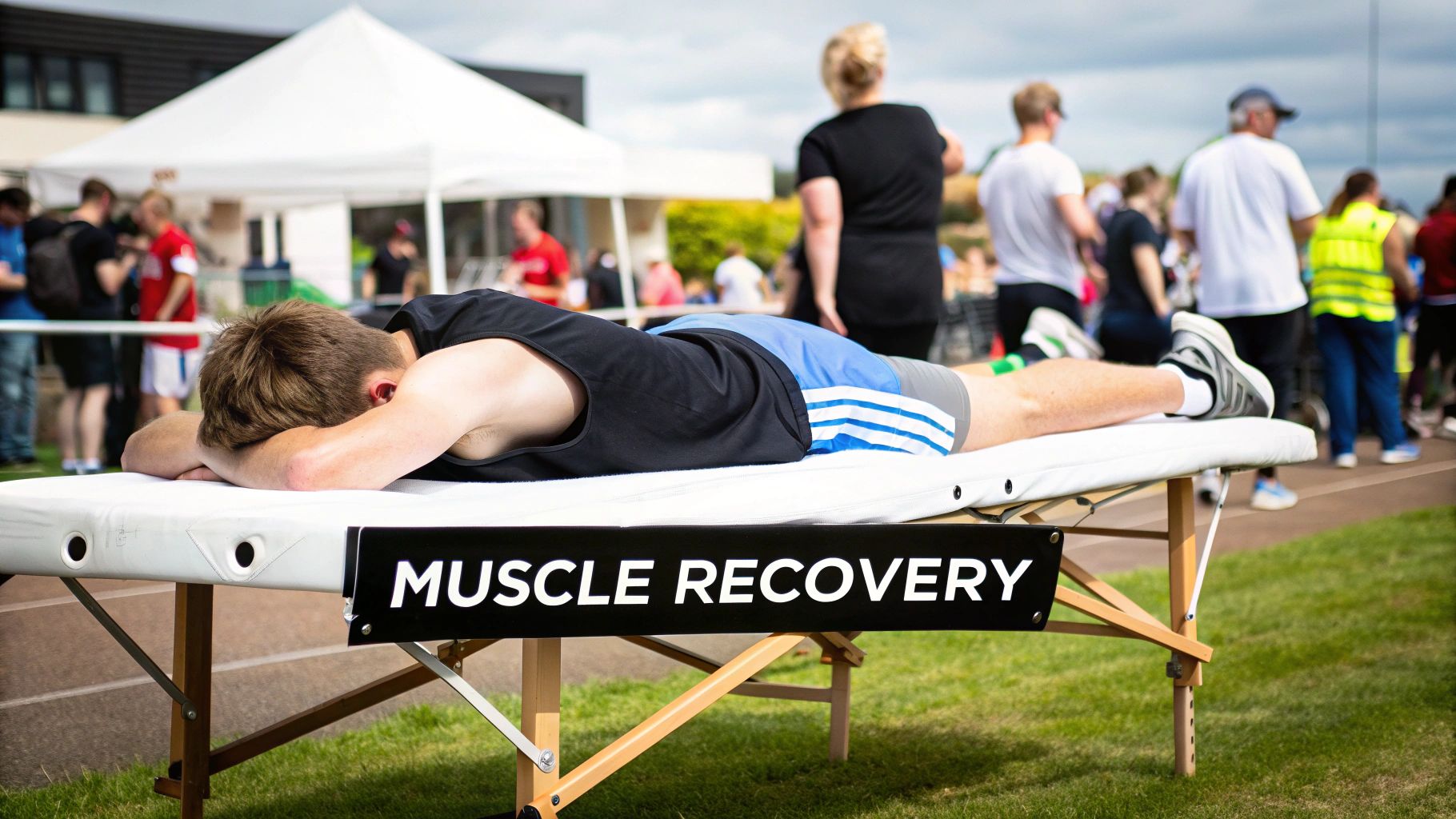
You just pushed your body to its absolute limit for 26.2 miles. So, what's next? That period right after the race is a critical window for healing, and a post-marathon massage is tailored specifically to address the unique stress your body has just gone through.
Think of your muscles after a marathon like a highway system after a holiday weekend—congested, backed up, and full of tired travelers. The race creates microscopic tears in your muscle fibers and causes a buildup of metabolic waste products. A targeted massage is like bringing in a crew of expert traffic controllers and road-clearers to get everything moving smoothly again.
The Purpose of a Post-Race Massage
This isn't your typical day-spa relaxation massage. The goals here are very specific, and it's certainly not about grinding into sore muscles with deep, aggressive pressure. That could actually do more harm than good. Instead, the focus is on supporting your body’s own recovery systems.
The immediate aims are:
- Tackling Muscle Soreness: Gentle techniques can take the edge off Delayed Onset Muscle Soreness (DOMS), that familiar, intense ache that usually peaks 24 to 48 hours after you finish.
- Boosting Circulation: Light, flushing strokes get your blood and lymph flowing. This brings fresh, oxygenated blood to your exhausted muscles and, just as importantly, carries away the waste that's making them sore.
- Calming Your Nervous System: A marathon sends your body into a high-alert, "fight or flight" state. A soothing massage helps you downshift into the "rest and digest" mode where real recovery can finally begin.
- Restoring Flexibility: After hours of repetitive motion, your muscles are incredibly tight. Gentle stretching within the massage helps coax some length back into your hamstrings, quads, calves, and hips.
A common mistake is thinking a post-race massage needs to be deep and painful to work. The truth is, especially in the first 72 hours, a gentle and restorative approach is far more effective. It coaxes the muscles to relax without causing more damage to the already sensitive tissue.
This is why your body is practically screaming for this kind of care. It’s not just about feeling good; it’s a smart, calculated part of a solid recovery plan.
At a Glance Post-Marathon Massage Blueprint
To make sense of the different stages of post-race massage, it helps to have a quick reference. This table breaks down the essentials, from when you should book your session to what the therapist should be focused on.
| Timing Window | Primary Goal | Recommended Intensity | Key Benefit |
|---|---|---|---|
| 0-6 Hours Post-Race | Flushing & Calming | Very Light (1-2/10) | Reduces immediate swelling & calms nerves |
| 24-72 Hours Post-Race | Soreness Relief & Assessment | Light (2-4/10) | Eases DOMS & identifies problem areas |
| 3-7 Days Post-Race | Deeper Repair & Restoration | Moderate (5-7/10) | Addresses knots & restores range of motion |
This blueprint helps you match your massage to your body's needs at each step of the recovery journey, ensuring you get the most out of every session.
Timing and Technique Are Everything
The real magic of a post-race massage lies in two things: when you get it and what the therapist actually does. Getting an aggressive deep tissue massage too soon can backfire, increasing inflammation and setting your recovery back.
That's why understanding the timeline is so important. A light, flushing massage might be perfect within a few hours of finishing, but a more focused, deeper sports massage is best saved for a few days later. We'll dig into this timeline so you know exactly when to book your appointment and what to ask for when you’re on the table.
The Science Behind Why Your Muscles Need a Massage
Ever wonder why every single fiber in your body seems to scream for relief after running 26.2 miles? It’s not just in your head. There's a fascinating physiological drama unfolding inside your muscles, and a well-timed post marathon massage is exactly what your body is craving to manage the fallout.
Imagine your muscle fibers are like a perfectly woven rope. A marathon puts that rope under incredible, repetitive strain, causing thousands of microscopic tears throughout the tissue. This isn't a bad thing—it's how muscles get stronger—but on the scale of a marathon, the damage is pretty extensive.
This micro-trauma is the real culprit behind Delayed Onset Muscle Soreness (DOMS), that deep, nagging ache that usually shows up 24 to 48 hours after you cross the finish line. It's more than just tiredness; it's your body's inflammatory alarm bell ringing in response to all that cellular-level damage.
How Massage Steps in to Help
Think of a post-marathon massage as a highly skilled biological cleanup crew. It's not about punishing already-damaged muscles with aggressive pressure. The goal is much smarter: to create the perfect environment for your body's own natural repair processes to kick into high gear.
Here’s a look at what’s happening on the table:
- Flushing Out the Gunk: Gentle, rhythmic strokes encourage fluids to move. This helps clear out the metabolic junk, like lactate and other waste products, that builds up during a race and makes you feel so sore.
- Bringing in the Good Stuff: By improving circulation, massage brings a fresh supply of oxygen and nutrient-rich blood directly to your exhausted muscle tissues. These are the raw materials your body desperately needs to start rebuilding.
- Taming the Inflammatory Fire: While some inflammation is a necessary part of healing, too much for too long can actually slow down recovery. Research has shown that massage can help dial down the inflammatory response, which in turn reduces the pain and swelling from DOMS.
This deep, biological support is precisely why a massage feels so restorative. It’s not just a surface-level treat; it's actively helping to realign those frayed muscle fibers and get you back to feeling whole.
Key Insight: A post-marathon massage doesn't magically "fix" your muscles on the spot. Instead, it creates the ideal conditions—less waste, more nutrients—for your body to heal itself far more effectively.
From Fight-or-Flight to Rest-and-Repair
Running a marathon floods your system with stress hormones like cortisol, launching your nervous system into a "fight-or-flight" state. That's great for pushing through the last few miles, but it's terrible for recovery. Your body simply can't repair tissue when it's still on high alert.
A gentle massage does something incredible: it helps you downshift from that stressed-out state into the "rest-and-digest" (parasympathetic) mode. Making this switch is absolutely essential for healing to begin.
Benefits of Activating the Parasympathetic System:
| System Response | In a "Fight-or-Flight" State | In a "Rest-and-Digest" State |
|---|---|---|
| Heart Rate | Elevated | Slows down to a resting rate |
| Muscles | Tense and ready for action | Relax and release tension |
| Healing | Suppressed | Actively promoted |
| Mental State | Anxious and hyper-aware | Calm and relaxed |
This calming effect is powerful. It lowers your blood pressure, reduces stress hormones, and gives your body the green light to start the crucial work of rebuilding. This is the science-backed reason why massage isn't just a luxury—it’s a fundamental tool for recovery.
Once you understand what’s happening inside your muscles, it’s easy to see why massage is such a game-changer for your post-race plan. To learn more about the specific techniques that help runners the most, you can check out our detailed guide on sports massage for runners. It's a great resource for understanding how different approaches can support both your training and your recovery.
The Runner's Timeline: When to Schedule Your Massage
You did it. You crossed the finish line, and all you can think about is booking a deep, satisfying massage to work out all the kinks. But when it comes to a post-marathon massage, timing isn't just important—it's everything. Scheduling your session at the right moment can mean the difference between supercharging your recovery and actually making things worse.
Think of your muscles after 26.2 miles like a piece of silk that's been stretched to its absolute limit. They're inflamed, sensitive, and full of microscopic tears. Hitting them with an aggressive, deep tissue massage right away is like taking a wire brush to that delicate silk. You’ll only do more harm than good. The real key is to match the massage to what your body needs at each specific stage of healing.
The Immediate Window: 0 to 6 Hours Post-Race
In the first few hours after you get your medal, your number one goal is simple: calm everything down. Your muscles are in a state of acute inflammation and are incredibly tender. A deep, intense massage right now is a huge mistake.
Instead, this is the perfect time for a very light, gentle "flushing" massage. The therapist will use long, light strokes (a technique called effleurage) to get your circulation moving and help your lymphatic system start clearing out all the metabolic junk left over from the race.
- Goal: To reduce that initial swelling and tell your nervous system it's time to relax.
- Intensity: Keep it extremely light, around a 1-2 on a pain scale of 10.
- Duration: Short and sweet is the way to go. A 15-20 minute session is plenty. You'll often find therapists offering exactly this kind of first-aid massage at race expos.
Think of this session as an immediate response—it soothes your tissues and gets the recovery ball rolling without adding any more stress to your already exhausted body.
The Prime Recovery Window: 24 to 72 Hours Post-Race
Okay, this is the sweet spot. This is when you should book your first real post-marathon massage. By now, the most intense, fire-breathing inflammation has started to die down, but Delayed Onset Muscle Soreness (DOMS) has probably shown up in full force. Your body has officially switched from crisis mode into repair mode.
Getting a massage during this period can dramatically cut down how long and how painful your DOMS experience is. The science backs this up, too. A respected study on ultramarathoners found that athletes who got a 20-minute massage right after their race felt significantly less muscle pain and fatigue. You can dig into the specifics in the Journal of Orthopaedic & Sports Physical Therapy.
At this point, a therapist can start using a bit more pressure to tackle the soreness and tightness that have really settled in.
What to Expect: This massage should still feel restorative, not like a punishment. The focus will be on easing soreness, boosting blood flow to your damaged tissues, and gently stretching out those tight muscle groups like your hamstrings, quads, and calves. It's also a great time for your therapist to check out any specific problem areas that cropped up during the race.
This image shows a great visual of how different massage pressures are used to help with recovery.
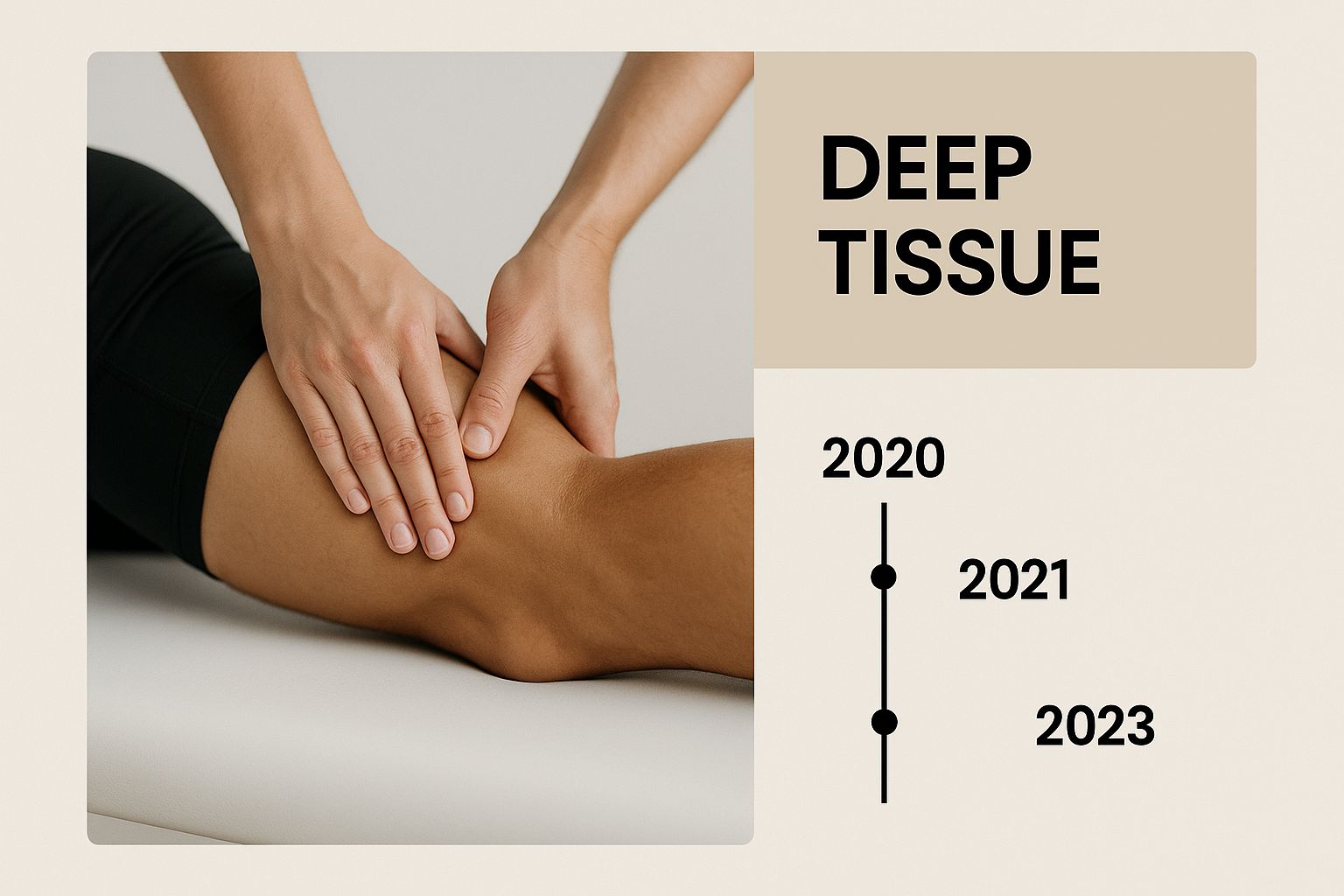
As you can see, the more intense techniques like deep tissue are saved for later, once your muscles aren't so inflamed and are ready for more targeted work.
The Maintenance Window: 3 Days and Beyond
Once you’re past that 72-hour mark, your muscles are much less sensitive and are well on their way to rebuilding. This is the perfect time to schedule a more focused, deeper sports or deep tissue massage if you feel you need it.
Now, your therapist can safely go to work on any of those stubborn knots, adhesions, or chronic tight spots without risking an inflammatory flare-up.
What a Maintenance Massage Focuses On:
- Breaking Down Adhesions: Using deeper techniques to release those gnarly knots that have formed in your muscle fibers.
- Restoring Range of Motion: Working out any imbalances or restrictions that might have developed from the race.
- Injury Prevention: Finding and addressing tight spots that could become bigger problems down the road as you start training again.
By following this timeline, you’re working with your body’s natural healing rhythm. You give it gentle support when it's most vulnerable and more direct intervention when it's ready, ensuring your post-marathon massage is a powerful recovery tool, not a painful setback.
Choosing the Right Massage for Marathon Recovery
Walking into a spa after a marathon can feel a lot like navigating a complicated menu when you’re starving. You know you need something, but what’s the right choice? It's a critical decision because not all massages are created equal, and picking the wrong one for your vulnerable, post-race muscles can be a real setback.
Think of your body as a high-performance vehicle that just completed a grueling race. You wouldn't take it to just any mechanic; you'd find a specialist who knows exactly what that engine needs to recover. The same logic applies here. Let's break down your best options.
Swedish Massage: The Gentle Traffic Director
If your main goal is simply to unwind and get your circulation moving again, a Swedish massage is an excellent starting point. This classic style is known for its long, gliding strokes, gentle kneading, and rhythmic tapping.
Picture it as a "traffic director" for your circulatory system. The therapist isn't trying to dig into deep knots but rather to gently encourage blood and lymph flow. This helps deliver fresh oxygen and nutrients to your muscles while ushering out the metabolic waste that's causing that familiar post-race soreness. It’s an ideal, gentle choice for the 24-72 hour window right after the race.
Sports Massage: The Specialist Mechanic
Now, if you're looking for targeted repair, a sports massage is your go-to. This is the "specialist mechanic" in our analogy. It’s designed specifically for athletes and focuses on the muscle groups that took the biggest pounding during your 26.2-mile journey—think quads, hamstrings, glutes, and calves.
A therapist trained in sports massage understands a runner's body. They use a combination of techniques, from targeted compression to assisted stretching, to address specific areas of tightness and fatigue. It's less about whole-body relaxation and more about functional repair. To get a better sense of how this approach differs, our article comparing sports massage vs a regular massage breaks it down even further.
Key Takeaway: A sports massage is your best bet for addressing specific running-related issues. The therapist can identify and work on muscle imbalances or tight spots that could lead to injury if left untreated.
Deep Tissue Massage: The Knot-Untangling Expert
Have some of those stubborn, deep-seated knots that feel like rocks embedded in your muscles? A deep tissue massage might seem like the obvious answer. This technique is the "knot-untangling expert," using slow, forceful strokes to reach the deeper layers of muscle and connective tissue.
But here, timing is everything. Deep tissue work is far too intense for the immediate post-race period. It should be reserved for at least 3-5 days after the marathon, once the initial inflammation has significantly gone down. Using it too early can actually increase soreness and even damage already-sensitive tissue.
The demand for this powerful technique is undeniable. The global massage therapy industry was valued at around $72.5 billion in 2025, with deep tissue holding the largest market share at 44.5% because of its effectiveness in treating chronic muscle pain. You can find more insights on the growth of the massage therapy market.
Lymphatic Drainage: The Swelling Reducer
Did your ankles or feet swell up like balloons after crossing the finish line? This is where lymphatic drainage massage comes in. It’s an incredibly light, specialized technique that acts as a "drainage specialist" for your body.
Your lymphatic system is your body’s waste-removal network, but unlike your circulatory system, it doesn’t have its own pump. This gentle, rhythmic massage manually stimulates the flow of lymph fluid, helping to reduce that puffy swelling and clear out inflammatory byproducts more efficiently. It's a fantastic, non-invasive option for the first 24-48 hours post-race.
How To Prepare For Your Massage Session
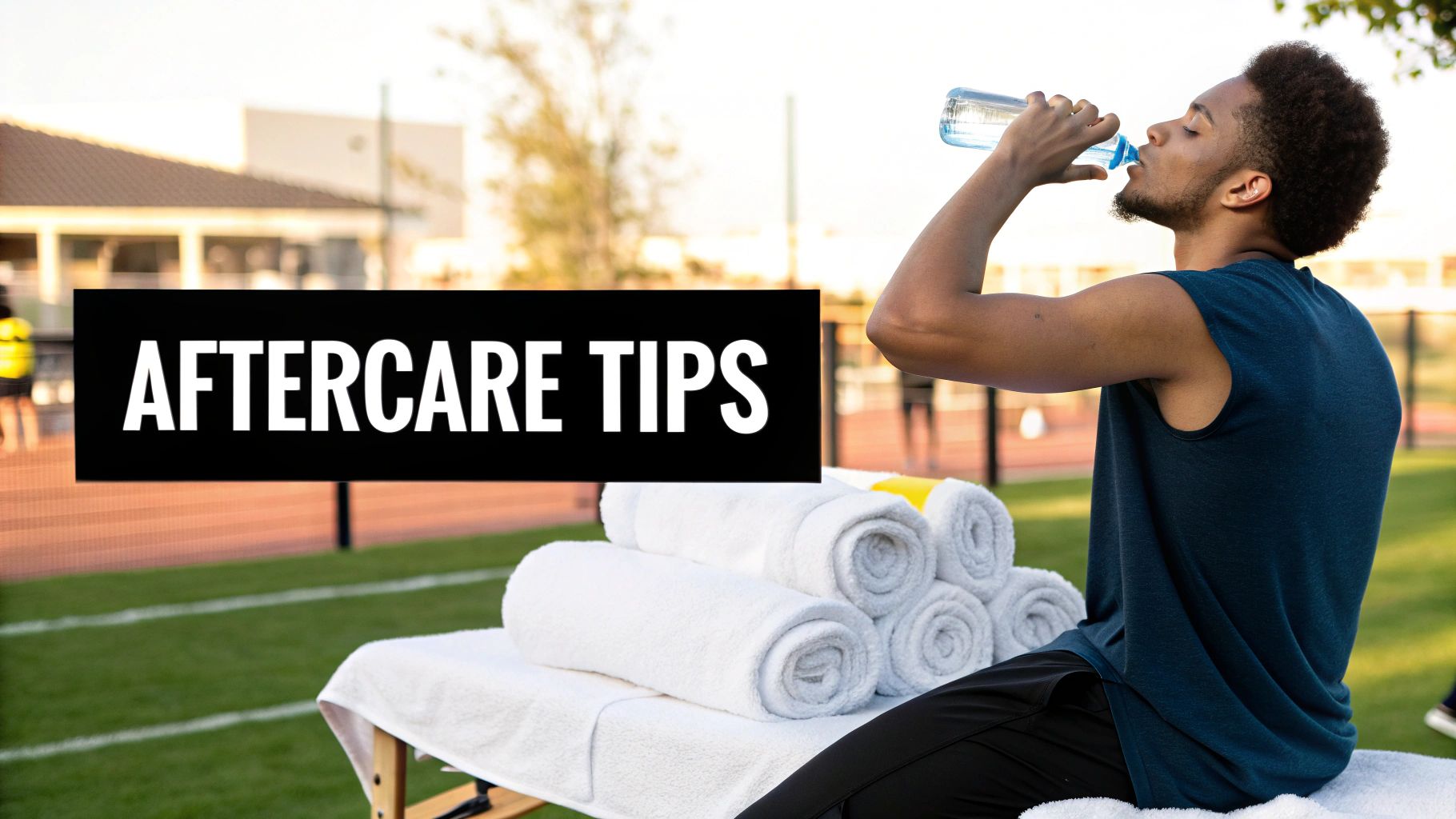
To get the most out of your recovery massage, you need to do a little prep work. It starts long before you ever step foot in the spa. A truly effective post marathon massage isn't just something that happens to you; it's a process you're a part of. The right preparation and communication can take a session from good to absolutely game-changing.
Think of it this way: you wouldn't just drop your car off at the mechanic's without mentioning that weird clanking sound it makes. The more detail you give your massage therapist about how your body is feeling, the more targeted and effective their work will be, especially after a grueling 26.2-mile race.
Before You Arrive
Your pre-massage game plan is straightforward but incredibly important. It all comes down to two things: hydration and being honest with your body.
First, make sure you drink plenty of water leading up to your appointment. Well-hydrated muscles are supple and easier for a therapist to work on. When your tissues are dehydrated, they become tight and almost brittle, which can make the massage less effective and frankly, more painful.
Second, try to avoid popping painkillers like ibuprofen right before you go in. It's tempting to want to dull the aches, I get it. But those pills mask your body's pain signals, which are crucial pieces of feedback for your therapist. They need to know what's working and what's too much, and for that, you need to be able to feel what's going on.
Communication Is Key During the Session
Once you're on the massage table, your most important job is to talk. Your therapist isn't a mind reader, and the "perfect pressure" for one runner could be agony for another.
Don't be a hero. Speak up! A simple 1-to-10 pain scale works wonders. A "5" or "6" is often that "good hurt" that signals progress. But if you're creeping up to a "7" or "8," that's your body's way of saying "too much." Your muscles will just tighten up to protect themselves, which defeats the whole purpose.
Get specific with your feedback. Instead of just grunting when something hurts, try giving more detail:
- "Could we go a little lighter on my right calf? That feels a bit sharp."
- "Yes, that spot on my hamstring feels like a productive ache. That's perfect."
- "My left quad definitely feels a lot tighter than the right one."
This running dialogue helps the therapist adjust their techniques on the fly, making sure you get the best results without irritating your already sensitive post-race muscles. If you want to dig deeper into the science behind this, our guide on massage for muscle recovery is a great resource.
After Your Massage
The recovery benefits don't end when you walk out the door. To keep that "just-massaged" feeling going, keep focusing on hydration. Drinking water helps your body flush out all the metabolic byproducts that were released from your muscles during the session.
For the next 24 hours, take it easy. Gentle movement is your friend—think a light walk or some easy, flowing stretches to maintain that new mobility. Stay away from any tough workouts; your body is still in a deep state of repair. The whole point of a sports massage after a marathon is to flush out waste and speed up healing, and experts agree that getting one 24 to 48 hours after the race sets you up for the fastest return to training.
Your Post-Marathon Massage Questions, Answered
Pushing your body through 26.2 miles is a massive accomplishment, but it leaves you with a lot of questions about what to do next. It's smart to be curious about getting a massage after a marathon—your body is in a uniquely vulnerable state, and making the right choices is key to a good recovery.
Let's dive into some of the most common questions runners have. We'll give you clear, practical answers so you can navigate your recovery with confidence.
Is a Post-Marathon Massage Supposed to Hurt?
This is probably the number one concern, and honestly, it’s a “yes and no” answer. A therapeutic massage after a marathon might bring on some discomfort, what many runners call a “good pain.” This usually happens when the therapist finds a stubborn muscle knot or a particularly angry spot.
However, it should never, ever be excruciating. The goal is to help you recover, not to see how much you can grit your teeth through.
This is where talking to your therapist is absolutely crucial. Use a simple pain scale from 1 to 10 to give them instant feedback. A light, flushing massage right after the race should feel gentle and completely pain-free. A deeper sports massage a day or two later might feel more intense, but if you find yourself holding your breath on the table, the pressure is too much.
Speak Up! A good therapist wants your feedback. Telling them, "That's a 7 out of 10," gives them the signal they need to adjust. A truly effective massage happens when your muscles can relax into the work, not tense up against it.
What if I Think I’m Injured? Should I Still Get a Massage?
This is a critical one. If you suspect a specific, acute injury—like a muscle tear, stress fracture, or bad sprain—stop. Do not book a massage. Your first call should be to a doctor or physical therapist.
A post-marathon massage is meant for the general, all-over muscle soreness and fatigue that comes with an incredible effort. We’re talking about Delayed Onset Muscle Soreness (DOMS), where your muscles are overworked but not actually torn. Pushing and kneading a fresh injury can make the damage much worse, increase inflammation, and set your recovery back significantly.
When to See a Medical Pro First:
- You feel a sharp, stabbing pain in one specific spot.
- You see major swelling or bruising around a muscle or joint.
- You can’t put your full weight on one leg.
- The pain is getting worse, not better, even with rest.
Once a doctor has diagnosed the issue, they can tell you if and when massage is a safe part of your official rehab plan.
How Much Does a Post-Marathon Massage Usually Cost?
There’s no single price tag, as the cost can swing quite a bit depending on a few things.
Here's what usually moves the needle on price:
- Location: A massage in a big city will almost always cost more than in a smaller town.
- Therapist’s Experience: A therapist who specializes in sports massage or has advanced certifications will likely charge more. That extra expertise is often worth every penny for an athlete.
- Session Length: Most places offer 60- or 90-minute sessions. The longer you’re on the table, the higher the cost.
- The Venue: A fancy day spa will have a higher price point than a dedicated sports therapy clinic or a mobile therapist.
On average, you can expect to pay anywhere from $70 to $150+ for a quality 60-minute massage. You’ll often find shorter, 15-20 minute flush massages at the race expo for a much lower price, sometimes even for free. Think of it less as a splurge and more as a smart investment in your running future.
I Can't Get a Professional Massage. What Are My Options?
While nothing beats the hands of a skilled professional, you are absolutely not out of luck if a massage isn't in the cards. There are plenty of fantastic self-care techniques you can do right at home to get similar benefits.
Think of these as your personal recovery toolkit. They might not have the intuition of a trained therapist, but they are powerful tools for helping your body heal after a marathon.
Your At-Home Recovery Toolkit:
| Tool | Primary Benefit | Best For |
|---|---|---|
| Foam Roller | Breaks up tightness and adhesions in large muscle groups through self-myofascial release. | Quads, hamstrings, IT bands, and calves. |
| Massage Gun | Delivers targeted percussive therapy to work out deep knots and stubborn tight spots. | Glutes, hip flexors, and any specific areas of tension. |
| Compression Gear | Uses pressure to reduce swelling and improve blood flow, helping to flush out waste products. | Calves and quads, using sleeves, tights, or recovery boots. |
| Epsom Salt Bath | The magnesium helps soothe sore muscles and calm down your entire system. | A full-body soak to ease generalized aches and pains. |
| Active Recovery | Gentle movement like walking or swimming boosts circulation without stressing your muscles. | Keeping your body from getting stiff in the days following the race. |
Don't discount the power of these methods. A little self-care at home can create a powerful recovery routine that will have you feeling better and running sooner.
At La Moon Massage and Facial, we specialize in providing the expert care your body deserves after a monumental effort like a marathon. Our therapists understand the unique needs of athletes and can help guide your recovery with targeted, soothing treatments. Book your post-race session with us and invest in your well-being. Learn more and schedule your appointment.
Post Workout Massage Tips for Faster Recovery
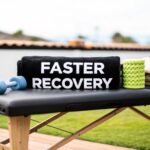
Think of a post workout massage less as a pampering session and more as a strategic part of your training plan. It's a powerful recovery tool specifically designed to tackle the physiological stress your body endures during intense exercise, helping you repair faster and perform better.
Why a Post Workout Massage Is a Recovery Game Changer
After you’ve pushed your limits, your muscles are in a state of disarray. They're filled with tiny micro-tears and the metabolic byproducts of intense effort. A targeted post workout massage is like bringing in a highly skilled clean-up crew to this "construction site." It methodically works to clear out the debris, restore order, and get your body primed for the next session.
This isn't just about feeling good in the moment; it's a deliberate intervention that supports recovery at a biological level. While sleep and hydration are foundational, more and more athletes and fitness lovers are realizing that targeted bodywork offers unique advantages.
It's a growing trend. In a recent survey of 3,000 people about their favorite recovery methods, nearly 10% named massage as their top choice. This shows a clear shift towards recognizing massage as a core component of a serious fitness routine.
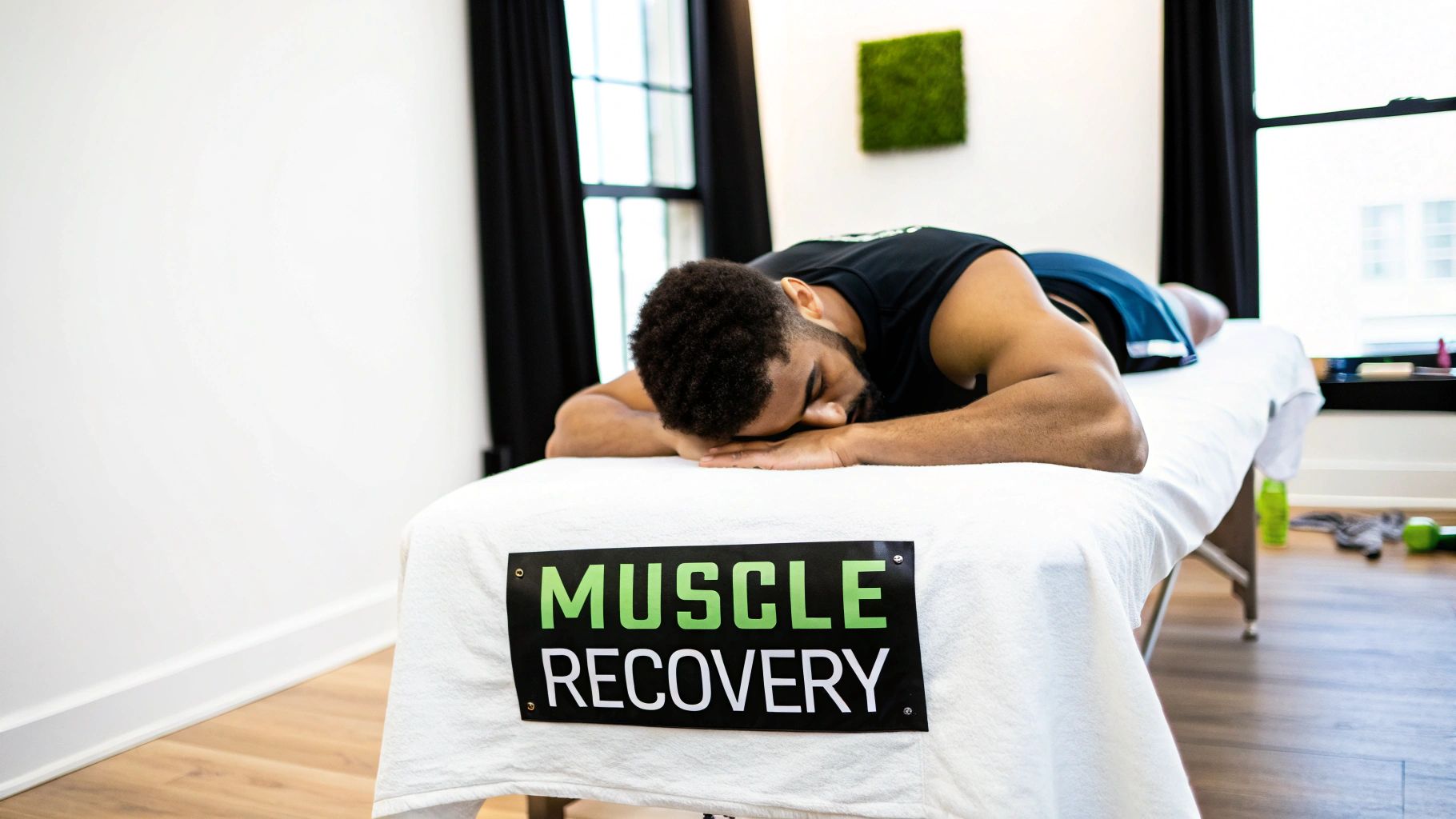
Key Objectives of a Recovery Massage
So, what exactly is a post workout massage trying to achieve? It’s far from random rubbing. The goals are very specific and tactical:
- Tackle Muscle Soreness: By boosting blood flow and helping to calm inflammation, it can significantly reduce that all-too-familiar Delayed Onset Muscle Soreness (DOMS).
- Improve Flexibility: Working through knots and tight spots helps restore your full range of motion, which is crucial for proper form and injury prevention in your next workout.
- Speed Up Muscle Repair: The massage techniques increase circulation, which is like opening up a superhighway for oxygen and nutrients to reach your tired muscles while efficiently escorting waste products like lactic acid out.
It's easy to lump all massages together, but that's a common mistake. A post workout session uses very different techniques than a general relaxation massage because its purpose is entirely different—it's all about addressing exercise-induced stress. To learn more, check out how sports massage therapy can be your recovery game changer.
Ultimately, building post workout massage into your schedule is an investment in your physical resilience and long-term athletic performance.
Post Workout Massage at a Glance
To put it all together, here’s a simple breakdown of what a post workout massage sets out to do and the benefits you can expect.
| Primary Goal | What It Targets | Expected Benefit |
|---|---|---|
| Accelerate Recovery | Sore, overworked muscles and connective tissues | Reduced DOMS, less stiffness, and quicker return to training. |
| Enhance Performance | Muscle knots, fascial restrictions, and limited mobility | Improved flexibility, better range of motion, and greater power output. |
| Prevent Injury | Imbalances, chronic tension, and areas of high stress | Healthier muscle tissue that is more resilient and less prone to strains. |
This table highlights that every aspect of the massage is intentional, aimed at helping you bounce back stronger and more prepared for whatever you take on next.
The Science: How Massage Actually Speeds Up Recovery
To really get why a post-workout massage works wonders, you have to peek under the hood at what’s happening to your muscles. Picture your healthy muscle fibers as perfectly aligned, organized strands. When you push through a tough workout, you're essentially creating tiny, microscopic tears in those fibers. This isn't a bad thing—it's the trigger for your body to start rebuilding them stronger.
That disruption and the body's natural repair response, however, are what bring on that all-too-familiar ache we call Delayed Onset Muscle Soreness, or DOMS. It’s the reason you feel great walking out of the gym but can barely get out of bed a day or two later. A good post-workout massage steps right into this process, acting like a highly skilled cleanup and repair crew for your muscles.
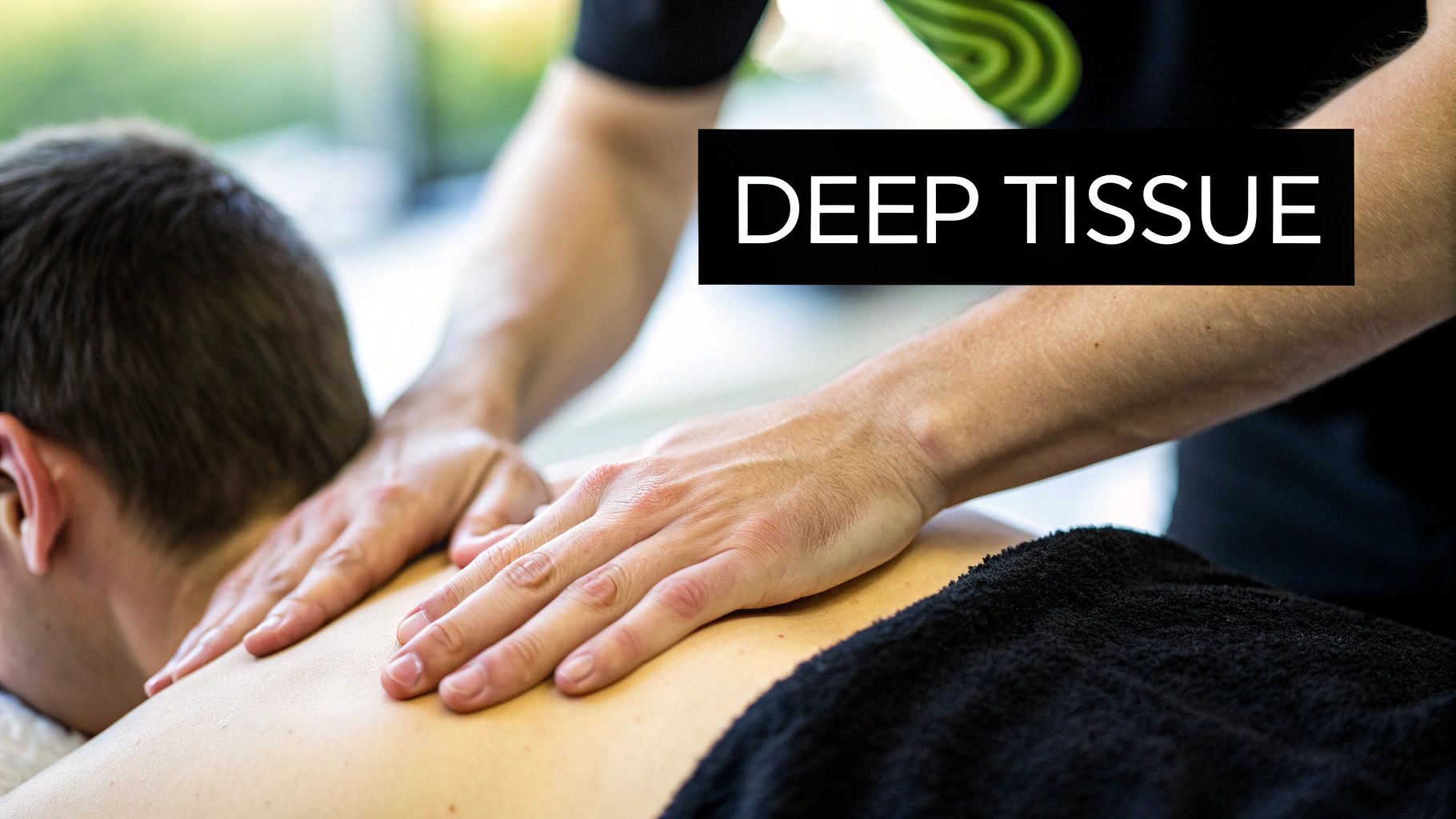
Boosting Circulation and Clearing Out the Junk
One of the biggest jobs of a recovery massage is to get your blood moving. The hands-on pressure from long, gliding strokes (effleurage) and kneading motions (petrissage) physically encourages better blood flow right where you need it most.
Think of it like this: after a hard workout, your circulatory system is like a highway jammed with the metabolic waste left over from exertion—things like lactic acid and other byproducts. Massage therapy is the traffic cop that clears the congestion and gets things flowing smoothly again.
This improved circulation is a two-for-one deal:
- It delivers the goods: Fresh, oxygen-rich blood carrying vital nutrients rushes to your tired muscles, giving them the building blocks they need to repair.
- It takes out the trash: At the same time, it more effectively flushes out all that metabolic junk that makes you feel sore and fatigued.
The bottom line? Your muscles spend less time feeling achy and weak, which means you can get back to training sooner and feel better prepared when you do.
A post workout massage does more than just relax you; it actively reconfigures the physiological environment within your muscles to favor rapid and efficient healing. It's a strategic tool for managing the natural, yet uncomfortable, aftermath of intense physical exertion.
Science backs this up. A major 2020 meta-analysis looked at 29 different studies and confirmed that massage gives athletes a real recovery advantage. While it didn’t show a huge impact on pure strength or endurance, it was found to improve flexibility and reduce DOMS by a significant 13%.
Calming Inflammation and Pain
Beyond just moving blood around, a post-workout massage helps dial down your body's inflammatory response. A little inflammation is a necessary part of the healing process, but too much of it for too long just leads to more pain and slower recovery. Massage helps keep that response in check.
Studies have shown that the physical pressure from a massage can actually signal your cells to produce fewer inflammatory proteins called cytokines. What's even cooler is that it also encourages your body to build more mitochondria—the tiny "power plants" inside your cells that are essential for energy and repair.
This means your body shifts its focus from being stuck in a painful, inflamed state to actively rebuilding stronger, more resilient muscle tissue. The hands-on work also directly soothes irritated nerve endings, which helps turn down the volume on the pain signals being sent to your brain. To see how specific techniques achieve this, our guide on the core benefits of sports massage is a great next read.
The Go-To Massage Techniques for Muscle Repair
Ever wondered what's actually happening on the massage table? Knowing the lingo and the techniques a therapist uses can make all the difference. Think of it like this: a massage therapist has a whole toolkit at their disposal, and each movement is a specific tool for a specific job.
We're going to break down the three big ones. Understanding these will help you communicate what you need, whether you're getting a professional massage or just working on yourself at home. It’s all about knowing why something feels the way it does.
Effleurage: The Warm-Up Strokes
The first thing you’ll almost always feel is Effleurage. These are those long, flowing, gliding strokes that kick things off and wrap them up. Picture a painter laying down the first coat of primer before getting to the detailed work—that's effleurage, getting your muscles ready for what’s to come.
The pressure is usually light to medium. The main goal here is to warm up the muscle tissue and get blood moving into the area. It’s a crucial first step that tells your nervous system to chill out, while also giving the therapist a chance to feel out your muscles and find those trouble spots. This technique feels especially amazing on big areas like your back, quads, and hamstrings.
Effleurage is more than just a gentle introduction; it's a diagnostic tool. A good therapist uses these first few strokes to read the map of your muscles, pinpointing the knots and tight spots that need more focused work later on.
Petrissage: Kneading Out the Knots
Once your muscles are warm and relaxed, the therapist will typically shift into Petrissage. This is where the real work begins. It involves a combination of kneading, squeezing, lifting, and rolling the muscle tissue. If effleurage was the primer, petrissage is like a sculptor working with clay—it’s much more hands-on and targeted.
So, what’s it actually doing? Petrissage is designed to:
- Release deep tension by lifting the muscle away from the bone.
- Flush out metabolic gunk by literally wringing out the muscles.
- Boost local circulation, bringing a fresh supply of oxygen-rich blood to help repair the tissue.
This kneading action is what really gets after those stubborn knots (or trigger points) that show up after a tough workout. It can feel incredibly satisfying, but don't be surprised if there's a little "good hurt" when they hit a particularly tight spot. It’s perfect for denser muscles like your calves, shoulders, and glutes.
The image below gives you a great visual on when to use these techniques for the best results.
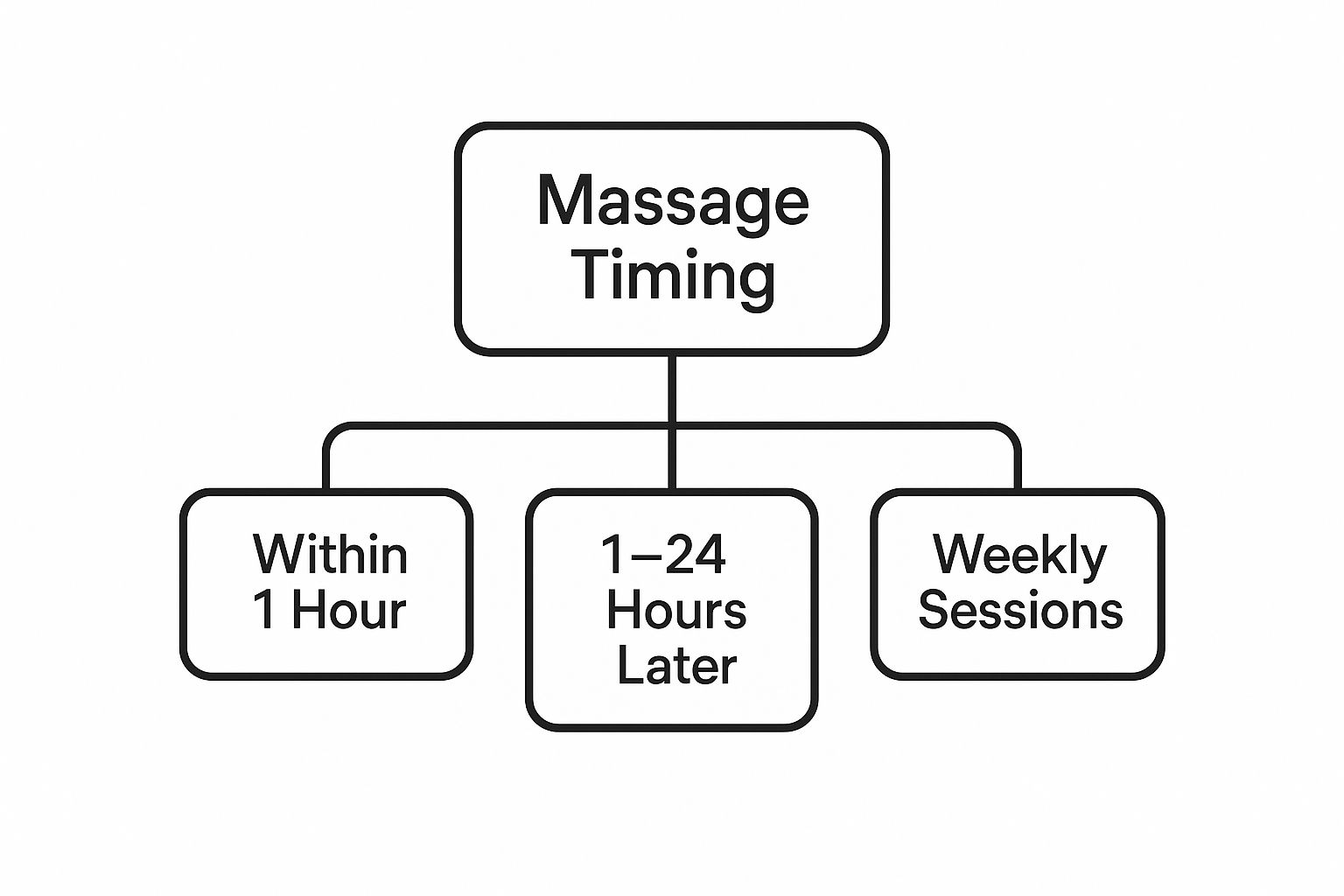
As you can see, timing is everything. Whether you get a massage right after your workout or make it a weekly ritual, when you do it plays a huge role in how much you get out of it.
Friction: Breaking Down the Tough Stuff
Last but not least, we have Friction. This is the most intense and laser-focused technique of the three. It involves deep, circular, or cross-fiber motions applied with thumbs, fingertips, or even elbows, right on a specific point of tension. Think of it as the specialist tool used to break down adhesions and scar tissue—those sticky, gummy spots in your muscles and fascia that just won't let go.
Friction generates heat and helps realign the tissue fibers, which is why it's so important for dealing with chronic tightness or old injuries. Because it's so precise, it’s used sparingly on very specific, small areas. It's the final touch that tackles the most stubborn problems.
If you want to dig a bit deeper into how all this comes together to help you heal, our full guide on massage for muscle recovery has even more detail.
Timing Your Massage for Maximum Impact
Getting a post workout massage is a fantastic move for your recovery, but when you get it can be just as important as the massage itself. It’s a bit like a construction crew repairing a road after a day of heavy traffic. You have to schedule them at the right time to get the job done right without causing more problems. The same idea applies to your muscles.
There's no single "best" time for everyone. Instead, it's about understanding two key windows where a massage can really work its magic. Choosing the right one all comes down to what you’re trying to accomplish with your recovery.
The Immediate Window for a Quick Flush
Your first opportunity is what I call the Immediate Window, which is in the first couple of hours right after you wrap up your workout. A massage during this time is all about damage control and kickstarting the cleanup process.
After you’ve pushed yourself hard, your muscles are swimming in metabolic waste. A lighter, more restorative massage at this stage acts like a super-efficient circulatory pump, helping to flush out all that gunk and bring in fresh, oxygen-rich blood. This can do wonders for stopping stiffness before it even starts.
Think of a massage in this window as less of a deep-tissue overhaul and more of a calming reset. Its main job is to soothe your nervous system, boost circulation, and give your muscles a head start on healing before serious soreness has a chance to set in.
This approach is perfect after a big race or a particularly brutal training session when you just want to get the recovery ball rolling immediately.
The Recovery Window for Deep Repair
The second, and arguably more popular, option is the Recovery Window. This is typically 24 to 48 hours after your workout, which is usually right when Delayed Onset Muscle Soreness (DOMS) decides to show up and say hello. A massage now isn't about a quick flush; it's about deep, focused repair work.
By this point, the initial inflammation is underway, and you can pinpoint exactly which muscles are screaming the loudest. This allows a therapist to go deeper and work on specific knots and tight spots more effectively, without aggravating tissues that were just put through the wringer. This is the prime time for a more intense session focused on releasing built-up tension and getting your mobility back.
So, how often should you be booking these appointments? The right frequency really hinges on your training load and what you're aiming for.
- Casual Gym-Goer (2-3 times/week): A monthly massage is a great maintenance plan. It helps manage general tightness and undo the everyday knots that accumulate over time.
- Dedicated Enthusiast (4-5 times/week): Bumping that up to every two or three weeks provides more consistent support. This can help you sustain your performance and stop minor aches from turning into nagging, chronic issues.
- Competitive Athlete (Training daily): For those training at a high level, a weekly massage is often a non-negotiable part of the regimen. This frequency allows for very targeted work on overworked muscles, which is crucial for preventing injuries and staying in peak condition.
At the end of the day, the best advice is to listen to your body. Whether you go for that immediate post-exercise flush or wait a day for a deep-tissue session, timing your massage with your training will elevate it from a simple treat to a powerful recovery weapon.
DIY Massage Tools vs. Professional Therapists
When it comes to post-workout recovery, you've got options. The big question often boils down to this: should you use your trusty at-home tools or book a session with an expert? Honestly, there’s a place for both. Think of it less as a competition and more about picking the right approach for what your body needs at that moment.
Everyday tools like foam rollers, massage balls, and percussion guns have exploded in popularity, and it’s easy to see why. They’re right there when you need them, they don't break the bank, and they are fantastic for daily maintenance. This is your first line of defense—the go-to crew for managing general muscle tightness in big areas like your quads, hamstrings, and back after a tough workout.
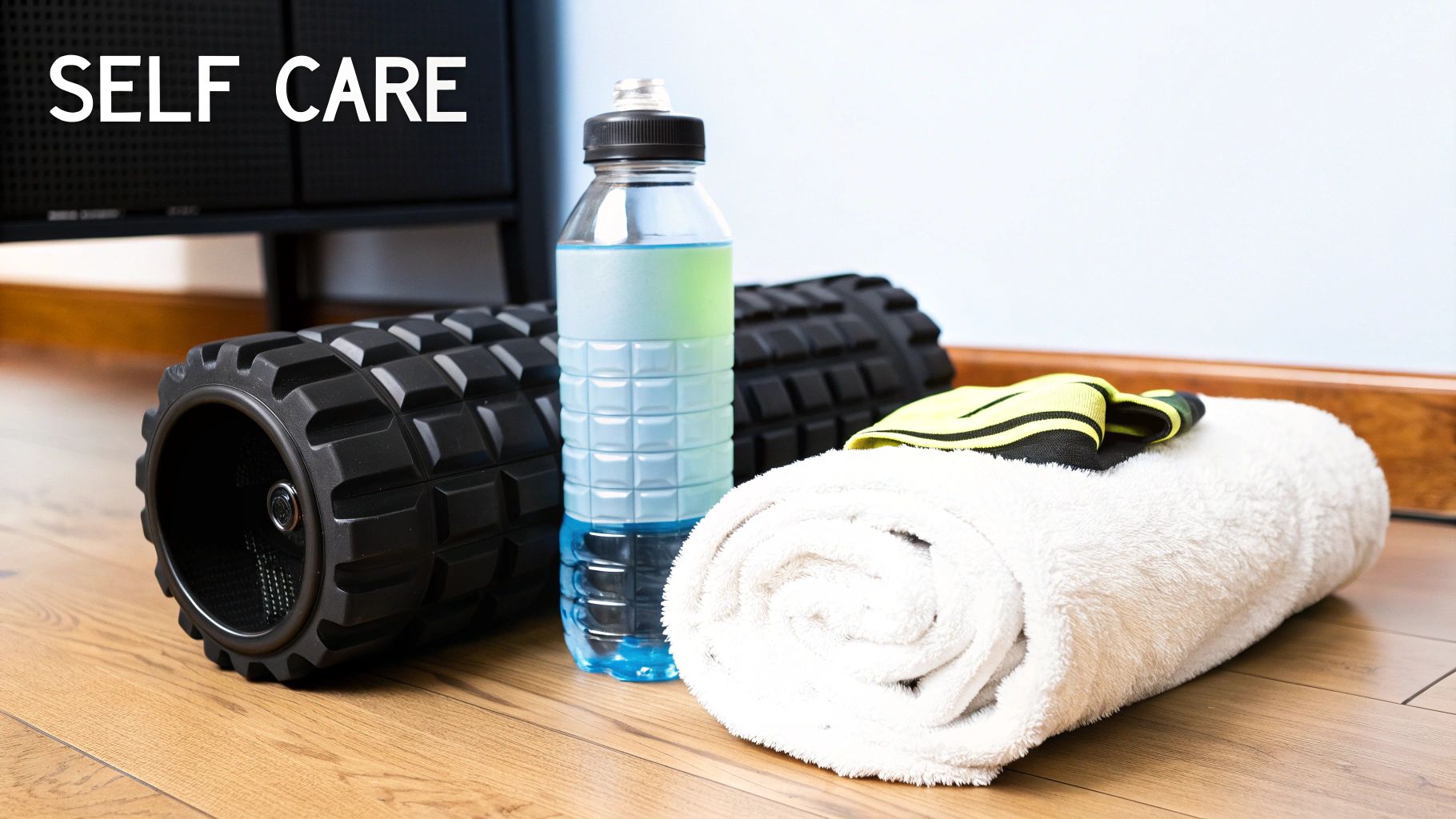
The Power and Limits of DIY Tools
There's no denying the immediate relief you get from buzzing your calves with a massage gun after a long run or grinding out a tight IT band on a foam roller. These tools are champions at improving circulation and tackling minor knots before they turn into major headaches. They keep you moving.
But here’s the catch: your expertise ends where your anatomical knowledge does. It's surprisingly easy to do more harm than good—pressing too hard, rolling over a sensitive joint or nerve, or completely missing the real source of your pain. That nagging hamstring tightness? It could easily be stemming from an imbalance in your glutes or lower back. A foam roller can’t tell you that.
When to See a Professional Therapist
This is precisely where a professional massage therapist comes in. A licensed therapist isn’t just applying pressure; they're bringing years of deep knowledge in anatomy, physiology, and specialized techniques to the table. They have a trained ability to "read" your muscles, pinpointing the root cause of chronic pain or imbalances you didn't even know you had.
A professional therapist isn’t just rubbing sore muscles; they’re performing a full-body assessment. They can diagnose complex issues, develop a truly personalized treatment plan, and apply techniques to release stubborn knots that DIY tools can't safely or effectively reach.
This kind of expert-led care is absolutely vital when you're dealing with a nagging injury, gearing up for a big competition, or just need a comprehensive reset that addresses your body's entire kinetic chain. And more people are realizing this value. The global body massage industry hit an estimated $66.6 billion in 2023 and is projected to almost double by 2030, a trend fueled by a greater focus on high-level recovery. You can dig into the numbers in this body massage market analysis.
So, what's the best strategy? It’s almost always a hybrid approach. Lean on your DIY tools for consistent, daily maintenance. But when you need to fix deeper issues, prevent injuries, or get an expert’s assessment, investing in a professional post-workout massage is one of the smartest things you can do for your body.
Got Questions About Post-Workout Massage? We've Got Answers.
Alright, so you're sold on the idea of post-workout massage. You get the benefits, you know the techniques. But when it comes to actually booking a session and showing up, a lot of practical questions can pop into your head. That's completely normal.
Getting straight answers to these common questions is key to walking into your appointment with confidence and getting the absolute most out of it. Let's clear up some of the most frequent uncertainties.
How Long Should My Massage Session Be?
This is a classic question, and the honest answer is: it depends entirely on what you're trying to achieve and how much attention your body needs. There's no magic number, but think of it in terms of focus.
A quick 30-minute session can be a lifesaver if you have one specific, screaming muscle group. Did a long run completely trash your quads and calves? Are your shoulders on fire after a heavy bench day? This shorter time frame lets a therapist zero in and provide concentrated relief exactly where you need it most.
For a more well-rounded approach, 60 minutes is the gold standard. This gives your therapist enough time to thoughtfully work through all the major muscle groups—your back, legs, arms, and glutes—without rushing. It's the go-to choice for general recovery and keeping your body in good working order.
Now, if you're a serious athlete, dealing with some major post-competition soreness, or have nagging chronic issues, a 90-minute session is where the real magic happens. That extra time allows for much deeper, more meticulous work on stubborn knots and problem areas, leading to more profound and lasting results.
Is This Supposed to Hurt?
This is probably the most important question we get, and the answer isn't a simple yes or no. A proper post-workout massage shouldn't be painful, but you will likely feel some discomfort. It’s what athletes and therapists often call a "good hurt."
Here’s the deal: you should feel effective, targeted pressure that’s working to release tight, knotted-up muscle tissue. What you should never feel is a sharp, stabbing, or unbearable pain. If you find yourself gritting your teeth or holding your breath on the table, that's your body's signal that the pressure is too much.
An experienced therapist lives for your feedback. Their goal is to coax your muscles into releasing tension, not beat them into submission. A little discomfort is a sign that they're hitting the right spots, but real pain is just counterproductive. Speak up!
Is It Okay to Work Out After a Massage?
I strongly advise against it. My rule of thumb is to avoid any strenuous exercise for at least 24 hours after a deep tissue or sports-focused massage. Think about what just happened: your muscles have been manually manipulated to relax, release built-up tension, and kickstart the repair process. You've essentially hit the "reset" button on your recovery.
Jumping right back into a heavy lifting session or an intense run is just asking for trouble. Your muscles might feel looser, but they are also less stable, which can mess with your form and seriously increase your risk of injury. The massage has started a recovery cycle, and you need to give your body time to complete it.
A gentle walk or some light, easy stretching later on? That's perfectly fine. In fact, it can even help by keeping things loose. But save the hard work for tomorrow.
What Should I Do After My Massage to Get the Best Results?
What you do in the hours after you get off the table is almost as important as the massage itself. To really lock in the benefits, make these three things your priority:
- Hydrate. Then Hydrate Some More: Seriously, drink plenty of water. Massage helps push metabolic waste out of your muscle tissues, and water is what flushes it all out of your system. Don't skip this.
- Take a Warm Soak: A warm bath with Epsom salts a few hours after your session is a fantastic follow-up. The heat and magnesium are a perfect combo for soothing any residual muscle soreness.
- Just Chill: Give your body a break. Let it absorb the therapeutic work you just invested in. Try to avoid alcohol, caffeine, or a heavy meal right away, as they can put extra stress on your system. Your body's mission is to heal, so get out of its way and let it do its job.
At La Moon Massage and Facial, our passion is helping athletes and fitness lovers recover faster so they can get back to doing what they love. Book your post-workout recovery session with us today and feel the difference that professional, targeted care makes.
Massage for Muscle Recovery A Complete Guide
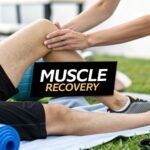
Feeling that deep, nagging ache in your muscles after a tough workout? You're not alone. The good news is that massage for muscle recovery isn't just about feeling pampered—it's a science-backed method to get you back in the game, faster. Think of it less as a luxury and more as a crucial part of your training toolkit.
Your Blueprint for Faster Muscle Recovery
When you push your body hard, you're creating tiny, microscopic tears in your muscle fibers. This is a good thing! It’s how you get stronger. But it’s also what causes that all-too-familiar pain known as Delayed Onset Muscle Soreness (DOMS). While rest is non-negotiable, adding an active recovery strategy like massage can make a world of difference in how quickly you bounce back.
Picture the inflammation after a workout as a massive traffic jam on a highway. This gridlock slows down the delivery of oxygen and nutrients your muscles desperately need to repair themselves, while also trapping the metabolic waste that makes you feel sore. Massage acts like an expert traffic cop, manually clearing the congestion and getting everything flowing smoothly again. It's a direct, hands-on intervention in your body's own healing process.
Beyond Relaxation: A Therapeutic Tool
It’s easy to dismiss massage as just a way to relax, but for anyone serious about their fitness, it's a strategic part of a smart training plan. When you get a massage, you're not just passively waiting for the pain to go away; you're actively helping your body heal.
The science backs this up. A landmark 2017 review confirmed that massage therapy is highly effective at reducing DOMS. More than that, it helps you hold onto your muscle strength and lowers levels of creatine kinase—a key marker of muscle damage. That means your muscles aren't just feeling better, they're genuinely recovering faster. For a deep dive into the research, you can explore the full study on massage and muscle soreness on frontiersin.org.
Massage therapy doesn’t just cover up the pain. It’s sending real signals to your body to kickstart repair, dial down inflammation, and get your muscles working properly again.
To really grasp the power of massage, let's break down the key benefits you can expect. This table summarizes how massage works on a scientific level and what that means for you in practical terms.
Key Benefits of Massage for Recovery at a Glance
| Benefit | Scientific Mechanism | Practical Outcome |
|---|---|---|
| Pain & Soreness Reduction | Decreases pro-inflammatory cytokines & breaks down muscle adhesions. | You feel less stiff and achy, allowing you to move more freely and comfortably after training. |
| Enhanced Blood Flow | Mechanical pressure increases circulation to targeted muscle tissues. | More oxygen and nutrients are delivered to damaged muscles, accelerating the repair process. |
| Improved Flexibility | Reduces fascial restrictions and lengthens tight muscle fibers. | Your range of motion improves, helping prevent future injuries and improving your form. |
| Faster Waste Removal | Stimulates the lymphatic system to drain metabolic byproducts. | Cellular waste like lactate is flushed out more efficiently, reducing fatigue and soreness. |
Ultimately, a consistent massage routine leads to better performance, a lower risk of injury, and a more sustainable fitness journey.
What You Can Expect
Making massage for muscle recovery a regular part of your routine brings several key advantages that build on each other over time. Here’s what you’re working toward:
- Reduced Soreness and Stiffness: Massage gets right into those knots and tight spots, breaking up adhesions and releasing tension. The result is better range of motion and less pain when you move.
- Enhanced Blood Circulation: The physical pressure from massage is fantastic for boosting blood flow, ensuring that nutrient-rich blood gets to your tired muscles where it’s needed most.
- Faster Waste Removal: It also gives your lymphatic system a nudge, helping it flush out all the metabolic junk that builds up after a hard session.
In the end, it’s all about shortening your downtime. By recovering more efficiently, you can train harder and more often, making massage a true investment in your physical well-being.
The Science of How Massage Heals Your Muscles
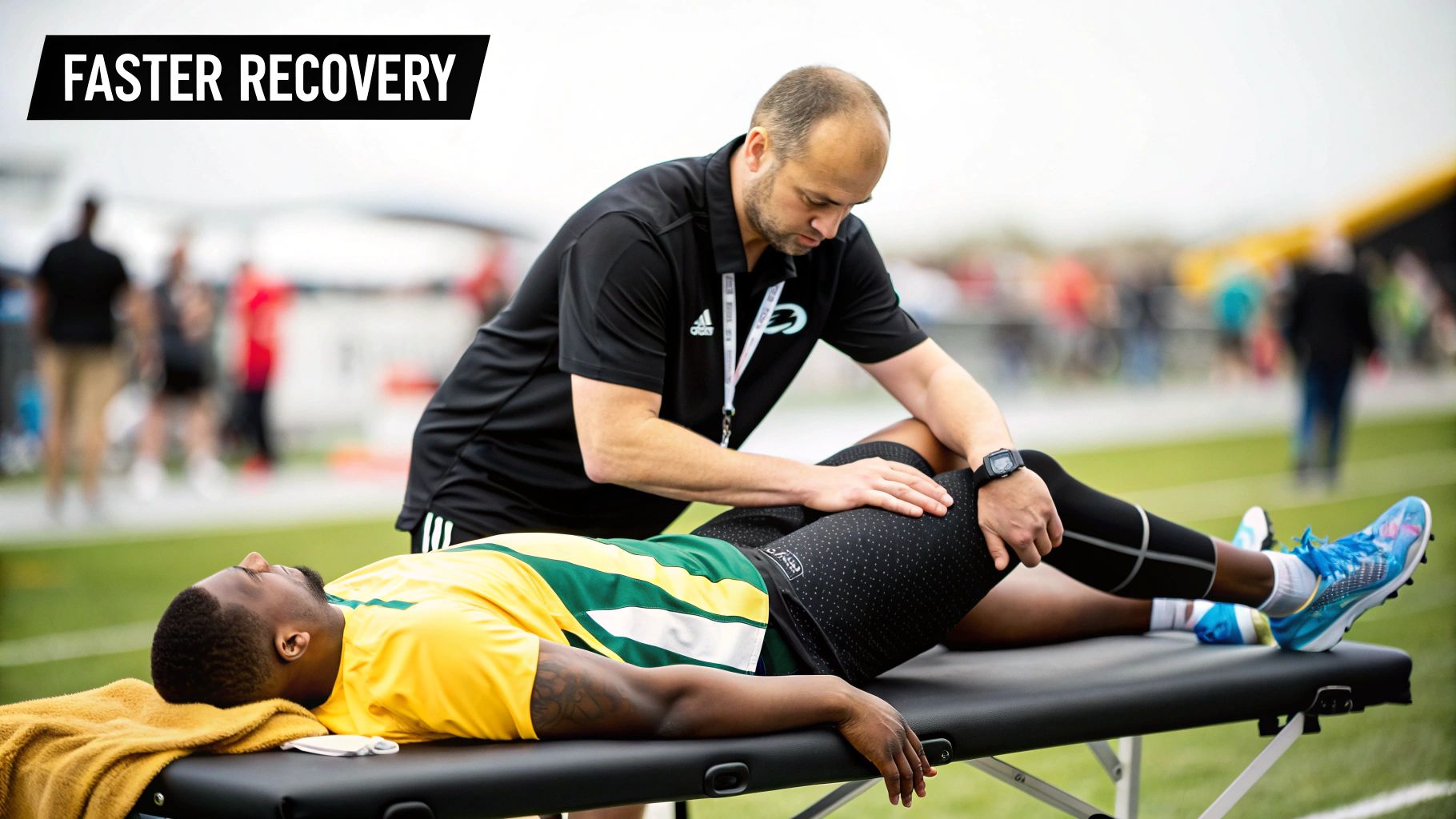
Have you ever wondered what’s really going on inside your muscles during a recovery massage? It feels great, sure, but the magic runs much deeper than just relaxation. It’s a full-blown biological process, and to get a handle on it, let’s think of it this way.
Picture the inflammation after a tough workout as a massive traffic jam on the busiest highway in town. This microscopic gridlock traps inflammatory cells and metabolic junk, blocking the vital resources—like oxygen and nutrients—that your damaged muscle fibers are desperate for. A good massage therapist acts like an expert traffic controller, manually breaking up that congestion and getting everything flowing smoothly again.
This whole process is a form of mechanotherapy, which is just a technical way of saying that physical force can trigger cellular responses. The pressure, kneading, and stretching of a massage sends direct signals to your muscle cells, essentially telling them to switch from a state of distress to one of active repair.
Flushing Out Inflammation and Waste
One of the first things a massage does is get your body's fluids moving. The hands-on manipulation of muscle tissue mechanically pushes blood and lymph along, which gives you two huge wins for recovery.
First, it fires up your circulation. This isn't just a feeling of warmth; it's a real, measurable increase in oxygen-rich blood flowing to your exhausted muscles. This fresh supply of oxygen and nutrients is the exact fuel your muscles need to rebuild damaged fibers.
Second, it kick-starts your lymphatic drainage. Think of your lymphatic system as your body's sanitation crew, clearing out metabolic byproducts and cellular debris. Unlike your circulatory system, which has the heart as a pump, the lymphatic system relies on muscle contractions to move things along. A massage is like giving this system a powerful, passive boost, helping to flush out the gunk that makes you feel sore and tired.
Reducing Inflammatory Signals at the Source
But it's not just about moving fluids. Massage gets even more specific, changing your body’s chemistry right at the cellular level. After intense exercise, your body launches an inflammatory response, sending immune cells to the site of muscle damage.
While a little inflammation is a normal part of healing, too much of it can drag out soreness and slow down your recovery. This is where massage really makes its mark. The mechanical pressure on your muscles has been shown to actively dial down the production of inflammatory messengers called cytokines.
By calming this inflammatory storm, massage helps shift your muscles from a state of damage control to one of active regeneration. It’s a direct biological intervention that speeds up your body's natural healing timeline.
We're not just guessing here. Recent research from Harvard's Wyss Institute painted a clear picture of how this works. They found that mechanical stimulation, like the pressure from a massage, literally squeezes inflammatory immune cells (called neutrophils) out of the muscle tissue. This not only clears the path for repair but also reduces those inflammatory cytokines, leading to faster muscle fiber regeneration and improved strength. You can dive into the compelling evidence about this direct biological effect of massage on harvard.edu.
This discovery really explains why massage for muscle recovery is so effective at cutting down pain and getting you back to peak performance faster.
From Biology to Practical Benefits
When you understand the science, it's easy to see how what happens on the massage table translates to your performance. Those biological shifts in your muscles create real-world benefits you can actually feel.
- Less Pain and Stiffness: By reducing inflammation and flushing out waste, massage targets the root causes of that dreaded Delayed Onset Muscle Soreness (DOMS).
- Improved Tissue Health: Breaking down knots and adhesions (those "trigger points" you hear about) helps restore normal function and flexibility to the muscle and the fascia around it.
- Accelerated Repair: By creating the perfect healing environment—rich in nutrients and free of inflammatory roadblocks—your muscle fibers can regenerate more efficiently.
These effects are particularly noticeable with targeted approaches like sports massage. If you're an athlete or just train hard, learning about the key benefits of sports massage can help you find a therapy that’s perfectly suited to your recovery goals.
In the end, the science confirms what athletes have known for years: massage isn't just an indulgence. It’s a powerful, legitimate therapeutic tool that works with your body’s own healing systems to help you recover faster, feel better, and build stronger, more resilient muscles.
Choosing the Right Massage for Your Recovery Goals
When it comes to muscle recovery, not all massages are created equal. You wouldn't use a hammer to turn a screw, right? The same logic applies here. Picking the right type of massage is the single most important factor in getting the results you’re looking for, whether that's soothing general aches or tackling a deep, stubborn knot.
Think of it this way: a light, flowing massage might feel incredible for calming your mind and easing everyday soreness, but it won't do much for the dense adhesions that build up after weeks of heavy lifting. Knowing the difference between the techniques is what empowers you to get a therapy that truly matches what your body needs.
Let’s break down the most effective massage styles for muscle recovery so you can walk into your next session with confidence and get the best possible outcome.
Swedish Massage: The Classic for General Relaxation
When most people picture a massage, they’re usually thinking of a Swedish massage. It’s the cornerstone of most Western massage practices, beloved for its ability to melt away stress and ease that general, all-over muscle tension.
The therapist uses long, gliding strokes (effleurage), gentle kneading (petrissage), rhythmic tapping (tapotement), and friction to warm up the muscle tissue. The pressure is typically light to medium, so it’s more about boosting circulation and calming the nervous system than digging into deep knots.
Choose Swedish massage when your main goal is to de-stress and soothe mild muscle soreness after a moderate workout. It’s the perfect introduction if you’re new to getting massages for recovery.
Deep Tissue Massage: For Chronic Tension and Knots
If your soreness feels deep, persistent, and located in specific trouble spots, deep tissue massage is probably what you need. This technique gets right into the deeper layers of muscle and connective tissue to break down adhesions—what we all call "knots"—that cause pain and limit how well you can move.
The strokes are much slower and the pressure is significantly firmer than a Swedish massage. Therapists often use their forearms, elbows, and even knuckles to apply that focused pressure needed to release chronic muscle tightness. It can feel intense—that "good hurt"—but it should never be unbearable. Always speak up if the pressure is too much.
- Best For: Working out stubborn knots, addressing chronic pain in areas like the lower back or neck, and relieving severe muscle tightness.
- Experience: Expect focused, intense pressure that targets specific tight spots. It’s less about relaxation and more about therapeutic release.
Sports Massage: The Athlete’s Go-To for Performance
As the name suggests, a sports massage is tailored specifically for athletes. It’s not just a single technique but a smart blend of different methods, including deep tissue work, assisted stretching, and targeted compression, all designed around the demands of your particular sport. The main goals are to prevent injuries, prime the body for competition, and slash recovery time.
A sports massage can be done before an event to warm up muscles or, more commonly, after to help flush out metabolic waste and repair the micro-tears that come from intense effort. In fact, one study from the Journal of Athletic Training found that a post-workout massage can reduce the intensity of delayed onset muscle soreness (DOMS) by about 30%. For someone like a runner, this kind of targeted work is a game-changer. You can find out more about how a sports massage for runners can boost recovery and help prevent injuries.
To help you decide, think about what your body is craving right now.

As you can see, starting with your personal preference for intensity—gentle versus forceful—is a great first step to narrowing down your options.
Here is a quick comparison to help you choose the best massage style based on your recovery goals.
Comparing Massage Techniques for Muscle Recovery
| Massage Technique | Best For | Pressure Level | Primary Focus |
|---|---|---|---|
| Swedish | General relaxation, stress relief, mild soreness | Light to Medium | Calming the nervous system, improving circulation |
| Deep Tissue | Chronic pain, stubborn knots, severe tightness | Firm to Deep | Releasing adhesions in deep muscle layers |
| Sports Massage | Injury prevention, performance enhancement, faster recovery | Varies (can be deep) | Preparing muscles for and recovering from athletic activity |
| Myofascial Release | Restoring mobility, releasing connective tissue tightness | Gentle and Sustained | Stretching and releasing the fascial web |
This table serves as a handy cheat sheet, but remember to listen to your body and communicate with your therapist to find the perfect fit.
Myofascial Release: Targeting the Connective Tissue
It’s easy to forget, but your muscles don't exist in a vacuum. They are wrapped in fascia, a thin but incredibly strong web of connective tissue that surrounds every muscle, bone, and organ in your body. When this fascial web gets tight from injury, overuse, or even sitting too much, it can tug and pull, causing pain and seriously limiting your range of motion.
Myofascial release is a specialized technique designed to address this very issue. It involves applying gentle, sustained pressure to these tight spots. Unlike other massages that glide over the muscles, the therapist will sink into the tissue and hold the pressure, waiting for the fascia to slowly stretch and release.
It’s a subtle yet profound technique that can unlock movement and get rid of pain that traditional muscle work just can't seem to touch.
Soreness vs. Function: What a Massage Actually Does for Recovery

After you've pushed your body to its limits, the goal is pretty straightforward: feel better, and get back to training as soon as you can. Massage is one of the most popular tools for this, but to get the most out of it, you need to understand what it's really doing under the surface. It's all about the difference between how you feel and how your muscles can actually perform.
Let’s be clear: when it comes to tackling Delayed Onset Muscle Soreness (DOMS)—that all-too-familiar ache that sets in a day or two after a tough workout—massage is a true powerhouse. It's incredibly effective at dialing down that perception of pain and making you feel more mobile and comfortable in your own skin.
But here’s the key distinction: feeling less sore isn't the same as having your muscles back at 100% strength. Understanding this is crucial for setting the right expectations for your recovery.
How You Feel vs. How You Perform
Think of your recovery as having two distinct tracks. One track is how your body feels (your level of soreness and stiffness). The other track is how it performs (its ability to produce force and power). A recovery massage has a massive, almost immediate impact on that first track. The second one? Not so much.
This isn't just a hunch; solid research backs it up. A major 2005 review of multiple studies discovered that while post-exercise massage did a fantastic job of reducing the severity of DOMS, it had no significant effect on restoring muscle strength or function right away. For a deeper dive, you can explore the key distinction in massage benefits on pubmed.ncbi.nlm.nih.gov.
So what does this mean for you? You can walk out of your massage appointment feeling like a new person—limber, loose, and pain-free—but your muscles are likely still in a weakened, rebuilding state. Trying to go for a new deadlift PR right after your session is probably not the wisest move.
The primary, immediate benefit of a recovery massage is alleviating pain and improving your quality of movement. The restoration of maximum strength is a separate biological process that still requires time.
So, Why Does Feeling Better Matter So Much?
If a massage doesn't instantly bring back your peak power, what’s the point? It’s simple: by making you feel better, it creates the perfect environment for your body to carry out a faster and more effective recovery on its own.
Getting rid of soreness isn't just about comfort. When you aren't wincing from pain and stiffness, you can actually do the things that help you heal, like light stretching or a gentle walk. Your sleep quality also tends to improve dramatically, and that's when the real magic of muscle repair happens.
Here’s how it helps:
- Better Movement: By easing stiffness, massage helps you move correctly in the days following a workout. This prevents you from developing weird, compensatory movement patterns that can easily lead to an injury down the road.
- A Mental Boost: Let's face it, being in constant pain is draining. Feeling better provides a huge psychological lift, keeping you motivated and on track with your training schedule.
- Easier Active Recovery: You're far more likely to go for that recovery walk or do a light mobility session when your body doesn't scream in protest. These activities are vital for boosting circulation and speeding up the healing process.
Think of massage as a bridge. It takes you from that grueling post-workout state back to peak condition by making the journey much smoother and more pleasant. It might not be an instant strength button, but it lays the groundwork for your muscles to rebuild properly, getting you back in the game faster and with less risk.
How to Time Your Massage for Peak Recovery
To get the most out of a massage for muscle recovery, timing is everything. It’s a bit like planning your workouts—if you do it strategically, you’ll see much better results. Getting a massage isn’t just about booking a session whenever you feel sore; it's about syncing it up with your body’s own healing schedule.
Think of it this way: using the right massage at the right time is like giving your body the perfect tool for the job. A session meant to warm you up before a race is completely different from one designed to help you recover afterward. Getting this distinction right helps you build a routine that truly speeds up your progress.
Let’s break it down into the two main scenarios: pre-event and post-event massage.
The Pre-Event Massage: Prime and Prepare
A pre-workout massage isn't about deep, relaxing work. In fact, its goal is the exact opposite: to stimulate and awaken your muscles, not turn them into jelly. These sessions are usually shorter, faster-paced, and use invigorating techniques like brisk strokes and light, dynamic stretching.
The main goals here are pretty straightforward:
- Boost blood flow to the muscles you're about to put to work.
- Improve mobility and flexibility in your key joints.
- Fire up the nervous system to get your body ready for action.
Essentially, it's a wake-up call for your body. The ideal time for this is anywhere from 30 minutes to 24 hours before your competition or intense workout. This is definitely not the time for deep tissue work, which can leave muscles tender or too relaxed and might actually get in the way of your performance.
The Post-Event Massage: Recover and Repair
This is what most of us picture when we think about recovery massage. After you’ve pushed your body to its limits, the focus flips entirely to healing and repair. A post-event massage is slower, more deliberate, and designed to calm the nervous system while dealing with the fallout from intense effort.
The sweet spot for a post-event massage is within 24 to 48 hours after your workout. This is when Delayed Onset Muscle Soreness (DOMS) usually rears its ugly head. Getting a massage in this window can make a huge difference in how sore you feel by flushing out inflammatory byproducts and sending fresh, oxygenated blood to your tired tissues.
The real purpose of a post-workout massage is to jumpstart the healing process. By scheduling it in that 24-48 hour window, you're actively stepping in to reduce inflammation and accelerate your body's natural repair cycle.
While that immediate post-workout massage is great for tackling acute soreness, consistent care is what really matters for your long-term athletic health.
Building a Sustainable Massage Schedule
So, how do you fit massage into your regular training plan? The right frequency really comes down to your training intensity, how your body responds, and, of course, your budget.
Here’s a simple guide for different fitness levels:
-
The Competitive Athlete: If you’re training hard almost every day, a weekly massage is practically a necessity. It helps manage the constant stress on your body, catches minor issues before they become major problems, and keeps you in peak condition. It’s a core part of any serious recovery protocol.
-
The Consistent Gym-Goer: For those who hit the gym hard 3-5 times a week, a bi-weekly or monthly massage is a fantastic rhythm. This is frequent enough to work out the knots and tightness that build up from regular training, helping you stay mobile and break through plateaus.
-
The Weekend Warrior: If your activity is less frequent but still intense—like long weekend hikes or pickup basketball games—scheduling a massage a day or two after is perfect. You can also just book a session as needed whenever you feel particularly stiff or sore.
At the end of the day, consistency is the name of the game. A regular massage, even just once a month, will do more for you than a few random sessions here and there. It gives your therapist a chance to learn your body’s patterns and helps you manage your muscle health proactively instead of just reacting to pain. And when injuries do happen, this foundation of care can be a game-changer. To learn more about this, see how a focused massage for sports injuries can fit into a complete recovery strategy.
Your At-Home Massage and Recovery Toolkit
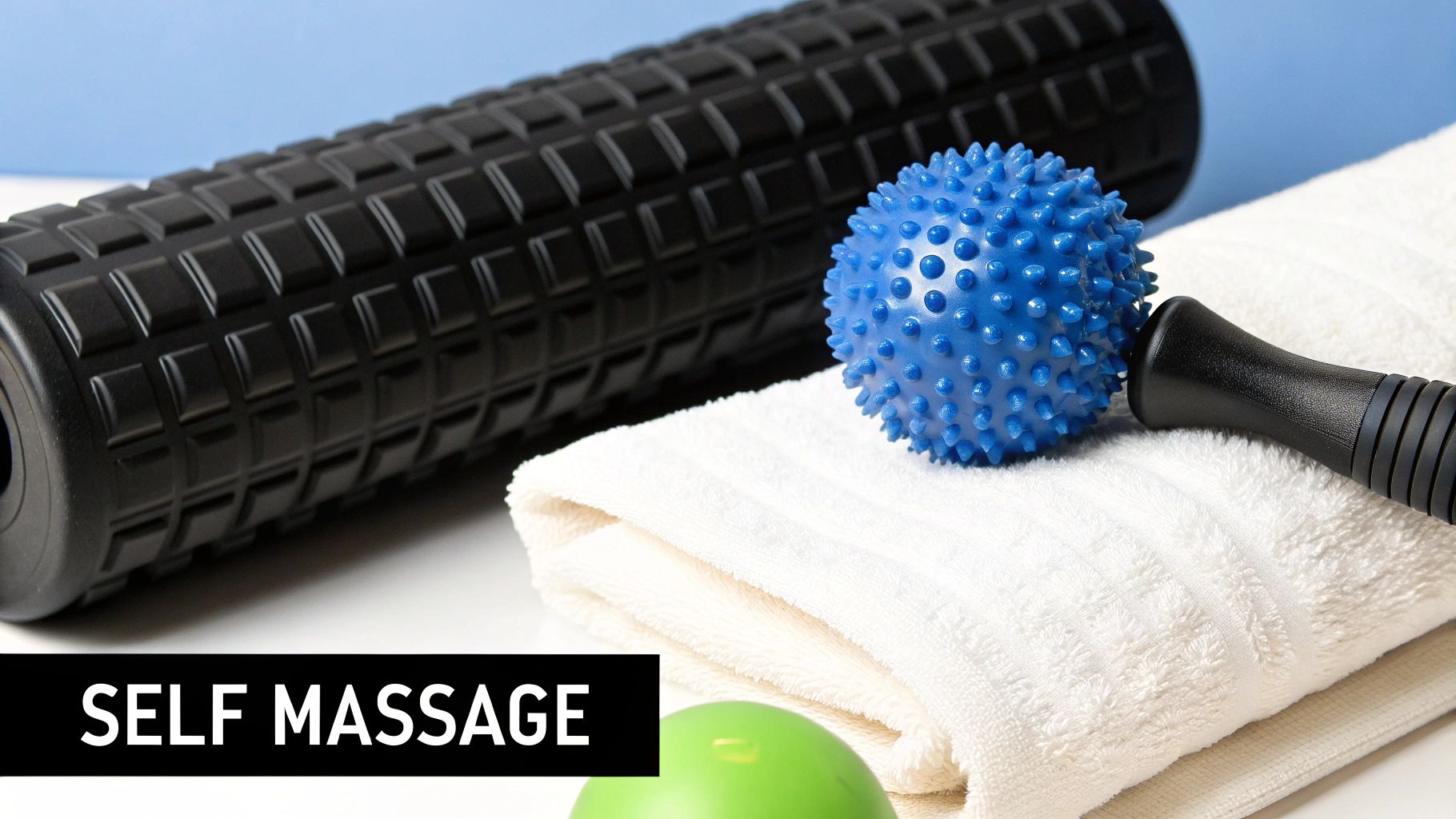
While nothing quite replaces the hands of a skilled massage therapist, getting a professional massage isn't always practical for day-to-day soreness. The good news is you can build a fantastic at-home toolkit to manage tightness and speed up muscle repair between sessions. These tools put the power of recovery right in your hands.
Think of it like having a set of specialized wrenches for your body. Each tool has a specific job, and knowing how to use it correctly is the key to getting real benefits without accidentally making things worse. When you get the technique right, you’ll get so much more out of your massage for muscle recovery at home.
This DIY approach is also a smart, budget-friendly way to stay on top of your muscle health. Let’s dive into some of the most effective self-massage tools and how to use them.
Foam Rollers: The Foundation of Self-Myofascial Release
The foam roller is probably the most famous recovery tool out there, and for good reason. It’s the perfect workhorse for large muscle groups like your quads, hamstrings, calves, and back. By using your own body weight to roll slowly across the foam, you apply broad, sweeping pressure that helps loosen up tight fascia and improve circulation.
If you imagine your muscles are a rope with big, general tangles, the foam roller is what helps smooth them out. It's the ideal starting point for any self-massage routine, prepping the tissue for more detailed work.
- Best For: Large muscle groups like the quadriceps, glutes, hamstrings, and upper back.
- Technique Tip: Keep your movements slow and intentional. When you find a tender spot, pause on it for 20-30 seconds and just breathe. Let the muscle relax and release. Just be sure to avoid rolling directly over your joints or the sensitive curve of your lower back.
Massage Guns: Percussive Therapy for Deep Relief
Massage guns use what’s called percussive therapy, delivering rapid, focused pulses deep into your muscle tissue. This is an incredible way to break up stubborn knots and drive blood flow to a very specific spot. It’s the closest you can get to having a deep-tissue specialist on call 24/7.
A massage gun gives you the precision to go after those deep, persistent knots with an intensity that’s tough to replicate by hand. It’s a serious investment in targeted, effective recovery.
These tools are powerful, so you need to handle them with care. Always start on the lowest setting to see how your body responds and stay away from bony areas, your neck, and your spine. The gun does the work for you—there's no need to jam it into the muscle.
Lacrosse Balls for Pinpoint Accuracy
For that one tiny, nagging knot that a foam roller just glides over, a lacrosse ball is your secret weapon. Its small size and unyielding surface make it perfect for trigger point therapy, which is all about applying steady, focused pressure to a single tight spot until it lets go.
- Best For: Zeroing in on knots in smaller or hard-to-reach places like the shoulders (traps), deep glutes (piriformis), the bottoms of your feet (plantar fasciitis), and chest muscles.
- Technique Tip: Trap the ball between your body and a wall or the floor. Gently lean your weight into it. When you hit a tender spot, hold that pressure and take a few deep breaths. You’ll feel the tension start to melt. It's a deeply satisfying release that bigger tools just can't provide.
Got Questions About Massage for Recovery? We’ve Got Answers.
Even once you’re sold on the benefits, figuring out the how and when of recovery massage can be tricky. Nailing down these details is what separates a good recovery routine from a great one. Let’s dive into some of the most common questions we hear from athletes and fitness lovers just like you.
How Soon After a Workout Should I Get a Massage?
The sweet spot for a recovery massage is typically within 24 to 48 hours after a tough workout. This is right when Delayed Onset Muscle Soreness (DOMS) usually rears its ugly head.
Getting a massage during this window helps tackle that soreness head-on. It gets blood flowing to your tired muscles and helps flush out the inflammatory stuff that makes you feel so stiff and achy.
Should a Recovery Massage Hurt?
Let's talk about pain. A good therapeutic massage, especially deep tissue or sports massage, can definitely feel intense. Many people call it a "good pain"—that satisfying feeling of a knot finally releasing.
But it should never be agonizing.
The whole point is to relieve tension and break up those stubborn muscle adhesions, not to cause more damage or leave you covered in bruises. Always, always talk to your therapist. If the pressure moves from uncomfortable to genuinely painful, that's your body's signal to back off.
How Do I Know When I Need a Recovery Massage?
Your body is pretty good at telling you what it needs. A massage is probably a great idea if you're dealing with:
- Soreness that sticks around and makes it hard to move normally.
- A deep, unshakeable stiffness that stretching just isn't touching.
- That heavy, leaden feeling in your muscles long after you’ve finished training.
It's also a smart move to book a massage proactively when you're ramping up your training. Think of it as preventative maintenance to keep your muscles healthy and sidestep injuries before they happen.
Ready to make professional massage therapy a core part of your recovery plan? The experts at La Moon Massage and Facial are here to help you reduce soreness and get back to peak performance. Book your recovery session today!
Massage for Sciatic Nerve Pain That Actually Works
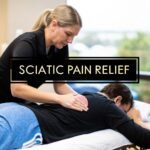
When that sharp, radiating pain of sciatica hits, finding relief becomes your one and only priority. So, can massage actually help? The answer is a resounding yes. Targeted massage therapy is a remarkably effective, non-invasive way to find real comfort from that debilitating pain. It works by getting deep into tight muscles, boosting circulation, and soothing the irritated nerve itself.
Does Massage Really Help Sciatic Nerve Pain?
It's important to remember that sciatica isn't a diagnosis on its own—it's a symptom of something else going on. Most of the time, it means the sciatic nerve is being compressed or irritated somewhere along its path. This nerve is the longest one in your body, starting in your lower back and running down through your hips, buttocks, and into each leg. When something pinches it, you get that infamous shooting pain, numbness, or tingling that can make life miserable.
While the root cause can be serious issues like a herniated disk, very often the culprit is much simpler: tight muscles. This is precisely where a skilled massage therapist can make a world of difference. We're not talking about a general relaxation massage; this is a focused, therapeutic approach aimed directly at the source of the problem.
Getting to the Muscular Root of the Pain
Therapeutic massage zeroes in on the specific muscles that are likely squeezing the sciatic nerve. The usual suspects? The piriformis muscle, buried deep in the buttocks, and the surrounding gluteal muscles. When these get wound up with tension or develop painful knots (trigger points), they can put direct pressure on the sciatic nerve, creating symptoms that feel identical to "true" sciatica from a disc issue.
This is how massage brings relief:
- Unlocks Muscle Tension: A therapist uses techniques like deep tissue massage to apply firm, sustained pressure. This breaks up the chronic knots in the piriformis and glutes, literally taking the pressure off the nerve.
- Boosts Healing Circulation: By improving blood flow, massage helps carry away the inflammatory byproducts that cause pain and brings in fresh, oxygenated blood to promote healing.
- Soothes the Nervous System: The physical manipulation helps calm the compressed nerve, reducing its sensitivity. It also triggers the release of endorphins—your body’s own powerful, natural painkillers.
Before we dive into the techniques, let's quickly summarize how massage therapy directly tackles the common complaints of sciatica.
How Massage Addresses Sciatica Symptoms
This table provides a quick look at common sciatica symptoms and the corresponding ways massage can provide targeted relief.
| Common Sciatica Symptom | How Massage Provides Relief |
|---|---|
| Sharp, shooting leg pain | Releases muscle knots (like in the piriformis) that directly compress the nerve. |
| Lower back ache and stiffness | Eases tension in surrounding lower back and gluteal muscles, improving flexibility. |
| Numbness or tingling | Increases blood flow to the area, which can help restore normal nerve function and sensation. |
| Pain when sitting or standing | Frees up tight hip and glute muscles, reducing the pressure that triggers pain in these positions. |
As you can see, the relief isn't just a coincidence; it's a direct result of addressing the muscular component of the pain.
Research backs this up. A 2014 study, for example, found that deep tissue massage was as effective as common anti-inflammatory drugs for relieving the type of low back pain often linked to sciatica. You can find out more about these massage therapy findings and what they mean for your recovery.
Ultimately, massage gives you a way to manage sciatica by tackling muscular imbalances head-on. By relieving that constant pressure on the nerve, it offers a path not just to feeling better for a few hours, but to gaining lasting comfort and improved mobility. It really can be a cornerstone of a smart pain management plan.
Finding the Right Massage for Your Sciatica
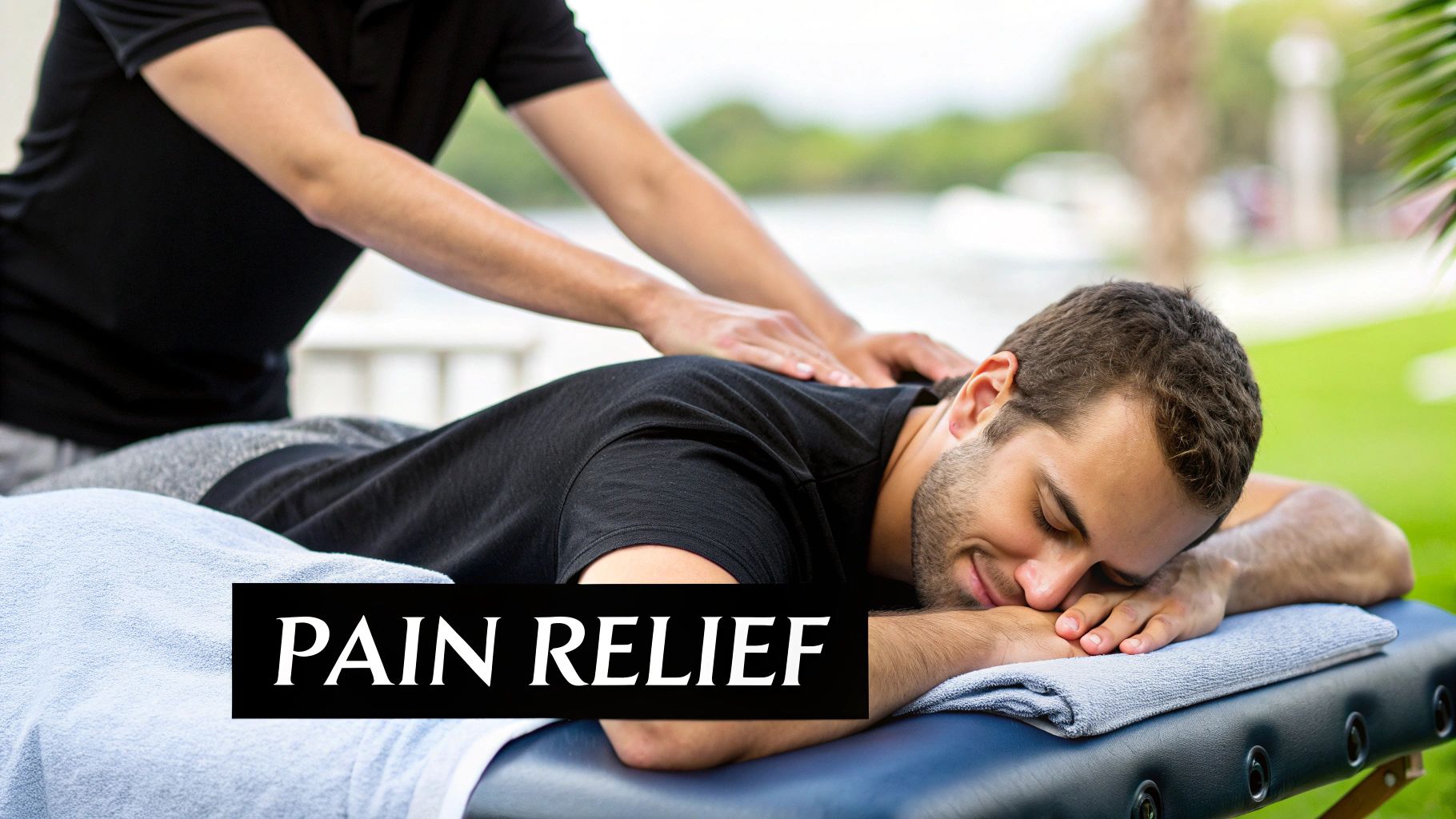
When you’re dealing with the unmistakable, searing pain of sciatica, you quickly learn that not all massages are the same. A gentle, relaxing Swedish massage might feel nice, but it probably won’t get deep enough to touch the real source of the problem. To find genuine relief, you need to look at specific techniques designed to release the stubborn muscle tension that’s putting pressure on your sciatic nerve.
The key to an effective massage for sciatic nerve pain is moving beyond surface-level work. The goal is to reach those deep, underlying muscles—particularly the piriformis and glutes—which are notorious for compressing the sciatic nerve and causing all that misery.
Deep Tissue Massage for Stubborn Knots
From my experience, deep tissue massage is one of the most powerful tools for sciatica. It’s all about applying slow, firm, deliberate strokes to get to the deeper layers of muscle and the connective tissue that surrounds them. This isn't about pain for pain's sake; it's about precision.
A skilled therapist will use their knuckles, forearms, or even elbows to methodically break up adhesions (what most of us call knots). These are tight, rigid bands of tissue that often form after an injury or from repetitive strain. For anyone with sciatica, these knots in the lower back and glutes can be a direct cause of nerve compression.
During a deep tissue session, expect your therapist to focus heavily on your lower back, hips, and down the back of your leg. The pressure should feel strong and productive, but never unbearable. Your feedback is crucial, so always speak up if it’s too much. The payoff is a release of that deep, chronic tension, which can free up the nerve and bring some much-needed relief.
Myofascial Release to Restore Movement
Another fantastic technique is myofascial release. This one targets the fascia—that intricate, web-like sheath of connective tissue that encases every muscle and organ. When fascia gets tight and restricted from inflammation or injury, it can create a straitjacket effect, pulling on muscles and creating pressure points that aggravate sciatica.
Myofascial release uses gentle, sustained pressure on these restricted areas. The therapist finds the tight spots and holds pressure until they feel the tissue begin to release and soften. This approach is brilliant for a few reasons:
- It boosts flexibility: Loosening the tight fascial web helps restore normal movement to your muscles and joints.
- It reduces nerve pressure: By easing tension throughout the fascial system, it takes the squeeze off the sciatic nerve.
- It improves circulation: The gentle stretching promotes better blood and lymphatic flow, helping to heal the affected area.
A key takeaway is that sciatic pain isn't just a muscle issue; it's about the entire support system of connective tissue. Myofascial release treats this systemically, making it an essential part of any comprehensive treatment plan.
Neuromuscular and Trigger Point Therapy
For a highly targeted attack on pain, there’s neuromuscular therapy (NMT), also known as trigger point therapy. This technique is laser-focused on deactivating specific "trigger points"—tiny, hyper-irritable knots in a muscle that can send pain signals to completely different parts of the body. A classic example is a trigger point in the piriformis muscle that shoots sharp pain down the leg, perfectly mimicking sciatica.
To treat this, a therapist uses a finger, knuckle, or elbow to apply direct, static pressure to a trigger point for several seconds. This action interrupts the pain loop and encourages the muscle to let go. It's a precise and incredibly effective method for shutting off the source of that referred pain.
While the pressure can be intense, the relief that comes afterward is often immediate and profound. Many NMT principles overlap with sports massage, which also hones in on targeted muscle release. If you're curious about the nuances, you can read our comparison of a sports massage vs a regular massage.
How Massage Actually Helps with Sciatica
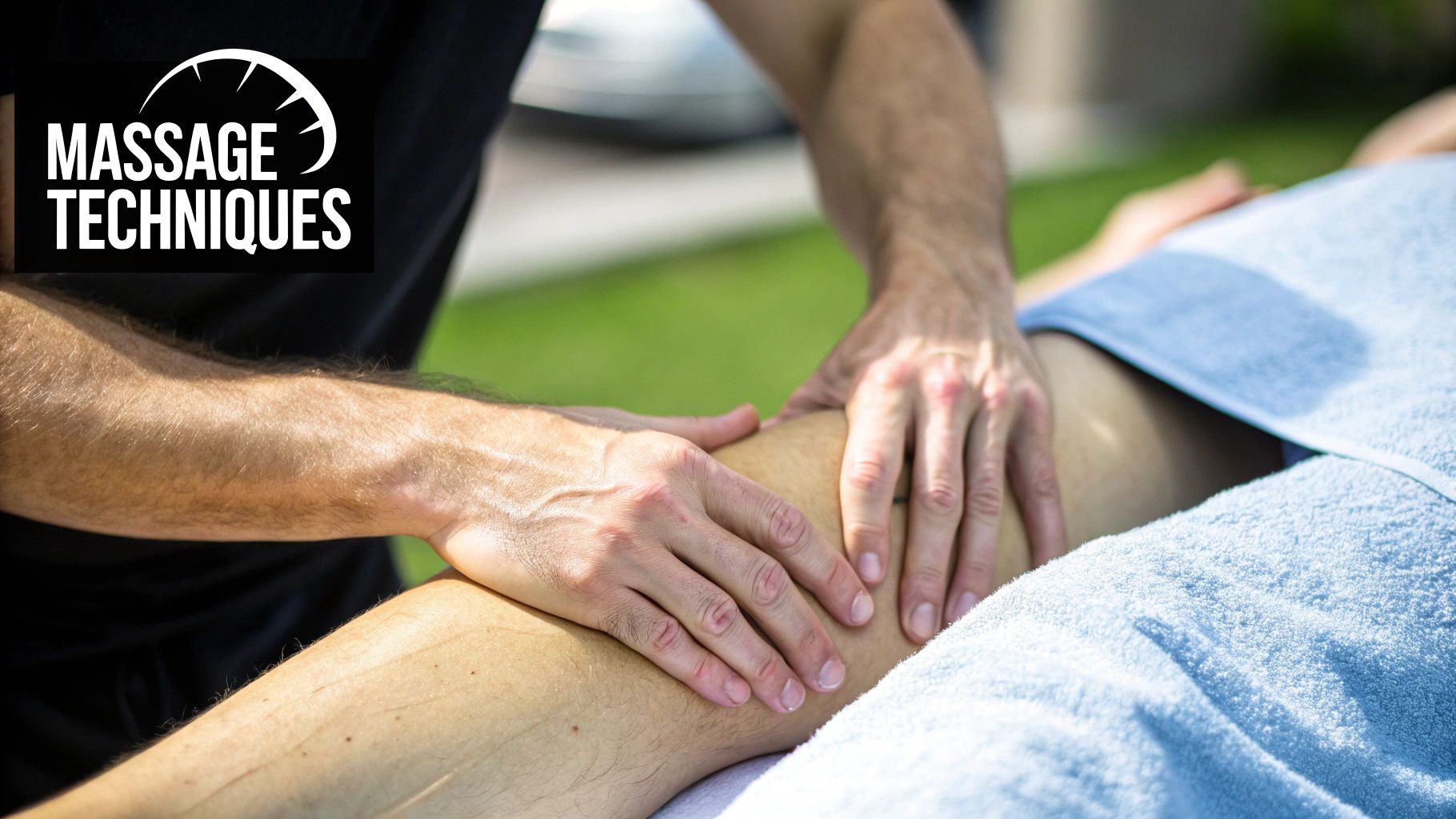
If you've ever wondered why massage feels so good on a painful sciatic nerve, the answer goes way beyond simple muscle relaxation. When a therapist applies skilled, targeted pressure, they're starting a powerful chain reaction inside your body that gets to the very source of sciatic pain.
Think of it like this: tight, knotted muscles create a sort of gridlock in your body, squeezing blood vessels and trapping all sorts of metabolic junk. Massage works to clear up that traffic jam.
Getting Blood Flowing and Flushing Out Pain
One of the first things a good massage does is kickstart your local circulation. This fresh rush of blood acts like a clean-up crew for your irritated tissues.
It brings a new supply of oxygen and nutrients that are absolutely essential for repairing muscle fibers. At the same time, this boost in circulation helps flush out the inflammatory byproducts that have built up around the nerve, which are often what's sending those relentless pain signals to your brain.
The core of the relief comes from this process. Better circulation means the body can more quickly remove the very things causing pain along the nerve. Plus, when the muscles finally relax from the focused pressure, they stop physically squeezing the nerve roots. This is what helps dial down that sharp, shooting pain. You can discover more insights about sciatica and massage therapy to really understand the mechanics.
In short, massage gives your body’s own healing system a major helping hand by getting the bad stuff out and the good stuff in.
Taking Off the Pressure and Triggering "Happy Hormones"
Beyond just circulation, massage gets physical with the pressure on the sciatic nerve itself. Muscles like the piriformis and glutes can get so tight they literally pinch the nerve, causing that classic sciatica agony. The focused kneading and deep strokes of a therapeutic massage work to manually soften and lengthen these exact muscle fibers.
As the tension lets go, it creates more space around the sciatic nerve. This gives it room to breathe, so to speak, so it can function without being constantly compressed.
But that's not all. The physical sensation of massage also has a huge impact on your brain chemistry. It triggers the release of endorphins, which are basically your body’s built-in painkillers. These incredible neurochemicals work on multiple fronts:
- They naturally lift your mood, giving you a feeling of well-being.
- They actually raise your pain threshold, so the pain you do feel is less intense.
- They encourage deep relaxation, which is key to breaking the vicious pain-tension cycle.
It's this two-pronged attack—physically freeing the nerve while chemically dulling your perception of pain—that makes massage so effective. For anyone dealing with chronic issues, looking into the specifics of pain relief massage therapy can shed even more light on how these techniques are fine-tuned for the best results.
How to Prepare for Your Massage Session
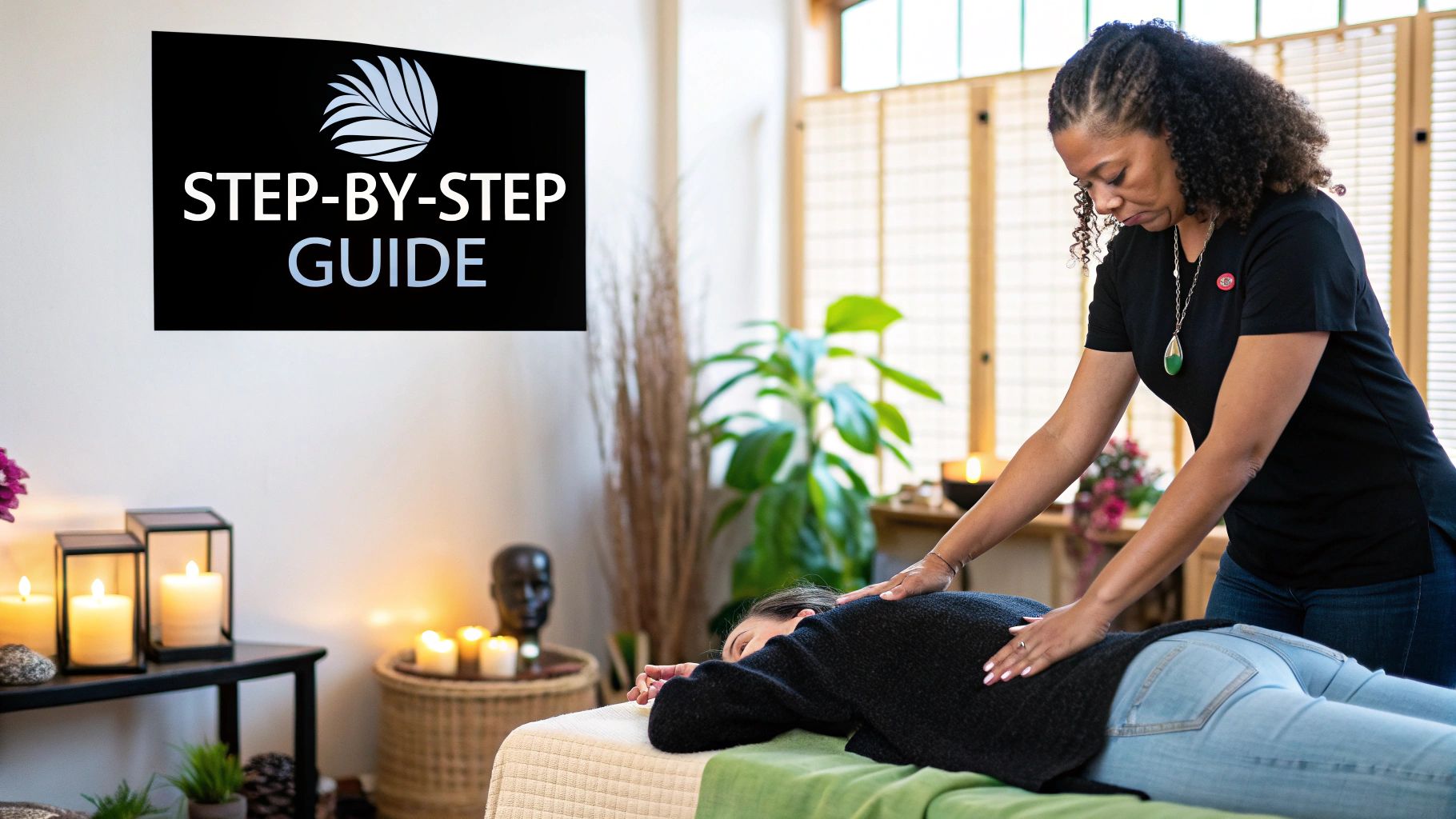
To get real, lasting relief from a massage for sciatic nerve pain, your work begins long before you get on the table. Proper preparation can make a world of difference, turning a standard massage into a truly therapeutic session. Think of it as setting the stage for success—it allows your therapist to get straight to the root of the problem and helps your body respond better to the treatment.
First things first: hydrate. Your muscles are made of about 75% water, and when they're parched, they get tight and stubborn. Guzzling down some extra water in the hours before your appointment makes the muscle tissue more supple and responsive. This simple step helps the therapist work more deeply and effectively without as much resistance from your body.
On a similar note, avoid eating a big meal right beforehand. Lying face down with a full stomach is just plain uncomfortable and can pull your focus away from the healing work being done. If you're hungry, a light snack an hour or two before you go is the perfect solution.
Finding the Right Professional
When you're dealing with something as specific as sciatica, not just any massage therapist will do. You need someone who understands the intricate pathways of the nerves and muscles involved. Don't be afraid to ask about credentials and experience when you book. It's your body, after all.
Look for practitioners who have advanced training in modalities like:
- Neuromuscular Therapy (NMT): This is a big one. NMT zeroes in on trigger points and nerve compression, which are often the culprits behind sciatic pain.
- Orthopedic or Medical Massage: Therapists with this background are trained specifically to address pain and injury conditions.
- Deep Tissue Massage: While common, make sure the therapist is skilled in applying it to the lower back and piriformis muscle with a nuanced touch, not just brute force.
Finding a specialist ensures they know the anatomy and can work safely without aggravating the nerve.
A great therapist won't just work on you; they will work with you. This partnership is built on clear communication, which is your most important tool during the session.
Communicating Your Needs Effectively
Your therapist is skilled, but they aren't a mind reader. The more information you can give them, the more targeted and effective the treatment will be. Before the session starts, be ready to paint a clear picture of your pain.
Where do you feel it? Is it a sharp pain that shoots down your leg, or is it more of a constant, dull ache deep in your glutes? Does sitting make it worse? Knowing these details gives your therapist a roadmap to the source of your discomfort.
Once the massage begins, your feedback is gold. A good therapist will check in on pressure, but you should always feel empowered to speak up. A simple, "Yes, that's the spot," can guide them to the trigger point, while a quick, "Could you ease up a little there?" prevents them from causing more inflammation. This ongoing conversation is what maximizes the benefits and ensures you walk out feeling better, not beaten up.
Safe Self-Massage Techniques for Home Relief
While seeing a professional massage therapist is a huge piece of the puzzle for managing sciatica, you also need ways to get relief right when you need it at home. Learning a few safe self-massage techniques gives you the power to handle flare-ups and stay more comfortable between your appointments. The idea isn't to replace your therapist but to use simple tools to gently target key muscles.
The whole point of self-massage for sciatic pain is to ease the tension in the muscles that are crowding the nerve, especially in your glutes and piriformis. A common mistake I see people make is going straight for the spot with the sharpest pain. Instead, you want to work on the tight muscles around that area that are likely causing the problem. Everyday tools like a tennis ball, a firmer lacrosse ball, or a foam roller work perfectly for this.
Using a Ball for Piriformis Release
That pesky piriformis muscle, tucked deep in your buttock, is often the main offender when it comes to sciatic-like pain. A tennis or lacrosse ball is fantastic for getting targeted pressure right where you need it.
First, sit on the floor with the ball under the glute on your sore side. Use your hands behind you for balance. Now, cross the ankle of your painful leg over the opposite knee, making a "figure four" with your legs. This simple stretch opens up your hip and gives you better access to the piriformis.
Now, just gently roll your weight over the ball until you find a spot that feels tender. That’s probably a trigger point.
- Hold the Pressure: When you hit a tender spot, stop rolling. Just hold still and let your body weight apply gentle, steady pressure for 30 to 60 seconds.
- Breathe Deeply: Don't forget to breathe! Taking slow, deep breaths sends a signal to your nervous system to relax, which helps the muscle finally let go.
- Avoid Sharp Pain: You’re aiming for that "good hurt" feeling—a sensation of release, not agony. If you feel any sharp, shooting, or electric pain, you're likely too close to the nerve. Back off right away and find a different spot.
Clinical experience shows us that this kind of targeted pressure can really improve range of motion and help the body heal from low back pain and sciatica. It works because the pressure coaxes tight muscles to relax and boosts blood flow to the area, which can take the pressure off the sciatic nerve. You can learn more about these findings on muscle relaxation.
Foam Rolling for Glutes and Lower Back
A foam roller is your best friend for tackling larger areas of tightness in the glutes and even the lower back. To start, just sit right on the roller and place your hands on the floor behind you for support. Lean your body a little to one side so you can focus the pressure on one glute at a time. Then, slowly roll back and forth over the fleshy part of your buttock.
When you're wondering if it's time to call in a professional, this infographic lays it out clearly.
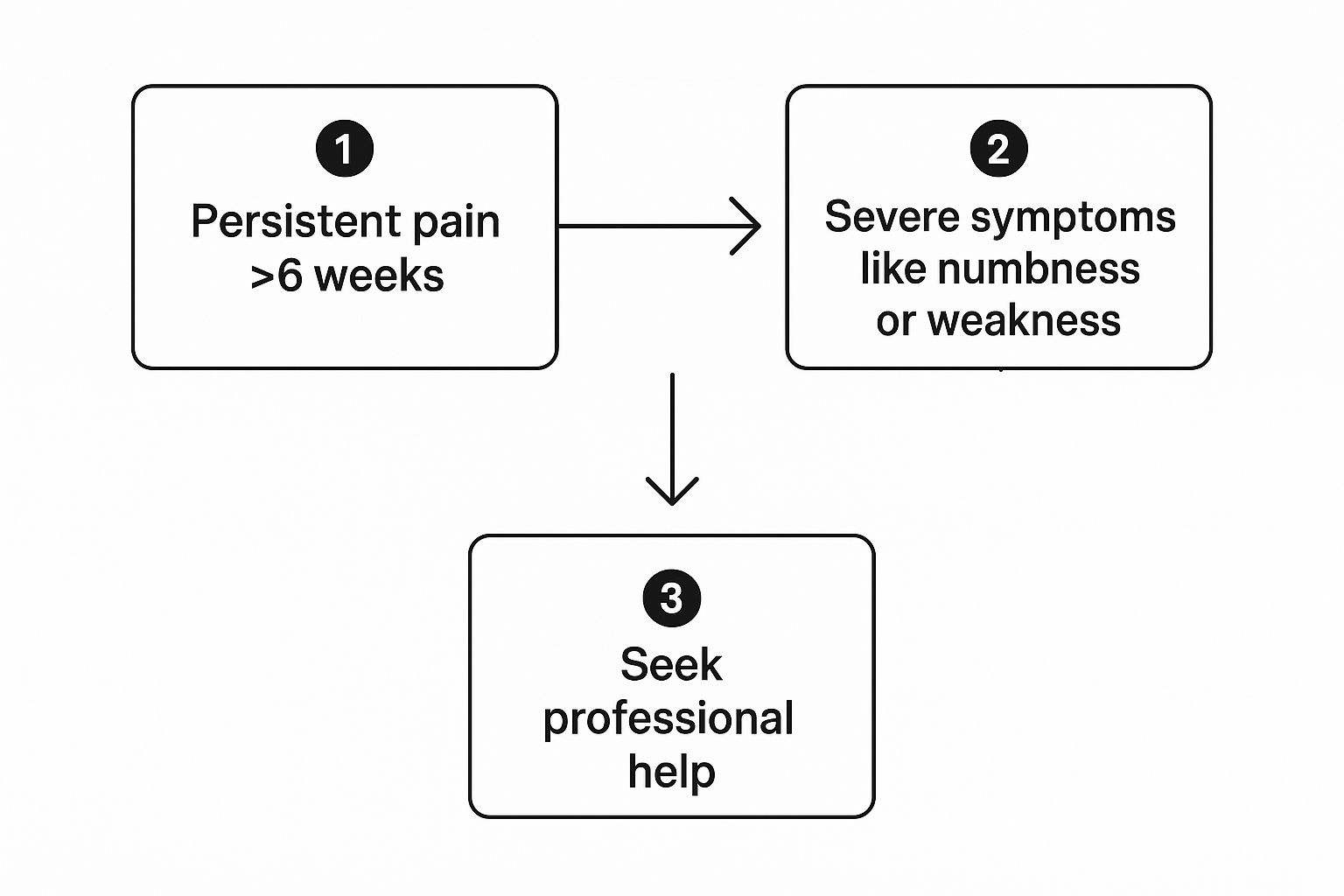
This visual points out the critical red flags that mean self-care isn't enough. It's a great reminder that while self-massage is helpful, it's no substitute for a real medical diagnosis when symptoms are severe or just won't go away.
Safety First: Never, ever use a ball or foam roller to apply intense, direct pressure to your spine. Always stick to the muscles around it. The goal here is to create space and relieve tension, not to force a joint or bone.
If you're looking for more ways to ease muscle tightness, you might find our guide on back pain massage therapy helpful. It dives into professional techniques that go hand-in-hand with these at-home methods.
Your Questions About Sciatica Massage Answered
Even after learning the ropes, it’s completely normal to have a few lingering questions before you dive into massage for sciatic nerve pain. I see it all the time with my clients. Getting clear on the details is what helps you move forward with confidence.
So, let's walk through some of the most common questions I hear. This should help clear up any final doubts and set you up for a successful experience.
How Often Should I Get a Massage for Sciatica?
This is probably the number one question people ask, and the honest answer is: it really depends on your body and your pain levels.
If you're in the throes of an acute flare-up, where the pain is sharp and constant, you’ll likely see the best results from more frequent sessions. Think once or twice a week. The goal here is to calm the immediate crisis, reduce inflammation, and get those tight, angry muscles to release their grip.
Once things start to calm down and the pain becomes less intense, you can shift into more of a maintenance mindset. For most people, this means a session every two to four weeks. This is all about prevention—keeping those muscles loose and preventing the tension from building back up to the point of another flare-up.
A good therapist won't just give you a generic number; they'll work with you to figure out a schedule based on how your body is responding. The real magic happens with consistency. A single massage can feel great, but a regular schedule is what creates lasting change.
Ultimately, your body will tell you what it needs. You just have to learn to listen.
Can a Massage Make Sciatica Worse?
This is a really important question, and a valid concern. The short answer is yes, a massage can make sciatica worse, but only if it's done improperly. It almost always comes down to technique and experience.
So, how does this happen? Usually, an inexperienced therapist applies too much aggressive, direct pressure right on the sciatic nerve itself. This is a huge no-no, as it can easily inflame an already irritated nerve. Another common mistake is going too deep, too fast on muscles that are already in spasm. This can backfire, causing the muscles to guard and tighten up even more.
To make sure your massage helps, not hurts:
- Find the right person. Seek out a licensed therapist who has specific training and experience working with sciatica. Don't be afraid to ask them about their approach.
- Speak up! This is your session. If anything feels too intense or causes sharp pain, tell your therapist immediately.
- Ease into it. Especially during a bad flare-up, the focus should be on gentle, indirect work, not painful deep tissue on the point of pain.
A skilled therapist knows to work on the surrounding muscles—like the piriformis, glutes, and lower back—to relieve pressure indirectly. That's the safer, and frankly, more effective path to relief.
What Should I Do After My Massage?
Believe it or not, what you do in the hours after your massage is almost as important as the session itself. Good post-massage care helps lock in the benefits and reduces any next-day soreness. The main goal is to help your body process and flush out all the metabolic waste that the massage released from your tissues.
First and foremost, drink plenty of water. Hydration is key to helping your kidneys and lymphatic system do their cleanup job efficiently.
A warm Epsom salt bath later in the evening can also be a game-changer. The magnesium is fantastic for soothing any residual tenderness and encouraging your muscles to relax even further.
Finally, give your body a break. Avoid a tough workout or any heavy lifting for the rest of the day. You want to give your muscles time to recover and adjust. Some gentle stretching, however, can feel amazing and help you stay loose.
At La Moon Massage and Facial, we specialize in providing targeted, therapeutic massage to help you find lasting relief from sciatica and other pain conditions. Our experienced therapists in Houston, TX, are dedicated to your well-being. Book your appointment today and start your journey toward a pain-free life.
Massage for Posture Can Realign Your Body and End Pain
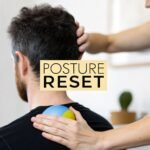
We all know the feeling. Long hours hunched over a keyboard, endless scrolling on a phone, and that nagging ache that just won't quit. This isn't just "bad slouching." It's a physical response to modern life, creating deep-seated muscle imbalances that pull your body out of alignment. The good news is that targeted massage for posture can directly address these root causes, offering more than just temporary relief.
How Modern Life Wrecks Your Posture
Think about your body's position throughout the day. Chances are, you spend a significant amount of time with your head pushed forward, shoulders rounded, and lower back in a slumped C-shape. Over weeks, months, and years, your body starts to treat this as its new normal.
This forces some muscles into a state of chronic tightness, while their opposing muscles become weak and stretched out. This tug-of-war is what we call a muscular imbalance, and it literally pulls your skeleton out of its natural alignment. The result is a cascade of issues: persistent neck pain, tension headaches, lower back strain, and even compromised breathing.
Key Insight: Good posture isn’t about consciously trying to sit up straight all day. It's about restoring balance to your muscles so that proper alignment becomes your body's effortless, default state.
This isn’t a minor inconvenience; it’s a massive health issue. A staggering 80% of people will experience back pain at some point, and posture is a huge contributing factor. In fact, studies show nearly 70% of office workers suffer from neck pain directly linked to their posture. If you want to dive deeper, you can explore how modern work affects your body and how massage therapy can be part of the solution.
Uncovering The Real Culprits
To fix the problem, you have to know what's actually causing it. Every common postural problem, from "tech neck" to a tilted pelvis, has a specific group of tight muscles pulling you out of whack. A skilled massage therapist knows exactly which ones to target.
For instance, rounded shoulders aren't just a sign of a weak back. More often, the primary cause is incredibly tight chest muscles (the pectorals) that are physically pulling your shoulders forward and inward. Likewise, a forward head position isn't just about your neck. It’s driven by overworked muscles at the base of your skull (the suboccipitals) and chronically tight upper traps.
Effective massage for posture goes beyond simply rubbing the sore spot. It’s about strategically releasing these tight "guy wires" to allow your entire structure to return to a more balanced and comfortable position.
Common Postural Issues and Targeted Massage Solutions
This table breaks down some of the most common postural deviations we see today and highlights the key muscle groups a massage therapist can work on to bring you back into balance.
| Postural Problem | Affected Muscle Groups | How Massage Helps |
|---|---|---|
| Forward Head ("Tech Neck") | Neck extensors, suboccipitals, upper trapezius | Releases chronic tension at the base of the skull and across the shoulders, allowing the head to retract to a neutral position. |
| Rounded Shoulders | Pectoral muscles (chest), anterior deltoids | Lengthens the tight muscles in the front of the body that pull the shoulders forward, promoting a more open chest. |
| Anterior Pelvic Tilt | Hip flexors, quadriceps, erector spinae (low back) | Loosens the tight hip flexors and lower back muscles that pull the pelvis forward, restoring a neutral pelvic alignment. |
By understanding these connections, you can see how targeted massage therapy is a powerful tool for dismantling years of postural strain, one tight muscle at a time.
Finding Your Body's Unique Postural Pattern
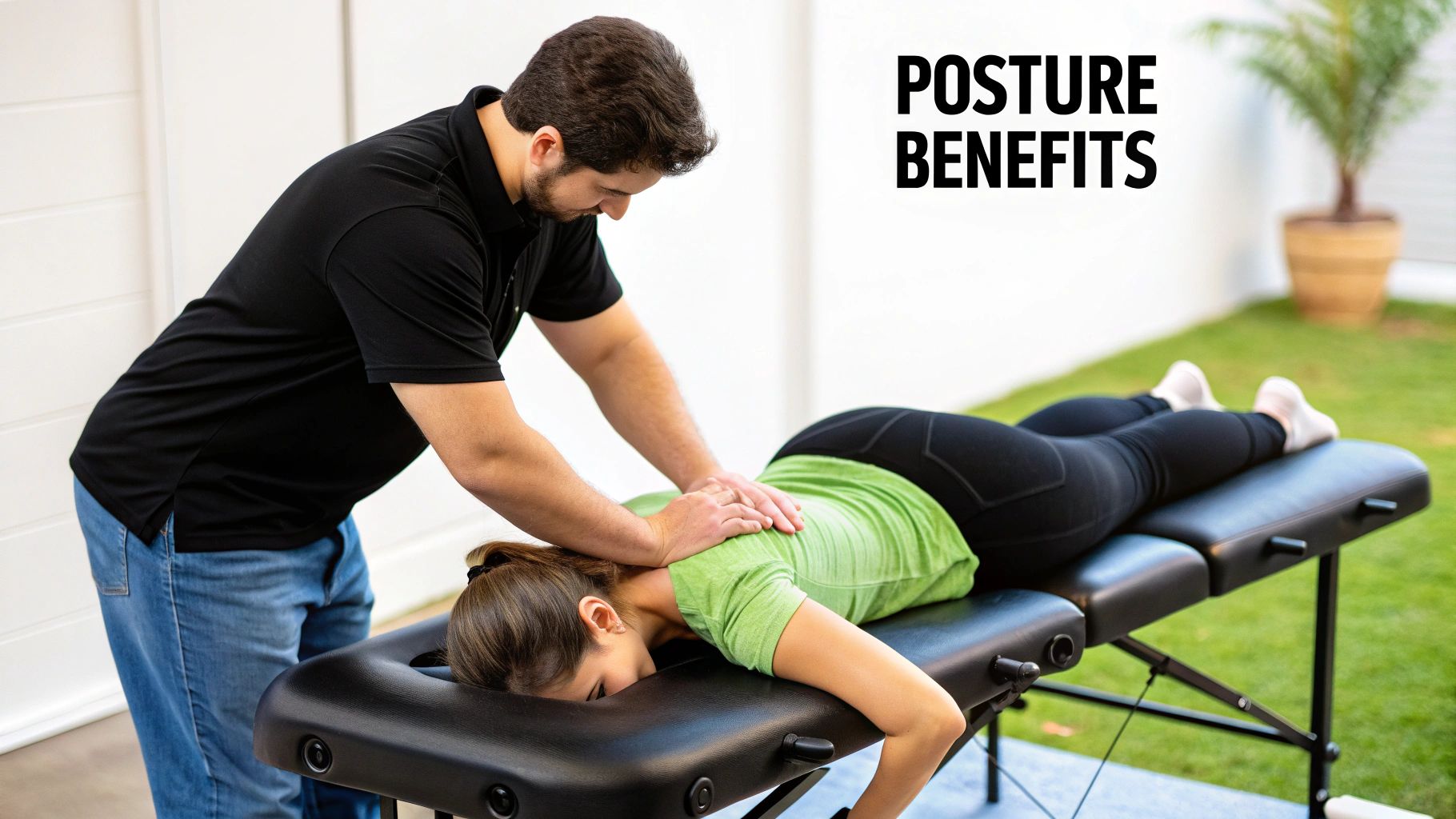
Before you can really make a dent in your posture with massage, you first have to play detective. Think of your body as a finely tuned structure. When everything is in balance, you stand tall with ease. But over time, some muscles get tight and short while others become long and weak, pulling your entire frame out of whack.
This is what we mean by muscular imbalances. It's more than just "slouching." It's a physical tug-of-war where tight muscles, like your chest and hip flexors, are overpowering their weaker partners, like your upper back muscles and glutes. Your daily grind—whether it's at a desk or on your feet—creates a very specific postural signature unique to you.
The Mirror Test: A Quick Self-Check
Your first step is to get an honest look at what's going on. Go stand in front of a full-length mirror and just relax into your usual stance. Don't try to "fix" anything or stand up straight. We want to see your body's default setting.
Now, let's look for a few common giveaways:
- Head Position: Does your head seem to jut forward instead of resting right over your shoulders? If your ears are out in front of your shoulder line, you’re likely dealing with forward head posture. This is often caused by chronically tight muscles at the base of your skull and front of your neck.
- Shoulder Alignment: Are your shoulders slumped and rolling inward? A dead giveaway is if the backs of your hands face forward when your arms are relaxed at your sides. This is classic rounded shoulders, usually because tight chest muscles are pulling everything forward.
- Pelvic Tilt: Put your hands on your hips, like you're striking a pose. Does your pelvis feel like it's tipping forward, creating a deep arch in your lower back? That's an anterior pelvic tilt, a super common imbalance, especially if you sit a lot, which shortens the hip flexors.
Here's a quick reality check I give my clients: the wall test. Stand with your back flat against a wall. Your heels, butt, and shoulder blades should all be touching it. Now, check the back of your head. How much space is there between it and the wall? If it’s more than a two-inch gap, that's a pretty clear sign of forward head posture.
Tuning Into What Your Body Is Telling You
Visuals are great, but you can also feel these imbalances pretty clearly.
For example, someone with seriously rounded shoulders might find it almost impossible to lie flat on the floor without their shoulders popping up. That isn't just a lack of flexibility; it's a direct signal that the pectoral muscles are shortened and need targeted massage work to release them.
It's the same story with that nagging, knotty ache in your upper shoulders and neck. That's a huge clue that those muscles are working overtime, trying desperately to hold up a head that has drifted too far forward. These physical sensations aren't random aches—they're your body's way of highlighting the exact source of the problem.
By putting these visual checks and physical feelings together, you start to build a clear map of your body's unique imbalances. This personal blueprint is what makes all the difference. It helps you move from a generic, feel-good massage to a strategic massage for posture that goes right after the muscles causing the trouble, giving your body a real chance to find its way back to effortless alignment.
Real Massage Techniques That Correct Posture
Alright, let's get hands-on. This is where the real change happens. We're moving beyond general advice and getting into specific massage routines you can do yourself to start seeing and feeling a difference in your posture. Think of this as your personal toolkit for tackling the common problem areas that pull your body out of alignment.
We’ll be zeroing in on those chronically tight muscles—the ones that are almost always the true culprits behind rounded shoulders and that nagging "tech neck." For each technique, I'll walk you through the pressure, timing, and exactly what you should be feeling, so you can start making progress right away.
This infographic gives you a great visual breakdown of which massage techniques hit which postural problems.
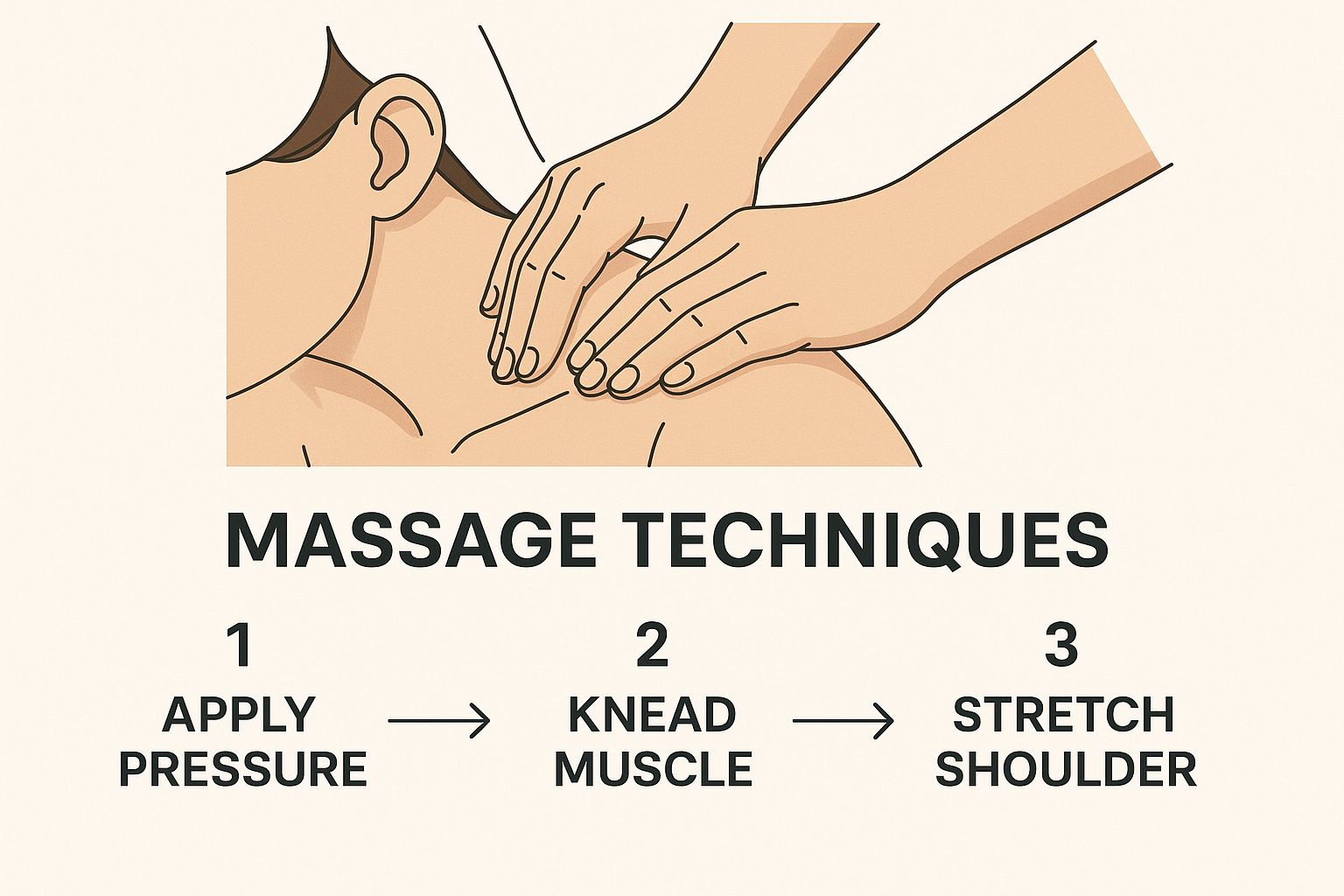
As you can see, it’s all about combining targeted pressure with specific movements to really let that postural tension go.
Releasing Rounded Shoulders
Most people think rounded shoulders come from a weak back, but that’s rarely the whole story. The primary driver is almost always tight pectoral (chest) muscles pulling your shoulders forward and in. To fight back, all you need is a massage ball.
- Tool: A lacrosse ball is perfect. A firm tennis ball works too.
- Technique: Find a wall and stand facing it. Tuck the ball into your upper chest, right below the collarbone and just off to the side of your sternum. Now, lean into the wall to apply some pressure.
- Movement: Start slowly rolling the ball across your pec muscles with small, deliberate movements. When you hit a spot that feels tender or "knotty," stop. Just hold that pressure for 20-30 seconds and breathe deeply into it. To take it a step further, you can slowly raise and lower the arm on that same side to deepen the release.
What you're doing here is directly lengthening those tight muscle fibers that are literally pulling you forward. This allows your shoulders to finally relax back into a more natural, open position. It’s a trick many athletes use to stay mobile, which you can read more about in our article on deep tissue massage for athletes.
Alleviating Forward Head Posture
That all-too-common "tech neck" is the result of overworked muscles at the base of your skull and in your upper back. They're in a constant battle with gravity, trying to hold up a head that's drifted too far forward from looking at screens.
Expert Tip: Don't just work on the back of your neck! A lot of the tension comes from the front. The sternocleidomastoid (SCM) muscles, those ropey ones on the front and sides of your neck, get incredibly tight. Gently pinching and rolling these muscles between your thumb and forefinger can bring a surprising amount of relief.
For the back of your neck and shoulders, your own hands are the perfect tool. Sit comfortably, and with your opposite hand, use your fingertips to apply firm, kneading pressure to that meaty upper trapezius muscle between your neck and shoulder. Slowly work your way up toward the base of your skull, paying extra attention to any sore spots you find.
And this isn't just theory. Studies have confirmed that this kind of targeted massage for posture makes a real difference. One study on office workers found that regular massage led to significant improvements in their neck and shoulder posture, not to mention a big drop in the pain that comes from sitting at a desk all day. You can dig into similar findings about the benefits of posture-correcting massage.
Unlocking the Upper Back
Your thoracic spine—that's your upper and mid-back—can get incredibly stiff and stuck, which is a major contributor to a slouched posture. Your best friend for this job is a foam roller.
Start by lying on the floor with the foam roller positioned horizontally under your shoulder blades. Plant your feet flat on the floor with your knees bent.
Gently cradle your head with your hands (don’t pull on your neck!) and lift your hips just a bit off the floor.
Now, use your legs to slowly roll your body back and forth, moving the roller from the bottom of your neck down to about the middle of your back. This movement helps get the individual vertebrae moving while releasing the tight muscles around your spine. Give it about one to two minutes, focusing on slow, deep breaths to encourage your muscles to relax.
Knowing When It’s Time to See a Professional
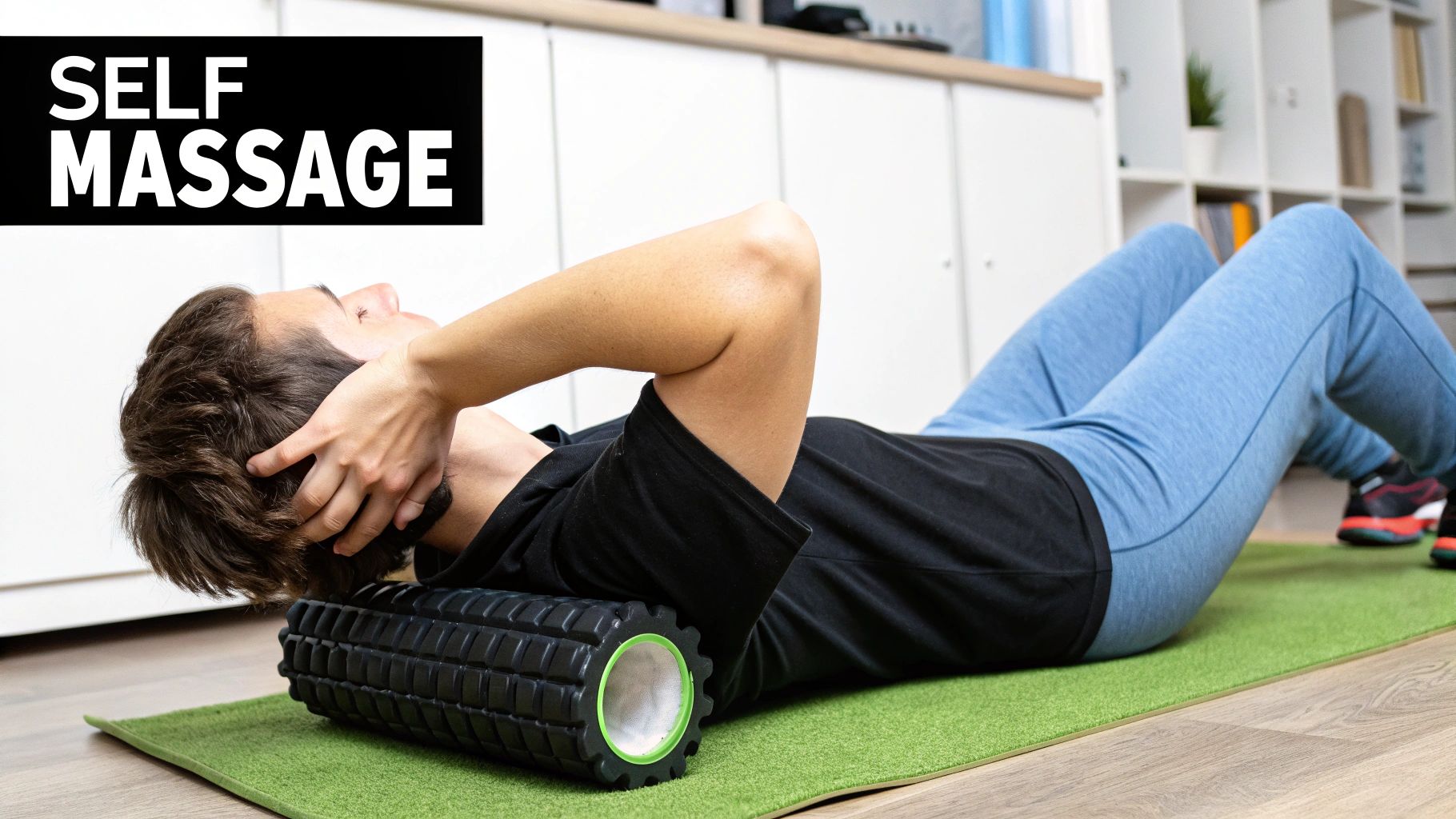
As great as at-home techniques are for day-to-day relief, there comes a point where you need to call in a professional. Self-massage can only take you so far. If you're wrestling with chronic pain, a serious postural deviation like a pronounced pelvic tilt, or you’ve simply hit a wall with your own efforts, it’s time.
A licensed therapist brings a trained eye to the table—literally. They can spot imbalance patterns you’d never notice and get to muscles that are impossible for you to reach on your own. Think of it like this: your daily self-care is like brushing your teeth, while a professional session is the deep cleaning you get from a dental hygienist. Both are crucial, but one provides the powerful reset your body needs to truly change.
Finding the Right Type of Bodywork
When it comes to fixing posture, not just any massage will do. A relaxing Swedish massage is wonderful, but for releasing the deep-seated patterns holding you out of alignment, you need something more targeted.
Here are the heavy hitters I recommend to my own clients:
- Deep Tissue Massage: This is the gold standard for postural work. Using firm, slow strokes, a therapist can break down the chronic adhesions—those stubborn, ropey bands of muscle—that are common in the chest, upper back, and hips.
- Myofascial Release: This technique is all about the fascia, the web of connective tissue that wraps around everything in your body. Gentle, sustained pressure helps "unstick" fascial restrictions, which can dramatically improve your range of motion and release long-held tension.
- Trigger Point Therapy: Got a specific "knot" that shoots pain somewhere else when you press it? That's a trigger point. This therapy applies direct, focused pressure to deactivate these points, which can bring instant relief and restore proper muscle function.
My Experience: The best therapists rarely stick to just one modality. They'll often blend these approaches, using deep tissue for broad areas, myofascial work for that "stuck" feeling, and trigger point therapy to zap specific knots. This is what makes a session a true massage for posture rather than just a generic rubdown.
How to Talk to Your Therapist for the Best Results
Clear communication is everything. Walking in and just saying "my back hurts" isn't enough. You need to give them a roadmap.
Try being more specific: "I feel this constant pulling in my right shoulder after a day at my desk," or "My low back feels like it's always arched, and the front of my hips are incredibly tight." This kind of detail helps them zero in on the root cause.
It's an interesting side note that therapists themselves are highly susceptible to postural strain. One study found that many therapists work in a forward-flexed position, which puts a huge load on their own back and neck muscles. You can read more about the ergonomic risks in massage therapy, and it gives you some insight into why they're so good at spotting these issues in others.
For real, lasting postural changes, you'll likely need a series of sessions. I usually suggest clients start with weekly appointments for the first month to build momentum. After that, you can often scale back to bi-weekly or monthly visits for maintenance as your body starts to hold its new, healthier alignment.
Making Good Posture Your New Normal
Massage therapy is brilliant at doing the heavy lifting—releasing those deep-seated muscle restrictions that have been pulling you out of alignment for years. But what happens after you leave the massage table and step back into your daily life? Real, lasting change isn't just about the release. It's about building new habits that support your posture for the long haul.
Think of it like this: your massage session is a reset button, bringing your body back to a more neutral, balanced state. From there, your job is to create an environment and lifestyle that helps it stay there. This is how you shift good posture from a conscious, constant effort into your body's new, unconscious default setting.
It all comes down to weaving posture-friendly practices into your everyday routine so seamlessly that they become second nature. Doing so is the key to preventing those old patterns of tension and imbalance from creeping back in.
Creating a Posture-Friendly Environment
It's easy to underestimate just how much our surroundings impact our bodies. A few simple, strategic tweaks to your daily environment can make a world of difference, especially at your workstation, where most of us spend a huge chunk of our day.
- Elevate Your Screen: Position your monitor so the top third of the screen is right at eye level. This one change is incredibly effective at preventing the forward head drift that causes "tech neck."
- Support Your Lower Back: If your chair’s lumbar support is lacking, you don't need to buy a whole new chair. A small, rolled-up towel or a dedicated lumbar pillow can do wonders to maintain the natural curve of your lower spine and stop you from slouching.
- Keep Your Feet Flat: Your feet should be able to rest flat on the floor, with your knees bent at roughly a 90-degree angle. If they don't quite reach, a small footrest is a great investment. This grounds your posture and keeps your pelvis stable.
These small ergonomic adjustments aren't just for comfort—they actively prevent the very muscle imbalances that a massage for posture works so hard to correct. For those who find sitting is a major source of discomfort, our guide on using massage therapy for back pain offers even more targeted strategies.
Key Takeaway: Your environment should support your posture, not fight against it. A few intentional changes to your chair, desk, and screen setup can passively reinforce the work done during your massage, making good alignment feel almost effortless.
Integrating Mindful Movement
Lasting postural change also demands that you break up long periods of being still. Your body was designed for movement, and integrating short, mindful movement breaks can keep muscles from getting stiff and locking into poor positions.
This doesn't mean you need to schedule a full-blown gym session in the middle of your workday. It's about creating small, repeatable rituals. Try setting a timer to remind yourself to get up and stretch every 45-60 minutes. A quick two-minute routine is all it takes to hit the reset button.
Here's a simple sequence you can do right at your desk:
- Chest Opener: Clasp your hands behind your back, straighten your arms, and feel a gentle stretch as you pull your shoulder blades together. This is the perfect antidote to hunching over a keyboard.
- Neck Stretch: Gently tilt your ear toward your shoulder, holding for about 20 seconds on each side. Don't pull or force it.
- Spinal Twist: While seated, gently twist your torso to look over one shoulder, then the other.
These little micro-movements are fantastic for counteracting the effects of a static posture, keeping your muscles pliable and your joints mobile. When you combine professional massage with these simple daily habits, you're building a powerful, sustainable strategy for making good posture your new normal.
Your Questions About Posture and Massage, Answered
Even with all this information, you probably still have a few questions buzzing around. That's completely normal—and smart. When you're trying a new approach to your health, it's good to have all the facts. We get these questions all the time from clients, so let's clear up some of the most common ones.
Think of this as your final check-in, making sure you feel confident and ready to use massage as a tool for better posture and a life with less pain.
How Quickly Will I Actually See Results?
This is the big one, isn't it? While almost everyone feels a wonderful sense of openness and relief right after their first massage, real, lasting change takes time. After all, you’re often working to correct muscle habits that have been years in the making.
Most people start to see noticeable, sustainable improvements within 4 to 6 weeks of consistent massage therapy. This gives your therapist enough time to go beyond temporary relief and start systematically unwinding the deep-seated muscle imbalances. The key here is consistency, both with your sessions and the daily awareness habits we talked about earlier.
Could Massage Actually Make My Posture Worse?
It's a valid concern, but when you're in the hands of a qualified professional, the answer is a resounding no. A therapist who truly understands postural anatomy will only help. The risk comes from a therapist who might be too aggressive or who focuses on the wrong areas, which could leave you sore or feeling temporarily off-kilter.
A Pro Tip: Communication is everything. Your comfort is the number one priority. And if you're doing self-massage at home, the golden rule is simple: listen to your body. Start gently and never, ever push through sharp pain.
Understanding the difference between a general relaxation massage and a targeted session is crucial. To get a better sense of how professionals design sessions for specific goals, you can learn more from our guide on what defines a therapeutic massage.
What's the Best Massage for "Tech Neck" and Rounded Shoulders?
Ah, the modern posture curse. For these stubborn issues, you'll get the best results from a blend of techniques. No single style is a magic bullet because you're dealing with a complex pattern of tight and weak muscles.
- Deep Tissue Massage is a powerhouse for breaking down the tough, chronic knots in your chest and upper back muscles—the very ones pulling your shoulders forward.
- Myofascial Release works wonders on that "stuck" feeling in your connective tissues. It helps restore fluidity and movement across your chest and shoulders.
- Trigger Point Therapy is perfect for zeroing in on those specific, nagging knots at the base of your skull or between your shoulder blades that cause so much grief.
A skilled therapist won't just use one of these; they'll mix and match them to release the tight muscles pulling you forward and help you reconnect with the weak, underused muscles in your back.
Do I Really Need to Buy Tools for Self-Massage?
Not at all! You can get started with just your hands—they're incredibly effective tools you already own. That said, a few simple, inexpensive tools can make your home routine much more effective.
A lacrosse ball (or even a tennis ball) is a game-changer. It lets you apply deep, targeted pressure to tricky spots like your pecs or the muscles between your shoulder blades, simply by leaning against a wall. A foam roller is also fantastic for opening up your thoracic spine (your upper and mid-back), which is absolutely essential for standing tall and proud.
Ready to let a professional guide your journey back to better posture? The expert therapists at La Moon Massage and Facial specialize in techniques designed to release chronic tension and restore your body’s natural alignment. Book your session today and take the first step toward standing taller.
Massage for Neck and Shoulder Pain Relief Guide

When you're dealing with neck and shoulder pain, a good massage can feel like a miracle. It's a powerful, hands-on way to get relief without resorting to medication, especially when the root of your problem is muscle tension, stress, or the postural habits of modern life.
A targeted massage works wonders by zeroing in on tight muscle knots, boosting blood flow to those stiff areas, and calming the inflammation that makes you feel so sore. For a lot of people I've worked with, it's the difference between temporary fixes and finally finding real, lasting comfort.
Why Your Neck and Shoulders Hurt So Much
That nagging ache in your neck and the heavy, tight sensation that settles across your shoulders aren't just minor annoyances. They're your body's way of sending up a flare, signaling that something is off. Figuring out why you're hurting is the first real step toward getting better for good. The pain you're feeling is rarely random; it's almost always a direct consequence of your daily routine and how your body handles stress.
The Problem with "Tech Neck" and Daily Stress
Let's be honest, a huge part of the problem comes from what's often called "tech neck." Take a moment to check your posture right now. Are you slumped over a desk or craning your neck down to look at your phone? That forward-head position puts a massive amount of strain on your neck and the muscles trying to support it.
It's a simple matter of physics: for every inch your head drifts forward, it adds about 10 extra pounds of weight for your neck muscles to hold up. Imagine carrying that extra load all day, every day. It's no wonder those muscles get exhausted and chronically tight, especially the upper trapezius and levator scapulae—the major muscles connecting your neck and shoulders.
Stress is the other big piece of the puzzle. When you're stressed, your body's natural "fight or flight" response kicks in, causing your muscles to tense up automatically. The neck and shoulders are notorious for taking the brunt of this. If you live with constant stress, those muscles almost never get a chance to fully relax, which leads directly to chronic tightness and those painful, hard "knots" we all know too well.
What we call a "knot" is technically a myofascial trigger point. It's a tiny, super-irritable spot in a tight band of muscle. These spots are not only tender when you press on them, but they can also send pain to other parts of your body. This is why a knot in your shoulder can easily trigger a headache or send a shooting pain down your arm.
What Is Your Pain Telling You?
To get a better handle on what's going on, it helps to understand the potential sources of your discomfort. Different causes often produce different types of pain. A dull, persistent ache usually signals widespread muscle tension from fatigue or poor posture, while a sharp, radiating pain might suggest a pinched nerve or a more specific injury.
Here’s a quick reference table to help you identify what might be causing your pain.
Common Causes of Neck and Shoulder Pain
| Cause | Common Symptoms | Best First Approach |
|---|---|---|
| Poor Posture (Tech Neck) | Dull, aching pain across the shoulders and back of the neck; stiffness; frequent tension headaches. | Ergonomic adjustments to your workspace, regular stretching breaks, and self-massage focusing on the upper back and neck. |
| Stress and Anxiety | Tightness and clenching in the shoulders (feeling like they're "up by your ears"); knots in the upper trapezius muscles. | Deep breathing exercises, mindfulness practices, and massage to release held tension. |
| Muscle Strain/Overuse | Sharp pain after a specific activity (like lifting something heavy or a new workout); muscle soreness. | Rest, gentle stretching after the initial 48 hours, and applying ice to reduce inflammation. |
| Pinched Nerve | Sharp, shooting, or burning pain that may radiate down the arm; numbness or tingling ("pins and needles"). | See a doctor or physical therapist for a proper diagnosis. Avoid deep massage directly on the affected area until cleared by a professional. |
| Underlying Medical Condition | Persistent or worsening pain, pain accompanied by fever or weakness, or pain that doesn't improve with self-care. | Immediate consultation with a healthcare professional to rule out more serious issues like arthritis or disc problems. |
While this table is a helpful starting point, remember that pain can be complex. If you're ever in doubt or your symptoms are severe, seeing a doctor is always the smartest move.
The proof that massage for neck and shoulder pain truly works is overwhelming and backed by solid research. It's far more than just a temporary feel-good treatment; it's a legitimate therapeutic intervention. In fact, comprehensive reviews of scientific studies have repeatedly shown that massage provides statistically significant relief from this kind of musculoskeletal pain, improving both comfort levels and your ability to move freely.
Considering that neck and shoulder pain impacts up to 30% of working adults, having an accessible and effective solution like massage is a game-changer. If you want to dive deeper, you can explore the published research on massage therapy's effectiveness and see the data for yourself.
Effective Self-Massage You Can Do Anywhere
You don’t always need a professional appointment to get a handle on your neck and shoulder pain. The power to soothe those aching muscles is literally in your own hands, whether you’re stuck at your desk, chilling on the sofa, or even just waiting for the kettle to boil. This is all about applying smart, targeted self-care right where the tension builds up.
The trick is to go beyond just aimless rubbing. We're going to focus on specific methods that get to the root of muscle knots and tightness. When you learn how to apply the right kind of pressure and combine it with mindful breathing, you can find incredible relief without making things worse.
Mastering the Upper Trapezius Squeeze
One of the biggest troublemakers for shoulder tension is the upper trapezius muscle. This is that big muscle running from the base of your skull out to your shoulder, and it's the one that feels like a steel cable when you're stressed or hunched over a laptop all day.
Here’s a simple way to get it to release. Find a comfortable chair and plant your feet on the floor. Now, take your right hand and reach it over to your left shoulder. Let your fingers find that fleshy, often tender, part of the muscle between your neck and shoulder joint.
Gently squeeze that muscle between your thumb and fingers. You’re looking for a firm but comfortable pressure. Hold it for about 10-15 seconds while you take a nice, slow, deep breath. As you breathe out, slowly let go. Give that a try three to five times, then switch over and give your other side the same attention. This simple move is fantastic for boosting blood flow and telling those clenched muscle fibers it’s time to relax.
Using a Tennis Ball for Deep Knots
What about those stubborn, deep knots between your shoulder blades? The ones you just can't seem to reach? This is where a simple tennis or lacrosse ball becomes your secret weapon. It’s perfect for getting into the trigger points deep in the rhomboid and trapezius muscles.
Find a bit of empty wall space. Place the ball between your back and the wall, positioning it just to the side of your spine right where you feel that tight spot. From there, gently lean back into the ball to apply steady pressure. You can create small, controlled movements by bending your knees or shifting your body from side to side to really work into the area.
When you hit a particularly tender spot, just pause and hold the pressure there for 20-30 seconds. You might feel what I call a “good pain” or a sensation of deep release. That's a great sign that the trigger point is letting go. Just be sure to avoid rolling the ball directly over your spine.
This technique is an incredible stand-in for a deep tissue massage. The goal isn’t to cause sharp pain but to apply that sustained pressure that gives the muscle the time it needs to release on its own terms.
A huge reason this kind of self-massage is so important is that it directly counteracts the daily grind of poor posture, which many of us fall into after hours at a desk.
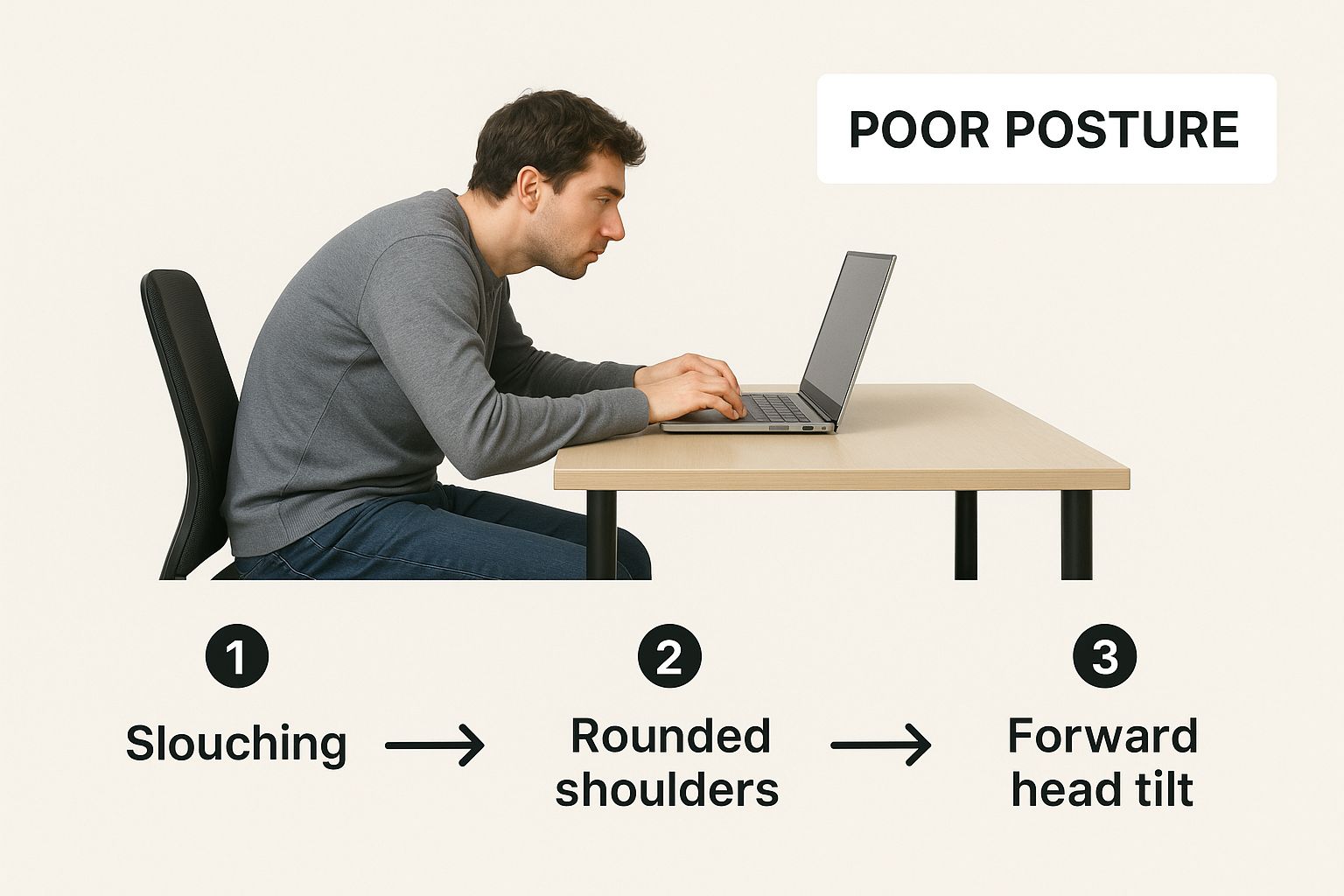
The image above does a great job of showing how slouching puts a ton of strain on the neck and shoulder muscles—the very same strain these self-massage techniques are designed to relieve.
Adding Gentle Neck Stretches
Once you've done some work on the muscles themselves, incorporating a few gentle stretches can do wonders for restoring mobility and making that relief last. Always move slowly and deliberately with these, and never, ever push into sharp pain.
- Ear-to-Shoulder Tilt: While sitting, slowly tilt your right ear toward your right shoulder. Stop when you feel a nice, gentle stretch along the left side of your neck. Hold for 20 seconds, breathe, and then slowly return to center before repeating on the other side.
- Chin Tuck: This one feels a little goofy but it’s incredibly effective. Sit up straight, look forward, and gently tuck your chin toward your chest as if you're trying to make a double chin. You should feel this stretch at the very back of your neck. Hold for just 5-10 seconds and repeat it a few times.
These self-care strategies give you a powerful way to manage those daily aches and pains. They work even better when they’re part of a bigger plan that includes professional treatment. If you're wondering how these hands-on tricks fit into a broader wellness strategy, you can learn more about what is therapeutic massage and how it digs into the root causes of chronic pain. Combining your own self-care with expert therapy is truly the best approach for lasting relief.
When to See a Professional Massage Therapist
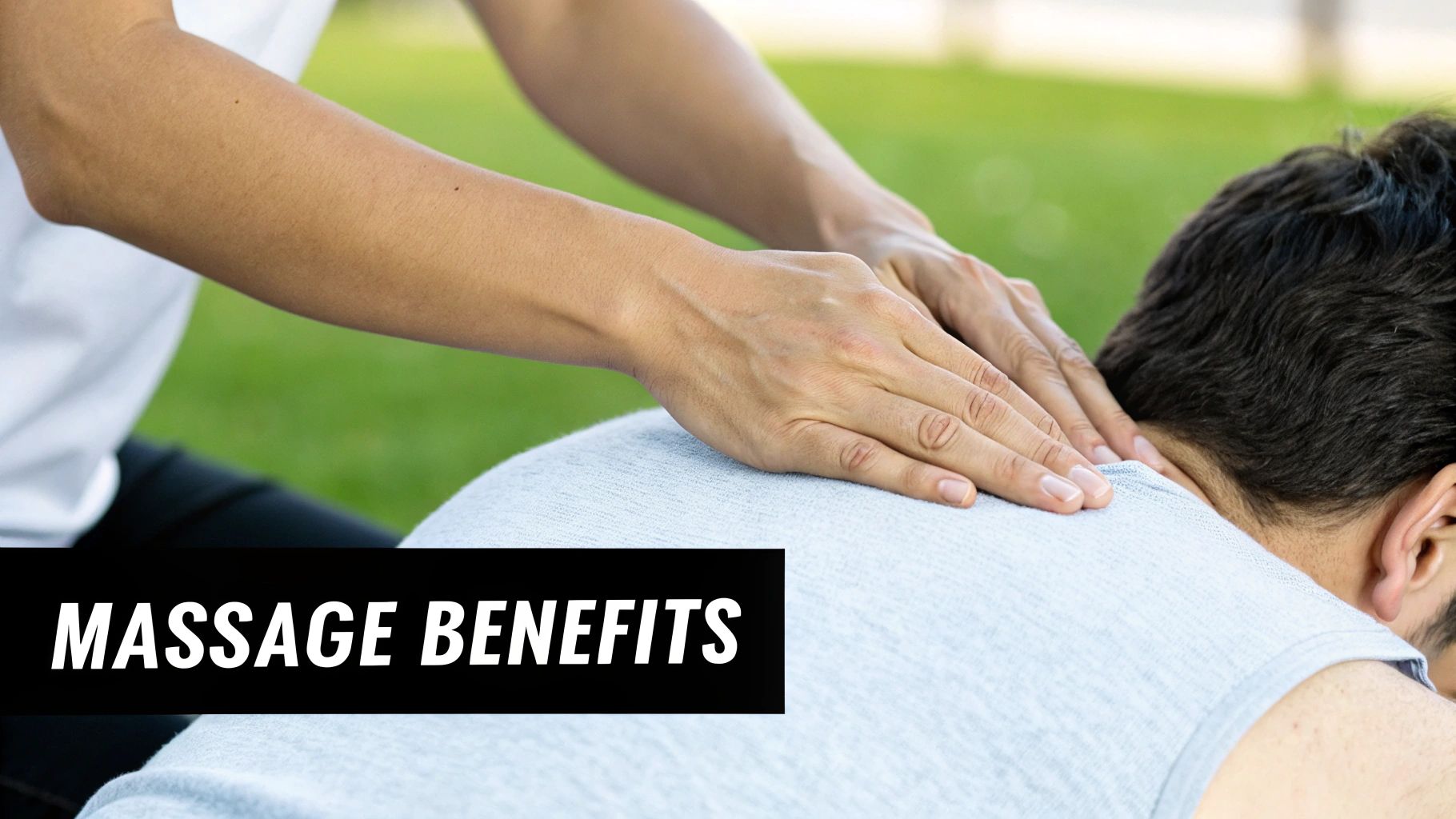
Self-massage is a fantastic tool for day-to-day relief and handling minor stiffness. But let's be realistic—sometimes, what you can do at home just isn't enough. Knowing when to hand things over to a professional is a critical part of actually finding lasting relief and making sure you don't make things worse.
Some signs are pretty clear indicators that it's time to call in the pros. If you've been dealing with the same nagging pain for weeks and your own efforts aren't making a dent, the root cause is likely deeper than you can reach on your own.
A major red flag that should have you booking an appointment immediately is any pain accompanied by numbness, tingling, or a "pins and needles" sensation that travels down your arm or into your fingers. That suggests a nerve might be involved, and that's not something to mess with. You need an expert's careful touch.
When the discomfort starts messing with your sleep, you can't focus at work, or you're skipping activities you used to love, it’s not just a minor ache anymore. At that point, it’s a quality-of-life issue, and that’s when a professional can make a real difference.
Finding the Right Massage Style for You
When you decide to get a massage for neck and shoulder pain, you'll quickly realize there are many different approaches. The key is to clearly explain your symptoms to the therapist so they can tailor the session to what you actually need.
Here are a few of the most effective styles I see work for this kind of pain:
- Swedish Massage: Think of this as the perfect entry point if your pain is mostly from general stress and tight muscles. It relies on long, flowing strokes that are incredibly relaxing and get the blood flowing.
- Deep Tissue Massage: If you're dealing with stubborn, deep knots that have been there forever, this is your go-to. The therapist uses more intense, focused pressure to work on the deeper layers of muscle and the tissues connecting them.
- Trigger Point Therapy: This one is incredibly specific. The therapist hunts down those small, irritable knots—the "trigger points"—and applies direct pressure to get them to release. This can relieve not just the pain right there, but also pain that radiates to other areas.
Why Professional Treatment Works
A skilled therapist brings a deep understanding of anatomy to the table. They can feel and trace complex patterns of muscle tension that you'd never be able to find or reach yourself. This expertise allows them to work on the problem safely and effectively, ensuring the treatment helps instead of hurts.
The benefits aren't just anecdotal, either. Research consistently backs this up. Multiple controlled trials have shown that professional massage provides significant short-term relief for neck pain. Specifically, sessions lasting 30 to 60 minutes resulted in a real, measurable drop in pain levels. For anyone trying to manage a flare-up and get back to normal, that's huge. You can read more about these findings on massage therapy from the Massage & Bodywork Council.
Getting More from Your Massage Session
To get the most out of a professional massage for that nagging neck and shoulder pain, your work actually starts before you even walk into the spa. A little bit of smart prep can make the difference between a nice hour of relaxation and a session that provides lasting, meaningful relief.
One of the easiest yet most impactful things you can do is to hydrate well before and after your appointment. Think about it: well-hydrated muscle tissue is soft and pliable. It's much easier for a therapist to work out knots and tension when your muscles aren't stiff and dry. Afterwards, keep sipping water to help your body flush out the metabolic byproducts that get released from your tissues during the massage.
Communicating with Your Therapist
This is probably the most important part of a successful massage. Your therapist is a highly skilled professional, but they can't read your mind. You have to be your own advocate on the table.
Don't be afraid to speak up. Is the pressure too light? Or maybe a bit too intense? Say so. When they find a spot that feels like the epicenter of your pain, let them know. Giving this kind of real-time feedback allows them to zero in on what your body truly needs, rather than just guessing. If you're curious about the specific methods they might use, you can learn more about different pain relief massage therapy techniques and how they function.
Simple, direct feedback is golden. Try saying something like, “That’s the spot! It feels connected to my headaches,” or “Could you ease up a little on my right shoulder? It’s feeling extra sensitive today.” This kind of specific direction is incredibly helpful.
The Power of Consistency
A single massage feels fantastic, there’s no doubt about it. But if you’re dealing with chronic neck and shoulder pain, the real magic happens with consistency. Think of it like going to the gym. One workout is great, but it won’t fundamentally change your fitness. Regular massage sessions work the same way by helping to re-educate your muscles and break cycles of habitual tension.
This isn't just a hunch; there's solid research to back it up. A significant 2018 study highlighted just how much frequency can matter. It found that people who received hour-long massages three times a week were five times more likely to report significant improvement than those who got no massage at all. You can read more about these important findings on massage frequency to see just how powerful a consistent schedule can be.
Making the Relief Last
Once you walk out feeling loose and relaxed, a few simple actions can help you hold onto that feeling for longer.
- Gentle Stretching: In the hours and days after your massage, do some light, easy stretches. Simple chin tucks or gently tilting your ear toward your shoulder can keep that new mobility from disappearing.
- Mindful Movement: Be conscious of your posture, especially if you work at a desk. Try not to slip right back into the very habits that contributed to the pain.
- Warm Bath: A warm bath, especially with some Epsom salts, is a fantastic follow-up to a deep massage. It helps soothe any lingering muscle tenderness and encourages even deeper relaxation.
Following these tips helps you build on the benefits of each session, turning a temporary fix into a long-term solution.
Lifestyle Adjustments for Lasting Pain Relief
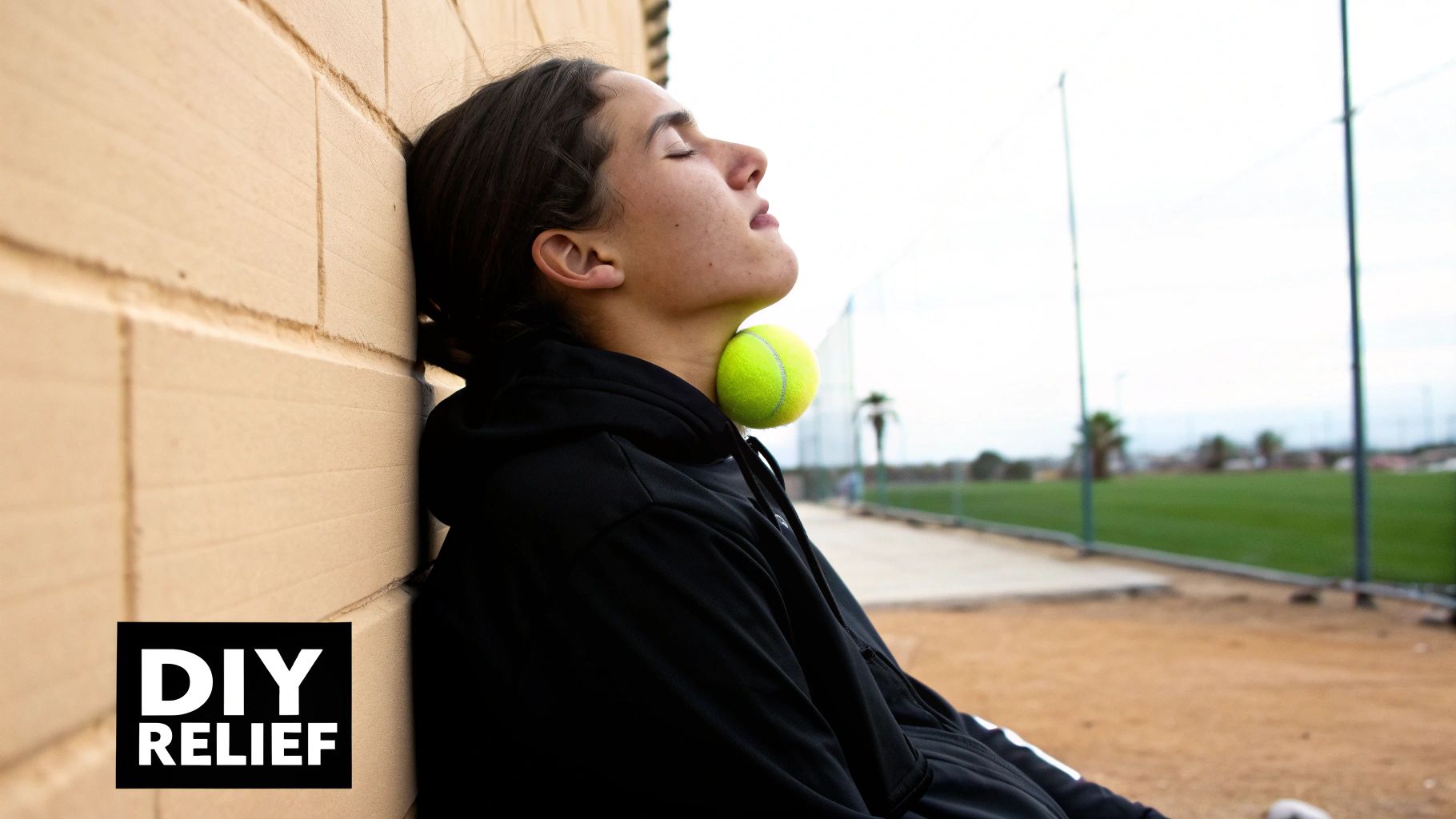
A good massage for neck and shoulder pain can feel like a miracle, but to make that relief stick, we need to look at our daily lives. Real, long-term freedom from pain comes from tackling the habits that cause the tension in the first place.
Think of massage as hitting the reset button on your muscles. Your daily lifestyle, however, is what dictates whether they stay loose and relaxed or tighten right back up. By making a few smart tweaks, you can stop those knots from creeping back in and build a stronger foundation for your body. This is how you turn a quick fix into lasting wellness.
Fine-Tuning Your Workspace for Comfort
Let's be honest: your desk setup is probably a bigger part of the problem than you think. For anyone who spends hours in front of a screen, poor ergonomics is almost always the main culprit behind that nagging neck and shoulder ache. The mission is to create a setup that supports your body in a neutral, relaxed posture.
Start by looking at your monitor. Is it directly in front of you? The top of the screen should be right at or just below your eye level. This one change alone prevents you from constantly looking down or craning your neck, which puts a ton of stress on your spine.
Now, what about your chair? A good chair should support the natural curve of your lower back. Your feet need to be flat on the floor, with your knees bent at about a 90-degree angle. If your chair isn't helping you out, don't worry—a small cushion for your lower back or a simple footrest can work wonders.
The single most important thing to remember for your workspace is alignment. Your ears should be stacked over your shoulders, and your shoulders over your hips. When you're aligned, your body weight is distributed properly, and your muscles don't have to work so hard just to hold you up.
Mindful Movement and Gentle Stretches
Beyond fixing your desk, weaving some gentle movement and stretching into your day is crucial. This is how you fight back against a sedentary routine. We're not talking about intense gym sessions, but small, restorative movements that keep you flexible and release that built-up tension.
Here are a couple of my favorite stretches you can do just about anywhere:
- Doorway Pectoral Stretch: Find a doorway and place your forearms on the frame, keeping your elbows just a bit below your shoulders. Step forward slowly until you feel a good stretch across your chest and the front of your shoulders. This is the perfect antidote to hunching. Hold it for 20-30 seconds.
- Chin Tucks: While sitting tall, gently pull your head straight back, as if you're trying to make a double chin, but without tilting your head. This simple move strengthens the deep neck muscles that get weak from poor posture. Hold for 5 seconds, relax, and repeat 10 times.
Turning these little movements into a daily habit is more powerful than you'd imagine. It's also important to choose the right kind of therapy when you need professional help. For instance, if your pain stems from sports or repetitive activity, it's worth exploring the differences between sports massage and regular massage to see which approach will give you the best results.
Answering Your Top Questions About Pain Relief Massage
When you're struggling with neck and shoulder pain that just won't quit, you're bound to have questions. Finding good answers is the first real step toward finding relief, so let's walk through some of the things people ask us all the time.
How Often Should I Actually Get a Massage for Chronic Pain?
For those stubborn, long-term aches in your neck and shoulders, consistency is everything. A single massage feels great, of course, but the real magic happens when you stick to a regular schedule. Think of it as retraining your muscles. Most therapists I know would suggest starting with weekly or bi-weekly sessions to really start breaking down those deep-seated tension patterns.
Once you start feeling a real difference—the knots aren't as angry and your range of motion improves—you can usually transition to a maintenance schedule. That might mean coming in once every three or four weeks. This approach helps you stay on top of the pain, catching minor flare-ups before they turn into a major setback.
It's not about a one-time fix. Regular massage is a long-term strategy that helps break the pain cycle and keeps your muscles from falling back into their old, tense habits.
Is It Normal to Feel Sore After a Massage?
Absolutely. It's especially common after a deep tissue or trigger point massage. I often tell my clients to think of it like the soreness you feel after a really good workout you haven't done in a while. The therapist is working on tight, knotted muscle fibers that haven't been getting much love, and that can leave you feeling a bit tender for a day or two.
The best thing you can do to ease this post-massage soreness is drink plenty of water. It genuinely helps flush out all the metabolic waste that gets released from your muscles during the session. A little bit of light, gentle stretching can also work wonders to prevent stiffness and help you recover faster.
What’s the Difference Between a Knot and a Trigger Point?
People often use these terms to mean the same thing, but there's a subtle and important distinction.
- A muscle knot is really just a catch-all term for any tight, hard band of muscle tissue. It’s that lumpy, dense spot you feel when you press on a sore area.
- A trigger point, on the other hand, is a very specific, extra-irritable spot within that tight band of muscle. What makes it a trigger point is its ability to cause "referred pain"—that is, it sends pain signals to other parts of your body in predictable patterns. A classic example is a trigger point in your upper shoulder that actually causes a tension headache or pain that shoots down your arm.
At La Moon Massage and Facial, our therapists are trained to find the true source of your discomfort, whether it's a simple knot or a tricky trigger point. If you're tired of temporary fixes and want to address the root cause of your neck and shoulder pain, take a look at the specialized massage services we offer.
Back Pain Massage Therapy: Effective Natural Relief Tips
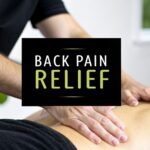
Why Your Back Hurts and How Massage Actually Helps
That constant, nagging ache in your lower back can feel like a mystery, but there’s a clear story unfolding just beneath your skin. Picture your back's complex network of muscles, bones, and nerves as a finely tuned suspension bridge. Each muscle is like a high-tension cable, and when one becomes too tight from things like poor posture, overuse, or stress, it starts to pull the entire structure out of alignment. This imbalance is often where the trouble begins.
The most common culprits behind back pain are muscular strain and tension. When muscles are stuck in a state of contraction, they don't just feel sore. They can also squeeze the sensitive nerves running through and around them, which is what sends those sharp pain signals to your brain. This constant tension also chokes off blood flow, stopping essential oxygen and nutrients from reaching the tissues and preventing waste products from being cleared away. This creates a painful cycle of inflammation and soreness that can turn simple movements into a major challenge.
The Science of Soothing Touch
This is where back pain massage therapy comes in, not as a luxury, but as a targeted solution to a physical problem. A skilled therapist isn't just rubbing your back; they are working to release the overtightened "cables" of that metaphorical bridge. The specific pressure and movements of a professional massage accomplish several crucial things:
- Boosts Circulation: The kneading and gliding motions physically push blood through congested areas. This action floods the muscles with fresh, oxygen-rich blood that is vital for healing.
- Breaks the Pain Cycle: Therapeutic touch helps convince chronically tight muscle fibers to relax, breaking the painful spasm cycle and bringing back flexibility.
- Changes How Your Brain Perceives Pain: Massage stimulates sensory receptors in your skin and muscles. These new signals can actually interrupt and override the pain signals traveling to your brain. It also prompts the release of endorphins, which are your body's own natural painkillers.
More Than Just a Feeling
The impact of back pain on daily life and the economy is huge. It is a leading cause for missed workdays, and Americans spend more than $50 billion every year trying to find relief. Research backs up what many already know: massage therapy is a legitimate and effective tool for managing the low back pain that causes so much widespread disability. To learn more about specific techniques for relief, check out our detailed guide on pain relief massage therapy.
By getting to the root causes of muscle tension and inflammation, massage offers a real path toward lasting comfort. For a deeper look at the data, you can explore the findings from the American Massage Therapy Association.
The Research That Changes Everything About Back Pain

While the soothing feeling of a good massage is something you can feel right away, it's reasonable to wonder if it's just a fleeting pleasure or a genuine medical treatment. Science has started to view massage as more than just a luxury, recognizing it as a credible, evidence-based approach for chronic back pain. Solid studies now show what many have long suspected: therapeutic touch sets off real, measurable healing processes in the body. It’s not simply about feeling good for an hour; it's about kickstarting your body’s own recovery mechanisms.
The reason back pain massage therapy works so well is that it tackles pain from several angles at once. It isn't a single action but a combination of biological responses working together to bring relief and promote healing.
Unlocking Your Body's Natural Pharmacy
One of the most important effects of massage is its ability to stimulate the release of endorphins. You can think of endorphins as your body's personal pharmacy, creating powerful pain-relieving chemicals that can be more effective than some over-the-counter medications. When a therapist applies skilled, targeted pressure, it signals your brain to release these natural mood-boosters and pain fighters.
At the same time, massage therapy helps to lower cortisol, the body's main stress hormone. Chronic pain and high stress often go hand-in-hand, creating a feedback loop where each one worsens the other. By reducing cortisol, massage helps break this cycle, shifting your body out of a constant "fight-or-flight" state and into a "rest and repair" mode that is essential for long-term healing.
Backed by Real-World Data
The evidence isn't confined to a laboratory; it's also seen in large-scale studies that track how people's lives improve. A key study published in Pain Medicine provided strong support for using massage in a real-world clinical setting. Researchers followed people with chronic low back pain who received massages from therapists in their communities.
The outcomes were clear: over 50% of the participants reported clinically meaningful improvements in their pain and ability to perform daily activities. This kind of data elevates back pain massage therapy from a simple alternative to a validated treatment choice, proving it can deliver tangible results. You can find more details about this research in the KYPROS study and its findings on pain medicine.
This growing body of research confirms that choosing massage is a scientifically supported decision for managing back pain. It’s a proactive way to get back your comfort and mobility, backed by clear evidence of its biological effects.
Finding Your Perfect Massage Match for Back Pain Relief
Choosing the right kind of back pain massage therapy is like picking the perfect tool for a home repair project—you wouldn't use a hammer when you need a screwdriver. Not every massage technique is the same, and the best one for you hinges entirely on the nature of your pain. Your body tells you what it needs through the specific discomfort you feel, and learning to read those signals is the first step toward finding real relief.
Matching the Technique to Your Pain
Think of your pain as a roadmap. A general, widespread ache that feels tied to stress and fatigue often responds wonderfully to Swedish massage. This classic technique relies on long, flowing strokes to encourage relaxation and boost circulation, gently easing tense muscles without aggressive pressure. It's a great choice if you're new to massage or dealing with broad, low-level discomfort.
On the other hand, if your pain is deep, stubborn, and located in specific spots—those hard, persistent knots that just won't budge—you'll need a more focused approach. Deep tissue massage is designed precisely for this, using slower, more forceful strokes to break down adhesions in the deeper layers of muscle and connective tissue. For those sharp, "bullseye" points of pain that sometimes send discomfort to other parts of your body, trigger point therapy works like a precision instrument, applying direct pressure to release the knot and soothe the irritated nerve.
To help you choose the right massage for your back pain, here's a table comparing some of the most effective techniques.
Table: Massage Techniques for Different Types of Back Pain
Description: Comparison of massage techniques, their benefits, and which back pain conditions they work best for.
| Technique | Best For | Pain Relief Level | Session Duration |
|---|---|---|---|
| Swedish Massage | General tension, stress-related aches, mild soreness | Mild to Moderate | 60-90 minutes |
| Deep Tissue Massage | Chronic muscle pain, knots (adhesions), limited mobility | Moderate to Intense | 60-90 minutes |
| Trigger Point Therapy | "Knots" that refer pain elsewhere, sciatica-like symptoms | Intense, Targeted | 30-60 minutes |
| Sports Massage | Injury prevention, muscle strain from overuse, post-activity recovery | Moderate to Intense | 60-90 minutes |
This table shows how different methods target specific issues, from the relaxing, broad strokes of Swedish massage to the focused intensity of trigger point therapy. The key is to match the technique to your symptoms for the best outcome.
The chart below visualizes the primary reasons people seek massage therapy for their back pain.
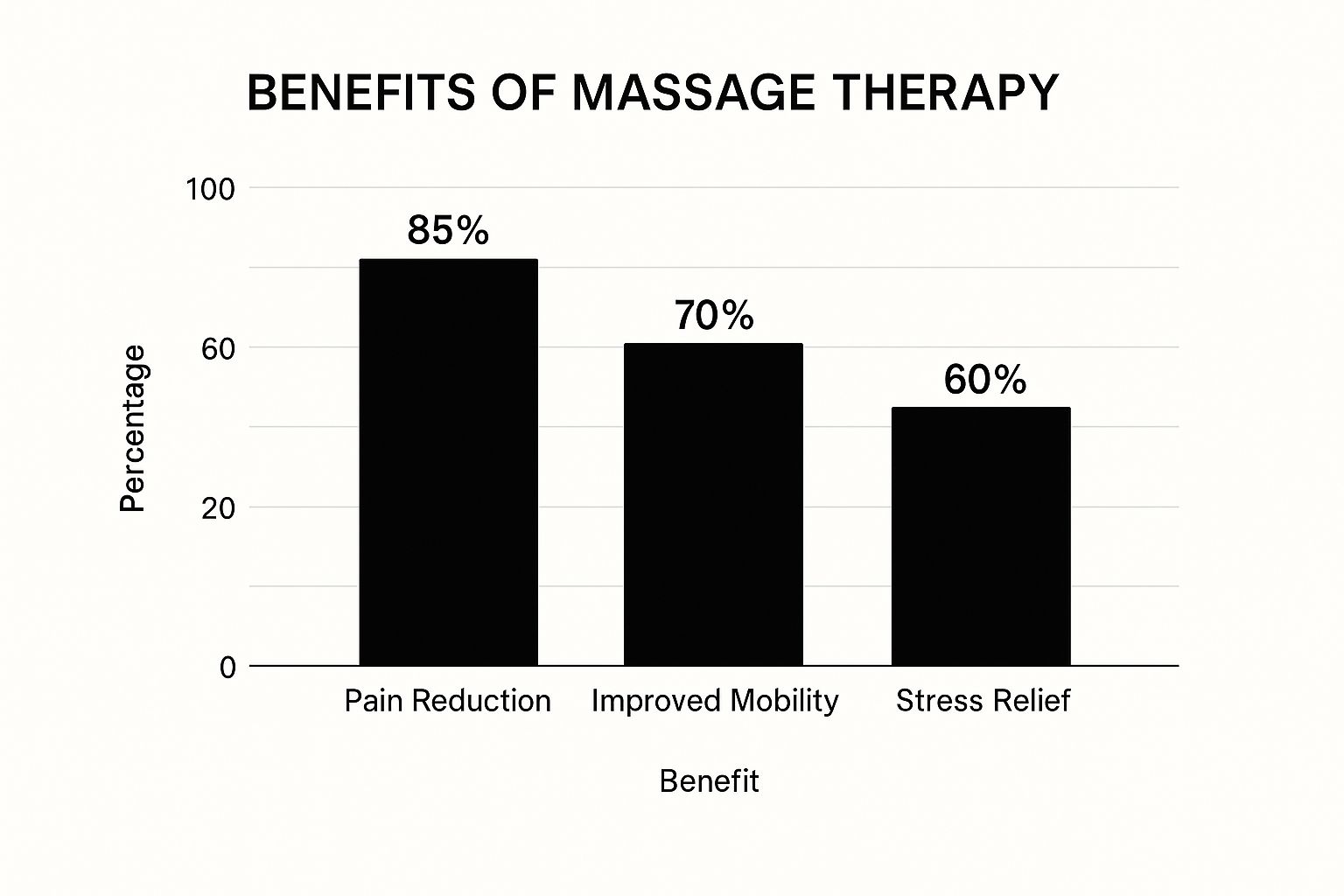
This data highlights a clear trend: while stress relief is a welcome side effect, an overwhelming 85% of individuals seek massage primarily for direct pain reduction. Improved mobility is another significant goal.
The Power of a Combined Approach
A truly effective massage therapist rarely uses just one technique. Instead, they act like a skilled mechanic, blending different methods in a single session to address your body's unique map of pain. For example, a session might begin with gentle Swedish strokes to warm up the muscles before moving to deep tissue work on a trouble spot in your lower back. This combined strategy prepares your body for more intensive work, leading to better results and a more comfortable and effective session overall. Knowing these options allows you to have a meaningful conversation with your therapist, helping you work together to create a treatment plan that truly addresses the root of your back pain.
Your First Session: What Really Happens Behind Closed Doors
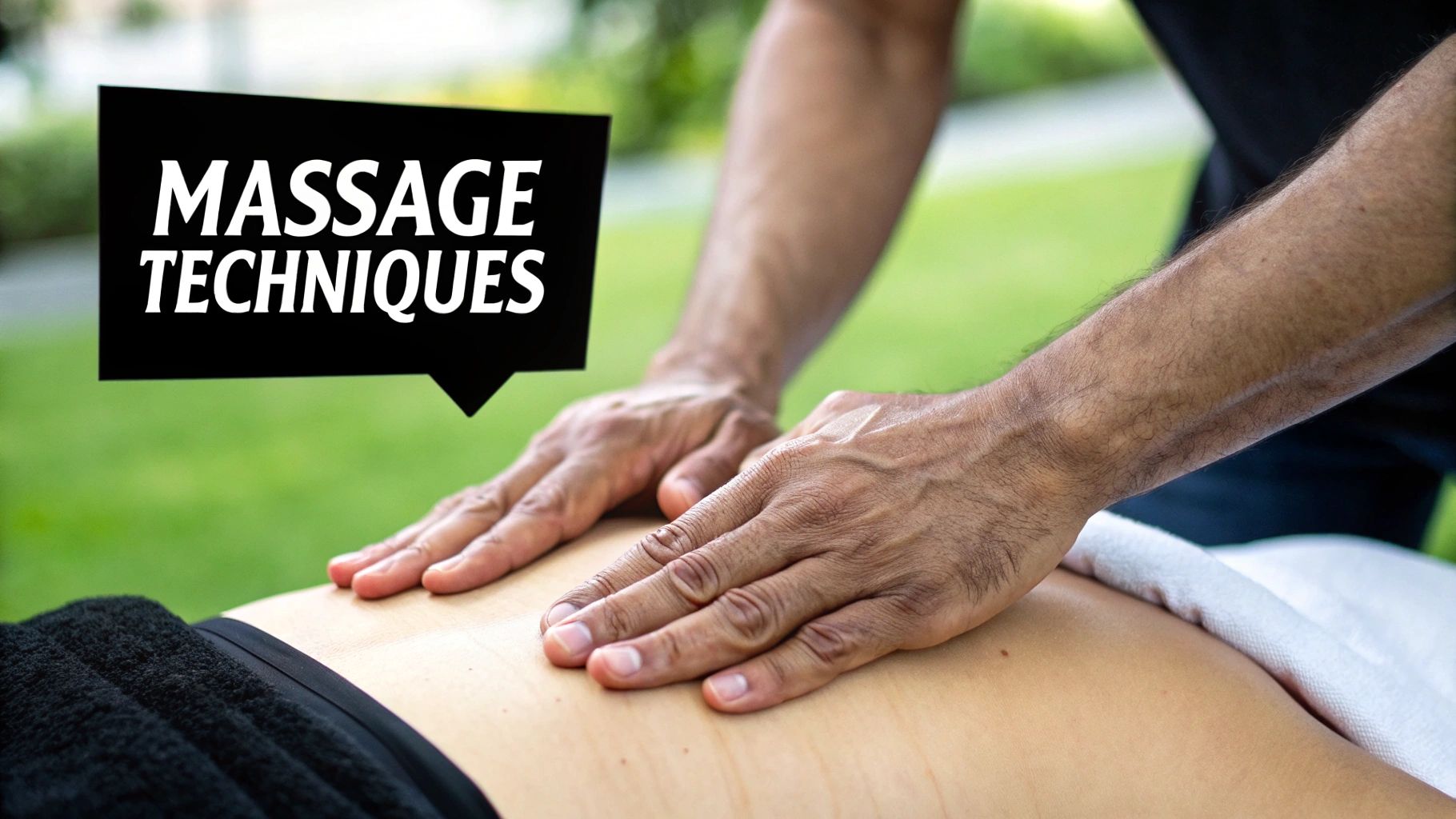
Walking into a massage room for the first time can feel a bit mysterious, but knowing what to expect can turn any apprehension into anticipation. A session for back pain massage therapy is more than just relaxation; it's a structured process designed to understand and relieve your specific discomfort. This experience starts well before any massage oil is even uncapped.
The Initial Conversation: Solving the Pain Puzzle
The first few minutes of your session are critical. Think of your therapist as a detective, asking focused questions to get to the root of your back pain. Where exactly does it hurt? What does the pain feel like—is it a dull ache, a sharp sting, or does it radiate elsewhere? What daily activities seem to make it flare up?
This initial chat is your time to share the full story of your pain. The more honest and detailed you are, the better. This information helps your therapist create a mental map of your muscles and choose the most effective techniques for you. After the discussion, they will leave the room, giving you privacy to undress to your comfort level and get settled under the sheet on the massage table.
During the Massage: Reading Your Body's Story
Once the hands-on work starts, your therapist is doing much more than following a script. They are reading your body's story through touch, identifying tight spots, inflammation, and knots you might not even know you had. Throughout this process, communication is a two-way street.
- Pressure is a dialogue: Your therapist will likely check in about the pressure they're using, but you should always feel empowered to speak up. A simple 1-to-10 scale can be a helpful way to communicate what feels right.
- "Good pain" vs. "bad pain": When a therapist works on a stubborn knot, you might feel an intense sensation often called "good pain." This is a productive feeling of release. However, if you feel any sharp, shooting, or unbearable pain, that’s a signal to stop. Never hesitate to say if something hurts too much.
- Breathing is your tool: As your therapist focuses on a tender area, concentrate on taking slow, deep breaths. This simple action helps your muscles relax and let go, making the treatment much more effective.
After the Session: The First Step in Recovery
When the massage is over, your therapist will give you a moment to get up slowly, as you might feel deeply relaxed or a little light-headed. They will almost certainly recommend drinking plenty of water. This helps your body flush out the metabolic waste that was released from your muscles during the session.
It's also perfectly normal to feel some soreness for a day or two afterward, similar to how you might feel after a good workout. This is called Delayed Onset Muscle Soreness (DOMS), and it's a sign that your muscles were worked effectively. You can ease this temporary discomfort with some gentle stretching or a warm bath.
Real People, Real Results: The Numbers Don't Lie
Inspiring success stories from people who found relief through **back pain massage therapy** are powerful, but the clinical data paints an even clearer picture. While personal testimonials offer hope, rigorous scientific studies provide the proof that this approach delivers real, measurable outcomes. This research helps us understand not just *if* massage works, but *how well* it works compared to other treatments.
Setting Expectations for Relief
Knowing what level of improvement you can realistically expect is an important part of any healing process. Some people feel a dramatic difference after a single session, but for most, consistent therapy brings the most significant and lasting results. Your personal timeline for improvement will depend on a few key factors:
- The chronicity of your pain: Pain that has been around for years (chronic) may take more sessions to address than a recent, acute muscle strain.
- The underlying cause: Discomfort from simple muscle tension often resolves more quickly than pain connected to long-standing postural issues or old injuries.
- Your consistency: Following a recommended treatment plan is essential for building on the progress you make in each appointment.
Think of it like this: the benefits of deep tissue massage build on each other over time, as each session works to release deeper layers of knotted muscle tissue. You can learn more about this powerful technique in our guide on deep tissue massage.
How Massage Stacks Up
When put to the test in a clinical setting, a structured massage therapy plan has shown impressive results. One significant clinical trial looked at how different hands-on therapies performed for subacute low back pain. The findings were compelling: at the one-month follow-up, an incredible 63% of patients who received a comprehensive massage therapy plan reported being completely free of pain.
This result was substantially better than the 27% who reported the same outcome from a less intensive soft-tissue manipulation group. This data shows that a dedicated massage therapy plan can provide a distinct advantage for achieving true recovery. You can read the full research about these back pain findings to see the detailed comparison.
Choosing a Therapist Who Actually Gets Back Pain
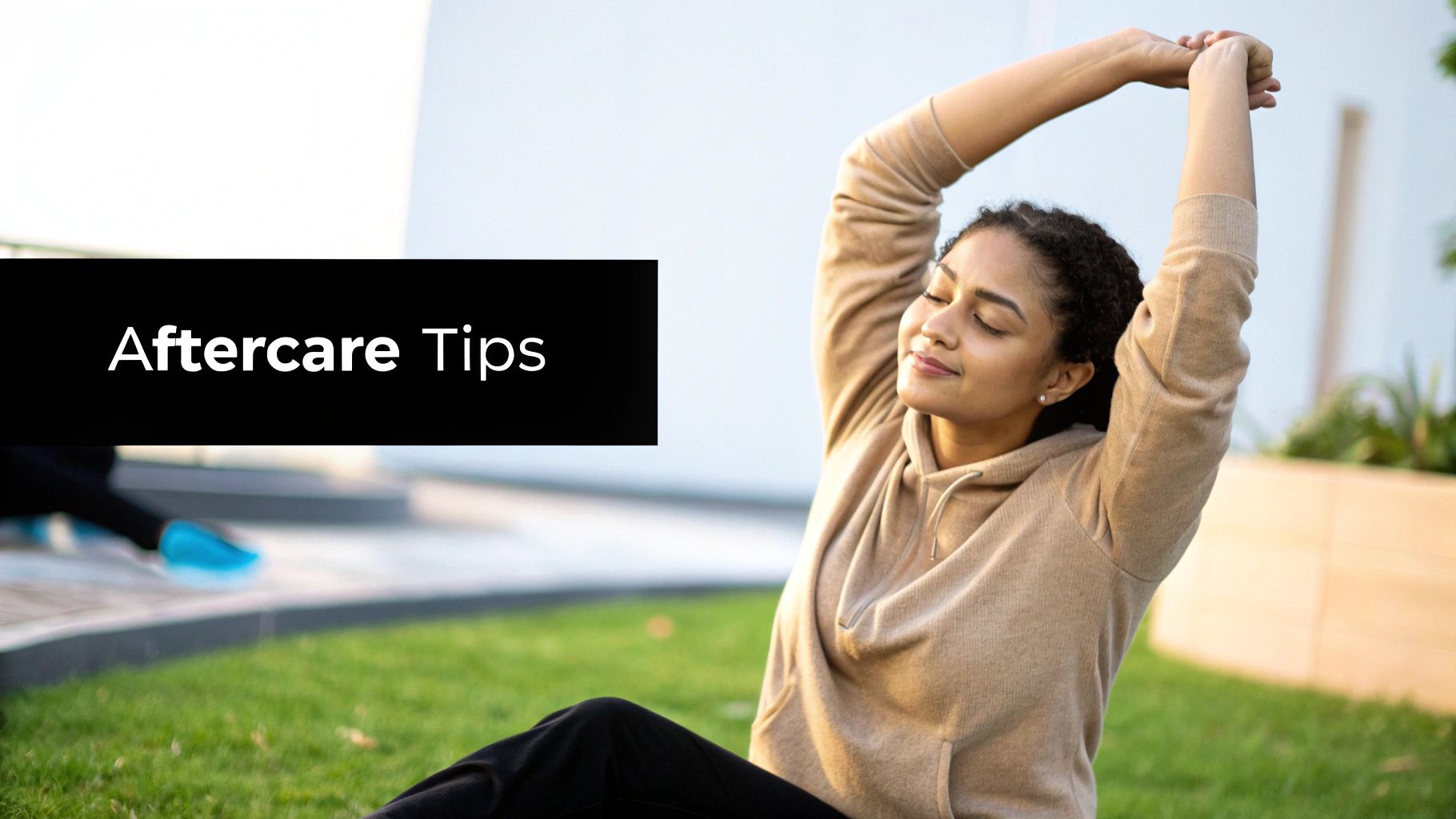
The success of your back pain massage therapy is almost completely dependent on the skill and knowledge of the person providing the treatment. Finding the right therapist isn't a matter of chance; it's about knowing what signals genuine expertise. You wouldn't hire a general contractor to fix a complex electrical problem, and similarly, you shouldn't entrust chronic back pain to a therapist without specialized training. The difference between a decent massage and a great one lies in a deep understanding of the body's mechanics and direct experience with conditions like yours.
Credentials That Signal Expertise
A state license is just the starting point—it's the bare minimum requirement to practice. For targeted, effective back pain relief, you need to find therapists who have pursued education well beyond the basics. These professionals have invested significant time to become specialists, not just generalists. Think of it this way: plenty of people can follow a recipe, but a true chef understands the science behind how flavors combine and react. A specialist therapist understands the science of pain, muscle function, and recovery.
When you're searching for a therapist, look for these indicators of advanced training:
- Medical Massage Practitioner (MMP): This certification shows a therapist has advanced training in outcome-based massage. They are skilled at working with specific medical conditions and developing treatment plans.
- Neuromuscular Therapy (NMT): Therapists with NMT certification are experts at locating and releasing trigger points—those tight, painful knots in muscles. They also address nerve compression issues that are a common source of radiating back pain.
- Myofascial Release Specialization: This signals expertise in treating the body's connective tissue, or fascia. When fascia becomes tight and restricted, it can cause widespread pain and limit movement.
- Experience with Specific Conditions: A therapist who regularly helps clients with sciatica, herniated discs, or postural strain will have a more refined set of techniques. For example, understanding the difference between a sports injury and chronic tension from office work is critical. You can learn more about how a sports massage vs. a regular massage can address different needs in our detailed comparison.
Asking the Right Questions
Once you've found a therapist who looks promising on paper, the consultation is your chance to verify their expertise. Don't feel hesitant to ask direct questions; this is a critical step for your health and recovery. Thoughtful questions will quickly show whether a therapist truly understands your condition or is just offering a one-size-fits-all approach.
To help you assess a potential therapist, we've created a guide with key qualifications and questions. Use this to ensure you're choosing someone with the right background to address your specific back pain.
| Therapist Qualifications and Specializations Guide |
| :— | :— | :— | :— |
| Qualification | Importance Level | What It Means | Questions to Ask |
| State Licensure | Essential | The therapist meets the legal minimum standard to practice in your area. | "Are you currently licensed in this state?" |
| Advanced Certifications (MMP, NMT, etc.) | High | They have pursued specialized training for complex conditions beyond basic massage school. | "What advanced certifications do you hold that are relevant to back pain?" |
| Experience with Your Specific Condition | High | They have a proven track record of successfully treating issues similar to yours (e.g., sciatica, disc issues). | "What is your experience treating clients with [your specific condition]?" |
| Clear Treatment Philosophy | Medium | They have a logical approach to how they assess and treat pain, not just a random assortment of techniques. | "What techniques do you find most effective for this type of pain, and why?" |
| Progress Tracking | Medium | They use objective measures to track your improvement, not just subjective feelings. | "How will we determine a treatment plan and measure my progress over time?" |
This table helps you go into a consultation prepared to identify a truly qualified professional.
Finding the right hands to help heal your back is the single most important decision in your recovery journey. A qualified, experienced, and specialized therapist offers more than temporary relief—they provide a clear, strategic path toward lasting wellness.
Making Every Session Count: Your Success Strategy
Getting fantastic results from back pain massage therapy isn't just about what happens on the table—it's about actively partnering in your own recovery. Think of your therapy as a team effort where you and your therapist work together. This teamwork starts before you even arrive for your appointment and continues long after you leave, and it's what truly boosts your progress.
Prime Your Body for Deeper Healing
Preparing for your session helps your therapist work more effectively and allows your body to get the most out of the treatment. It's like warming up before a workout; it makes your muscles more receptive to the work ahead.
- Hydrate Well: Drink plenty of water in the 24 hours before your massage. Well-hydrated muscles are more pliable, which helps the therapist work deeper and can reduce post-session soreness.
- Gentle Movement: A light walk or some simple stretches before your session can increase blood flow to tight areas. This gentle warm-up signals to your muscles that it's time to relax.
- Arrive Calm: Rushing to your appointment can make you feel tense and flustered. Plan to arrive a few minutes early so you can sit quietly and take a few deep breaths, helping shift your body into a more relaxed state.
Extend Your Results for Days, Not Hours
The hour after your massage is just as important as the hour on the table. Your actions in the 24-48 hours that follow can either lock in your progress or accidentally undo the therapist's hard work. To keep feeling great, here's what to do:
- Rehydrate Immediately: Continue drinking water to help your body flush out the metabolic waste that was released from your muscles during the session.
- Take a Warm Bath: Soaking in an Epsom salt bath can be a game-changer. The magnesium in the salts helps soothe muscles and minimize any lingering soreness. This occasional soreness is a normal response, sometimes called Delayed Onset Muscle Soreness (DOMS).
- Avoid Strenuous Activity: Give your body time to adjust to its new, more relaxed state. Steer clear of heavy lifting or intense exercise for at least a day to prevent re-straining the muscles that were just released.
Building a Sustainable Long-Term Plan
Lasting relief from back pain is built on consistency and making smart choices between your massage sessions. Simple stretches that target your specific problem areas can make a huge difference—your therapist can show you the best ones for your body. Also, pay attention to your daily posture and workspace setup, as these are often the root causes of chronic back pain. Small adjustments to how you sit, stand, and lift can prevent pain from returning.
By taking an active role in your treatment, you turn each massage from a temporary fix into a meaningful step toward long-term wellness.
Ready to take control of your back pain? At La Moon Massage and Facial, our expert therapists are ready to partner with you on your path to recovery. Book your personalized session today and feel the difference.
Massage for Sports Injuries: Your Complete Recovery Guide

Why Sports Injury Massage Actually Works
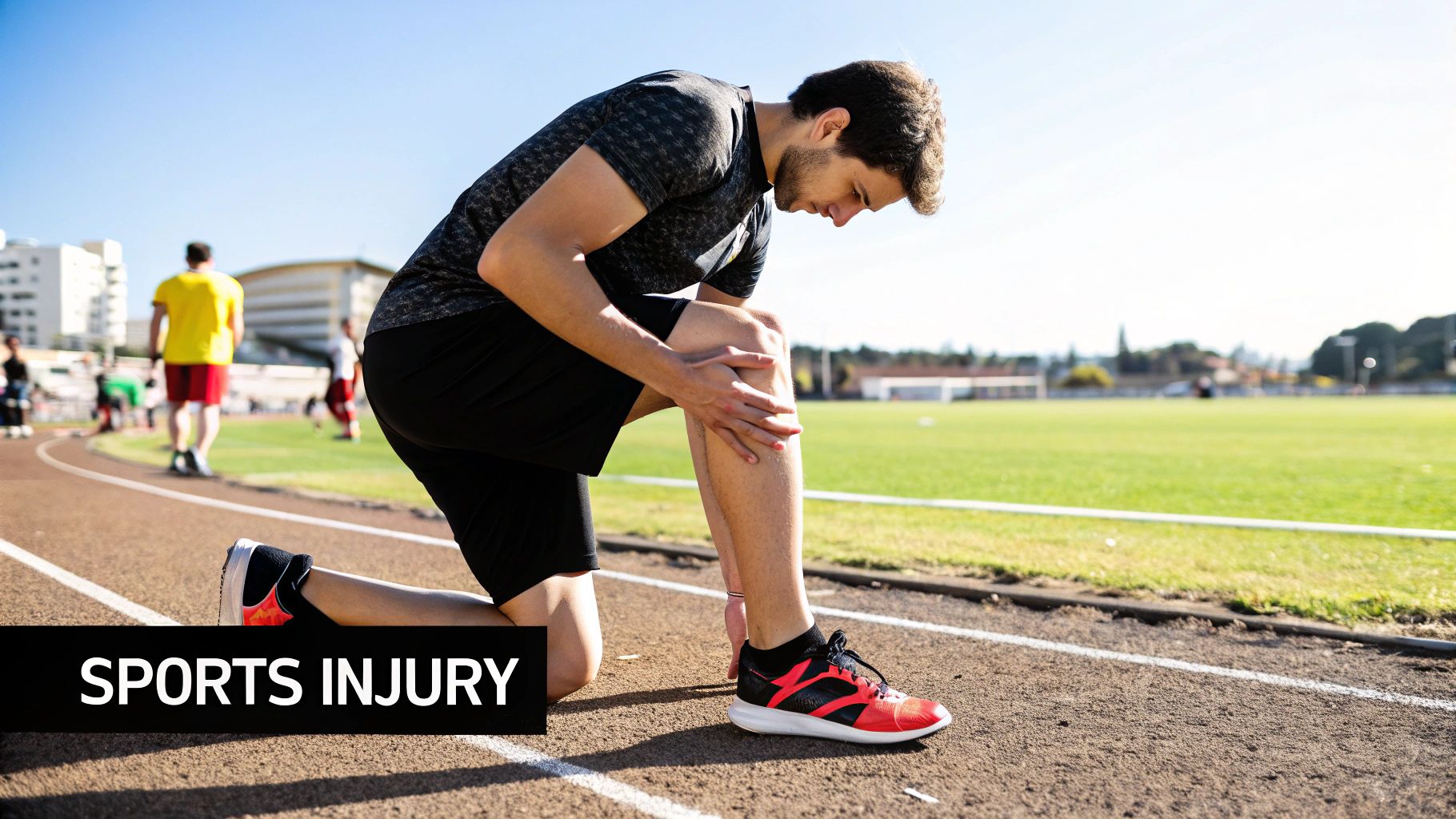
It’s easy to think of massage as a simple luxury, something you treat yourself to on a spa day. But when a sports injury puts you on the sidelines, that view doesn't tell the whole story. A targeted massage for sports injuries isn’t about simple relaxation; it’s a strategic and effective tool for recovery. Think of it less like a gentle comfort and more like a skilled mechanic fine-tuning a high-performance engine. While rest is crucial, skilled hands can actively speed up the body's repair work, getting to the root of pain and dysfunction in a way that just waiting it out cannot.
The power of this approach is more than just talk; it's rooted in how your body responds to specific pressure and manipulation. A specialized massage helps you regain function faster than rest alone, making it a key part of modern athletic rehabilitation. In fact, its importance has been recognized worldwide. A significant review of 37 different studies confirmed its effects on pain management, nervous system regulation, and the biochemical processes of healing. You can explore these findings in more detail on the International Journal of Therapeutic Massage & Bodywork to see the science behind it.
Realigning Your Body’s Repair System
After an injury, imagine your muscles and connective tissues are like a tangled bundle of ropes—knotted, tight, and unable to work correctly. A sports injury massage acts to carefully untangle these knots. This process goes beyond relieving tension; it triggers several key functions that encourage healing and help prevent future issues.
This focused approach helps to:
- Boost Circulation: The pressure from the massage acts like opening a vital supply line, encouraging more blood to flow to the injured area. This delivers a fresh wave of oxygen and nutrients that damaged tissues need to rebuild themselves.
- Reduce Swelling: By manually stimulating the lymphatic system, a massage can help drain excess fluid and calm inflammation, which is often a major source of pain and limited movement.
- Break Down Scar Tissue: When the body heals, it often creates scar tissue that is stiff and can restrict movement. Therapeutic massage helps to break down these adhesions, improving flexibility and helping you regain a normal range of motion.
Beyond the Physical Touch
The benefits also reach deep into your nervous system. A skilled therapist can essentially help "retrain" your body’s pain signals. By stimulating nerve receptors in the muscle and skin, the massage can interrupt the pain messages traveling to your brain. This gives the muscle a chance to relax, allowing the healing cycle to start without the constant distraction of pain.
This is why sports massage therapy is a game-changer for recovery. It's not just about feeling better in the moment. It's about creating the ideal physiological environment for your body to heal itself more effectively. This intentional, science-backed method is what separates true therapeutic work from a standard relaxation massage.
The Science Behind Your Body's Healing Response
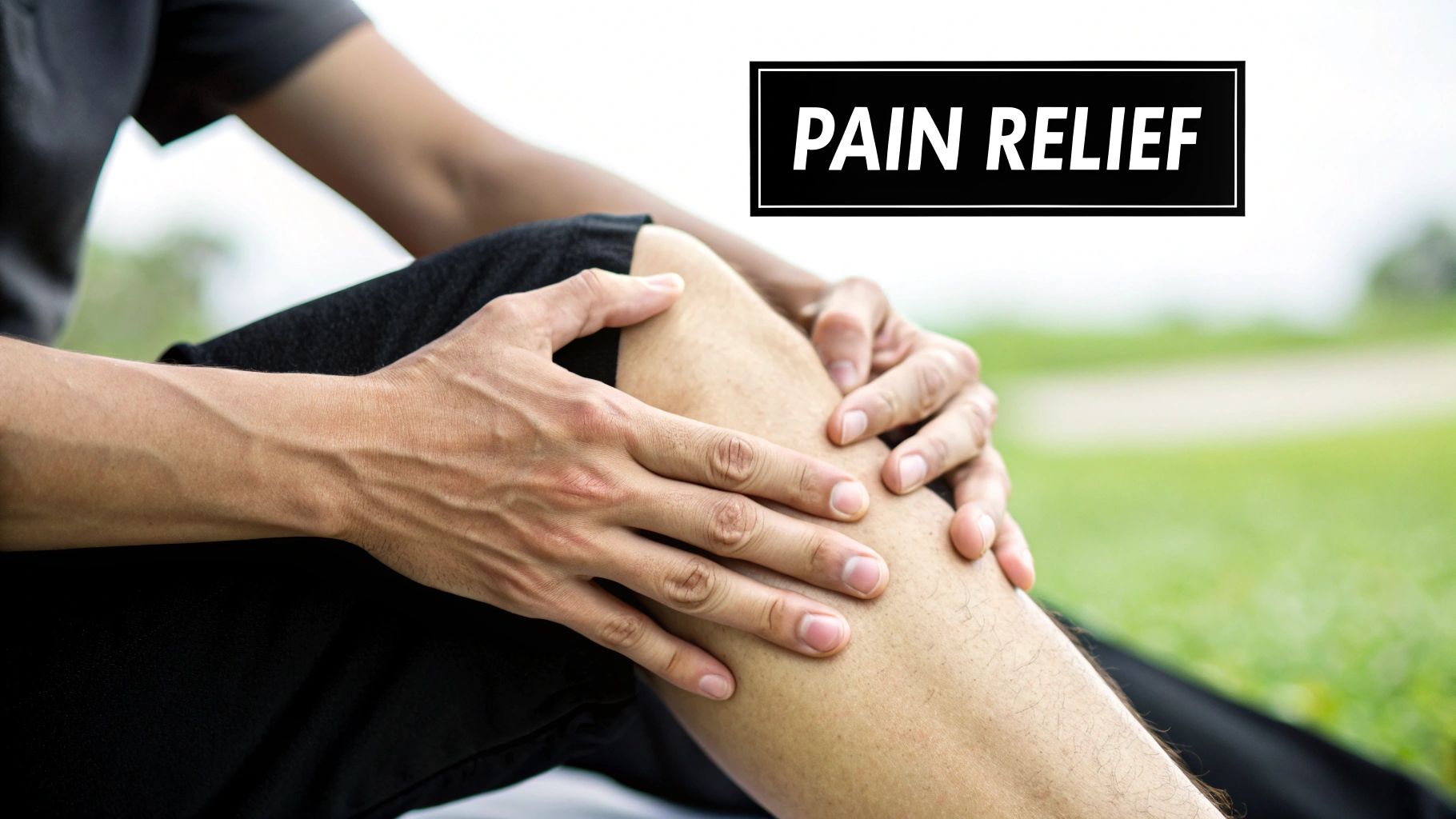
The immediate relief you feel from a massage for sports injuries isn’t just a pleasant sensation; it’s the result of powerful biological processes happening right under your skin. When you get hurt, your nervous system sends out a flood of pain signals. Think of it as your body's alarm system, firing off urgent alerts to your brain that something is wrong. The right therapeutic touch acts as a skilled negotiator, calming this alarm down.
This quick relief is explained by a concept called the pain gate control theory. Picture the nerve pathways to your brain as a series of gates. After an injury, the gates for pain signals swing wide open. The pressure and movement from a massage create a different signal—touch—which travels on faster nerve fibers. These touch signals race to the gate and effectively close it before many of the slower pain signals can pass through. This is why you often feel pain melt away during a session; the massage is literally running interference.
Shifting from “Fight-or-Flight” to “Rest-and-Digest”
Beyond simply blocking pain, therapeutic touch triggers a fundamental shift in your entire nervous system. It helps your body switch from the sympathetic nervous system (the "fight-or-flight" response) to the parasympathetic nervous system (the "rest-and-digest" state). When you're injured and in pain, your body is on high alert, ready for a threat. A targeted massage signals that it’s safe to stand down and focus on recovery.
This calming shift is crucial for healing. It lowers stress hormones like cortisol and creates a state of deep relaxation where your body's natural repair crews can get to work. With the alarm bells silenced, other vital healing processes can begin. The physical manipulation of muscles boosts blood flow, delivering a fresh supply of oxygen and nutrients to the damaged tissues. At the same time, it improves lymphatic drainage, your body's internal cleaning system that removes waste products and reduces swelling. It's like a cleanup crew clearing debris from a worksite so the rebuilding can start.
How Massage Kickstarts Your Internal Healing Cascade
The benefits are further amplified by the release of your body's own powerful chemicals. As you relax and circulation improves, your brain is prompted to produce endorphins—natural chemicals that act as painkillers and mood elevators. This creates a positive feedback loop: the massage eases pain through the pain gate mechanism, which in turn triggers the release of more pain-relieving endorphins, further calming the area.
To help you see how these different actions work together, this table breaks down the key massage mechanisms and their direct benefits for injury recovery.
Massage Mechanisms vs. Healing Benefits
Comparison of different massage mechanisms and their corresponding healing effects on sports injuries
| Massage Mechanism | Physiological Effect | Injury Benefit | Recovery Timeline |
|---|---|---|---|
| Mechanical Pressure | Boosts local blood flow and fluid exchange. | Delivers nutrients; clears metabolic waste. | Immediate to short-term |
| Nerve Stimulation | Activates the pain gate and parasympathetic system. | Reduces immediate pain; lowers stress. | Immediate to short-term |
| Myofascial Manipulation | Breaks down adhesions and knots in connective tissue. | Restores flexibility and normal movement patterns. | Short-term to long-term |
| Systemic Relaxation | Triggers the release of endorphins. | Elevates mood and provides natural pain relief. | Short-term to long-term |
This table shows that while some benefits like pain relief are immediate, others like restoring flexibility happen over time, highlighting the value of consistent therapy.
Ultimately, a massage for sports injuries is a way to communicate directly with your body’s built-in healing systems. By applying the right techniques, a therapist can guide these systems to work more efficiently, speeding up your return to the activities you love.
Choosing the Right Massage Technique for Your Injury
Stepping into the world of massage for sports injuries can feel a bit like opening a mechanic's toolbox. You wouldn't use a sledgehammer to fix a sensitive engine part, and in the same way, a therapist won't apply the same technique to a torn hamstring as they would for chronic shoulder tightness. Using the wrong approach at the wrong time can actually slow down your recovery or, worse, cause more harm.
To get the most out of your treatment, it helps to understand the different "tools" a therapist has at their disposal. Each massage style is built to solve a specific problem within your muscles and the web of connective tissues surrounding them. Think about your injury: is it a deep, stubborn knot? A widespread feeling of tightness? Or a sharp, specific point of pain? The answer helps guide the therapist to the right solution.
Matching the Technique to the Problem
Let's break down some of the most common and effective techniques used in sports injury recovery. Each one works on a different level within the body, offering unique benefits for different types of injuries.
-
Deep Tissue Massage: This is the powerful wrench in the toolkit, designed to reach the deeper layers of muscle and connective tissue. Using firm pressure and slow, deliberate strokes, it's perfect for breaking up the chronic muscle tension and adhesions—those stubborn "knots"—that cause pain and restrict your movement. It's especially useful for nagging issues like persistent lower back pain or tightness in your calves.
-
Myofascial Release: Picture your muscles wrapped in a thin, cling-film-like layer called fascia. After an injury or overtraining, this fascia can become tight and bunched up, pulling on your muscles and causing pain, sometimes in completely different areas. Myofascial release uses gentle, sustained pressure to slowly stretch and "unstick" these fascial layers, restoring smooth movement and relieving that locked-up feeling. It's a go-to for problems like IT band syndrome or plantar fasciitis.
-
Trigger Point Therapy: Have you ever pressed on a sore spot in a muscle and felt a jolt of pain somewhere else? That’s a trigger point—a small, hyper-irritable knot. This therapy zeros in on these spots, applying direct, focused pressure to deactivate them. By interrupting the pain signals and encouraging the muscle to let go, it can offer quick relief from referred pain, like a knot in your shoulder that causes headaches.
The value of these targeted approaches is well-known among athletes. In fact, research shows that 99% of athletes who receive sports massage find it helpful and would recommend it. The most commonly treated areas—the thighs (56%), glutes (43%), hamstrings (37%), and back (37%)—are often ground zero for sports-related strain, making these therapies vital for recovery. You can read more about these findings in this massage therapy position statement.
When to Choose a Gentler Approach
While intense techniques are great for chronic issues, they aren't always the answer, especially for new injuries. If you're dealing with an acute injury, like a freshly pulled muscle that's still inflamed, a gentler touch is required.
This is where Swedish massage comes in. Known for its long, flowing strokes, it improves circulation and promotes relaxation without aggravating the inflamed tissue. It helps calm the nervous system and can gently reduce swelling, preparing your body for more focused work once the initial healing phase has passed.
Perfect Timing: When to Get a Massage for Maximum Recovery
Understanding when to get a massage for sports injuries is just as important as the technique itself. Think of your body’s recovery process like tending to a garden. You wouldn't water a freshly planted seed the same way you'd care for a mature plant. Applying the right treatment at the right time helps your body heal stronger, while the wrong approach can cause a setback.
The first 48-72 hours after an injury are known as the acute inflammatory phase. This is when your body rushes healing cells to the site, causing swelling and sensitivity. Applying deep pressure during this window is counterproductive—it can worsen inflammation and pain. Instead, the focus should be on gentle methods that calm the area and encourage fluid drainage.
Navigating the Three Phases of Healing
Your body doesn't just flip a switch from "injured" to "healed." It follows a predictable, three-stage process. Matching the massage style to your current healing phase is the key to a successful recovery.
- Inflammatory Phase (First 2-3 Days): The main goal is to manage pain and swelling without disrupting the body's natural first response. Extremely light strokes, such as lymphatic drainage, performed away from the direct injury can help reduce the fluid buildup that causes pressure and discomfort.
- Repair Phase (Day 3 to 6 Weeks): Once the initial swelling goes down, your body begins its construction project, laying down new collagen fibers to mend the damaged tissue. This is the perfect time for more targeted techniques like cross-fiber friction, which helps these new fibers form in a strong, organized pattern, preventing stiff scar tissue. Gentle stretching can also be introduced to improve mobility.
- Remodeling Phase (6 Weeks to 12+ Months): In the final stage, the body works to strengthen and refine the repaired tissue, making it more like the original. This is when deep tissue massage and myofascial release truly shine. These techniques break down any lingering adhesions and restore the tissue's full strength and flexibility. For runners struggling with persistent issues, you can find specific strategies in our guide on sports massage for runners.
To help you and your therapist decide on the best course of action, this table outlines which techniques are most appropriate for each phase of healing.
| Injury Phase | Timeframe | Recommended Techniques | Frequency | Expected Outcomes |
|---|---|---|---|---|
| Inflammatory Phase | First 48–72 hours | Very light lymphatic drainage, gentle effleurage (away from the injury) | 1 session (if any) | Reduced swelling, pain management, promotion of healing environment |
| Repair Phase | Day 3 to 6 weeks | Gentle cross-fiber friction, trigger point therapy, light stretching | 1-2 times per week | Improved circulation, prevention of scar tissue, increased range of motion |
| Remodeling Phase | 6 weeks to 12+ months | Deep tissue massage, myofascial release, active release techniques | 1 time per week or bi-weekly | Breakdown of adhesions, restored tissue elasticity, improved muscle function |
This guide shows how massage evolves from a gentle, supportive role in the early days to a more intensive, corrective tool as your body rebuilds and strengthens itself over time.
When to Absolutely Avoid Massage
While massage is a fantastic recovery tool, there are specific situations where it should be avoided. These are known as contraindications, and ignoring them can be harmful.
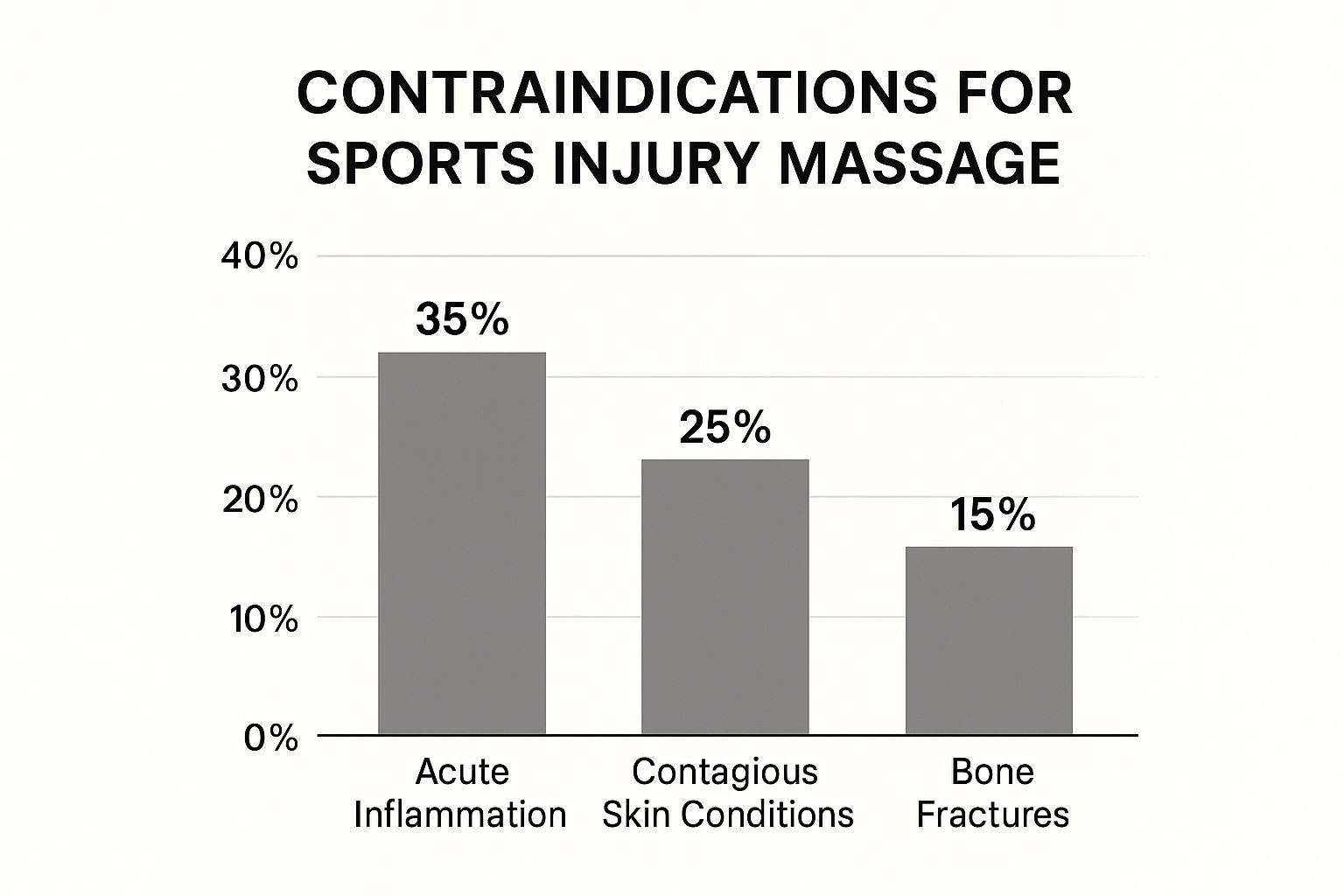
As the data clearly shows, acute inflammation is the number one reason to postpone a massage, accounting for 35% of cases. This highlights how critical it is to let initial swelling calm down before applying direct pressure. Always be transparent with your massage therapist about your injury's timeline and any other health conditions to ensure your treatment is both safe and effective.
Real Recovery Stories: Athletes Who Beat the Odds

While the science is clear, the true impact of massage for sports injuries is best told through the stories of real athletes. These aren't just feel-good anecdotes; they are powerful examples of how skilled bodywork can turn a major setback into a comeback story. From elite athletes avoiding career-ending surgery to everyday people getting back to the activities they love, these accounts show what’s possible when science-backed techniques are applied with expertise.
Take the story of a competitive cyclist who was sidelined by chronic iliotibial (IT) band syndrome. After months of pain and little progress with just rest and stretching, her season was essentially written off. But then, she started a focused treatment plan of myofascial release and deep tissue massage. By breaking down the stubborn knots and adhesions along her outer thigh, the therapy restored healthy movement and eased the painful friction at her knee. Within weeks, she was back on her bike, competing at a higher level than before her injury.
From Weekend Warriors to Aging Competitors
This kind of success isn't just for professionals. A weekend tennis player who suffered a painful rotator cuff strain thought his days on the court were over. He faced a long and uncertain recovery. By combining trigger point therapy with specific stretches, his therapist was able to release the tight knots in his shoulder and back. This method didn't just mask the pain; it fixed the underlying muscle imbalance, giving him back his range of motion and his confidence to play again.
These personal experiences are backed by a broad consensus among athletes. A study looking at athletes' opinions on sports massage therapy found that over 90% believe it boosts blood flow, which in turn helps reduce muscle fatigue. This is a key element for both recovery and preventing future injuries. You can read more about these findings in the full AMTA position statement.
The Measurable Impact on Recovery
Beyond individual stories, research shows the clear advantages of adding massage to a recovery plan. Studies consistently demonstrate that therapeutic massage can:
- Accelerate Recovery Time: Evidence indicates that regular massage can shorten recovery time by up to 40%, allowing athletes to return to their sport much sooner than with rest alone.
- Improve Mobility: Massage is often more effective than static stretching for improving range of motion because it releases the tight connective tissue (fascia) that limits movement.
- Lower Re-Injury Rates: By breaking down scar tissue and correcting muscle imbalances, massage for sports injuries helps ensure the repaired tissue is both strong and flexible. This greatly reduces the chances of the same injury happening again.
These outcomes are why more sports medicine doctors, physical therapists, and athletic trainers see massage not just as an extra but as a core part of an effective rehabilitation program.
The Expanding World of Sports Massage Therapy
The recent growth in sports massage availability is more than just a passing trend. It's a direct response to clear results and a rising demand from athletes at all levels. As more people embrace active lifestyles, the need for effective treatment for sports injuries has powered a significant increase in specialized therapists and new methods. This growth makes high-quality massage for sports injuries more accessible than ever.
This expansion is happening for one simple reason: it works. The global massage therapy service market was valued at about USD 18.25 billion in 2023, and the sports massage segment is expected to grow at a compound annual growth rate of 9.4% through 2030. This growth shows the increasing confidence athletes have in this therapy for both recovery and performance. You can find more details about this market expansion on Grandview Research. This industry progress means better access to care, stricter training standards for therapists, and more affordable treatment options for you.
What This Growth Means for You
The expansion of sports massage offers real benefits for anyone recovering from an injury or trying to prevent one. With more qualified therapists in the field, it's becoming much easier to find a professional who specializes in your particular sport or injury. This specialization ensures the care you receive isn't generic but is designed specifically for your body's unique demands.
This growth has also driven progress in training and technology. Here’s what you can expect:
- New Certification Programs: Therapists are now obtaining advanced certifications focused on athletic injuries, making sure they have a deep understanding of anatomy and recovery science.
- Integration with Healthcare: Sports massage is increasingly viewed as a key part of a complete healthcare plan. Therapists are now working alongside physical therapists and doctors to create a unified recovery strategy.
- Emerging Technologies: New tools are helping therapists deliver even better results. For instance, percussion therapy devices can supplement manual techniques to release deep muscle tension. Advanced assessment tools also help therapists spot muscle imbalances before they become serious injuries.
While navigating a larger field of providers might seem difficult, it ultimately gives you the power to find the perfect match. By understanding the benefits of sports massage, you can ask the right questions and select a therapist who can truly support your recovery goals. The increasing professionalization of the industry ensures you have more high-quality options than ever to help you heal and get back in the game.
Your Action Plan for Sports Injury Recovery Success
Now that you understand the different techniques and the best times to use them, let's build a recovery strategy that actually works. A solid plan for massage for sports injuries is more than just general tips; it’s a personalized roadmap for your specific injury, training demands, and future goals. The foundation of this plan is finding the right professional who can guide you through recovery.
Think of your therapist as a specialized coach for your healing journey. You need someone with the right expertise, background, and communication skills to get you back in the game. Starting your search by asking the right questions is crucial for building a strong partnership and ensuring you get effective care from day one.
Finding Your Ideal Therapist
Choosing a qualified practitioner is the most important step in your action plan. Not every massage therapist focuses on sports-related injuries, so it's vital to find someone with a specific background in this area. When you're looking at potential therapists, be ready with some direct questions to see if they're the right fit.
Here are a few key questions to start with:
- What is your experience with my specific injury? (For example, a rotator cuff tear or shin splints)
- What certifications or extra training do you have in sports massage or injury rehab?
- How do you work with other healthcare providers, like physical therapists or doctors?
- What can I expect during our first session and in future treatments?
It's just as important to know what to watch out for. Certain red flags might suggest a practitioner isn't suited to treat your sports injury.
Be wary of a therapist who:
- Promises a complete "cure" after only one or two sessions.
- Brushes off the importance of a diagnosis from a doctor or physical therapist.
- Applies the same generic approach to every client and injury.
- Causes a lot of pain without a clear therapeutic reason and open communication.
Building a Consistent and Effective Treatment Plan
Once you've found the right therapist, the next step is to create a treatment plan you can stick with. Consistency is essential. Occasional sessions are much less helpful than a structured program. Work with your therapist to figure out the best frequency and length for your sessions, based on where you are in the healing process and how you're progressing.
Set realistic goals for your recovery. Healing is a process that takes time, and you might have ups and downs along the way. Maintain open communication with your therapist, giving them feedback during and after each session. This allows them to adjust their techniques and pressure to make your massage for sports injuries treatment as effective as possible. By being an active participant, you turn passive treatment into a powerful, collaborative effort that helps you return to peak performance safely.
Ready to create your personalized recovery plan? The expert therapists at La Moon Massage and Facial are committed to helping athletes like you heal and get back to what you love. Book your appointment with us today and start on your path to success.
Pain Relief Massage Therapy Guide: Transform Your Healing
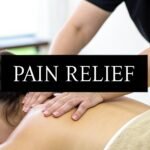
What Pain Relief Massage Therapy Really Does For You
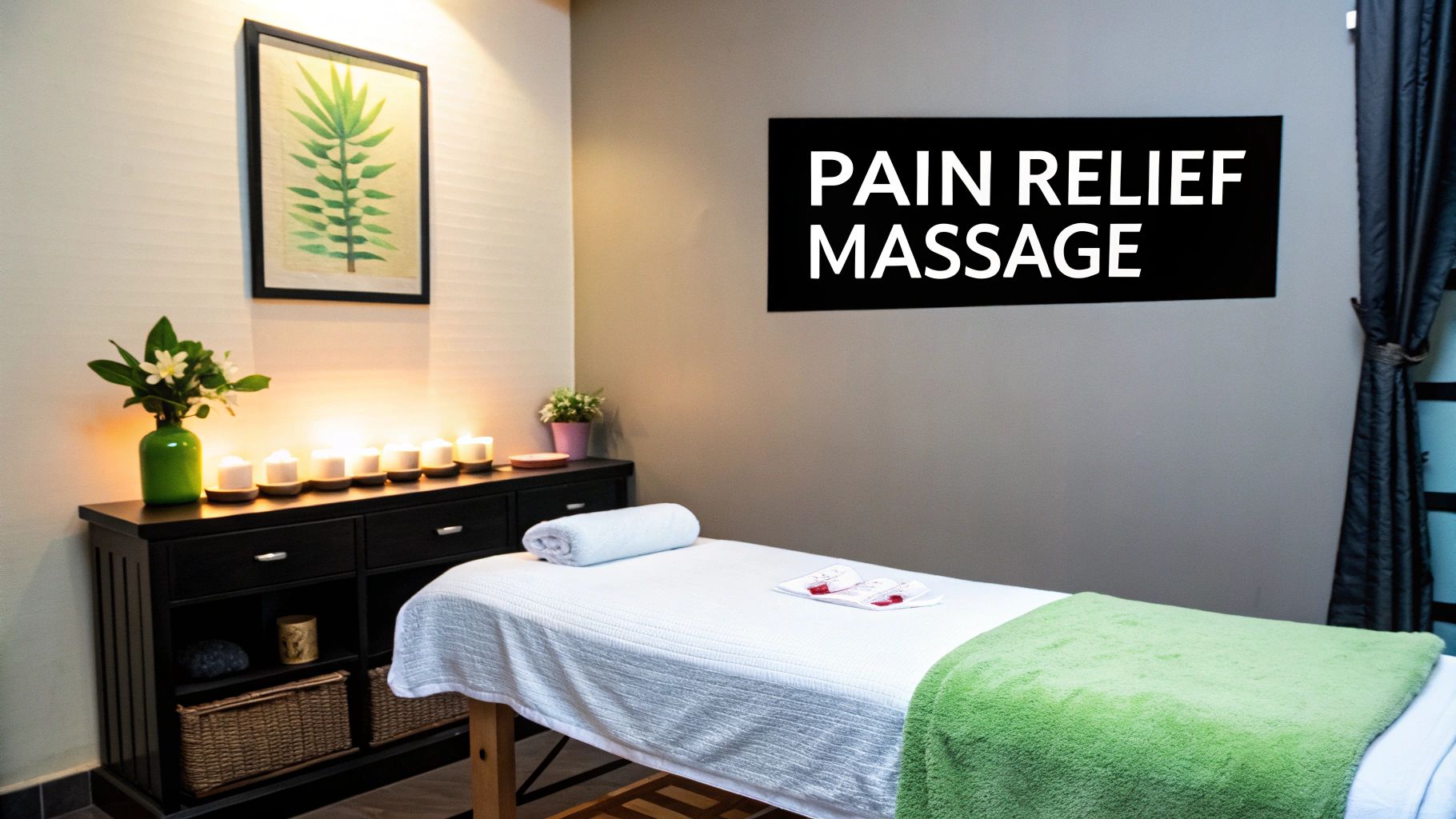
Let's clear up a common misconception: pain relief massage therapy is far more than a simple spa indulgence. It is a targeted, health-focused practice that has rightfully earned its place in modern medicine. Think of chronic pain as a faulty car alarm that keeps blaring long after any threat has passed. A skilled massage therapist acts like a specialized technician, working to reset your body's overactive alarm system and quiet those persistent pain signals.
This isn't just about feeling good for an hour; it's about creating lasting, positive change. The proof is in the numbers. In a single recent year, Americans received 214 million massages, and a significant 62% of them were for medical or health reasons. Of that group, almost half were specifically seeking help with pain management, injury recovery, or migraine control. In fact, a remarkable 88% of consumers agree that massage is effective for reducing pain. To learn more about its applications, our guide on what is therapeutic massage offers deeper insights.
Beyond Relaxation: The Goal-Oriented Approach
Unlike a general relaxation massage meant to soothe and de-stress, a therapeutic session is highly goal-oriented. The main objective is to address a specific physical issue, whether it's chronic lower back pain from sitting at a desk all day or restricted shoulder mobility from a sports injury.
A therapist employs a combination of techniques to achieve specific outcomes, such as:
- Releasing Muscle Knots: These tight, painful areas, also known as trigger points, can send pain signals to other parts of the body.
- Improving Circulation: Better blood flow brings vital oxygen and nutrients to injured tissues, which helps speed up the healing process.
- Breaking Down Adhesions: Therapists work to release scar tissue and fascial restrictions that can limit movement and cause stiffness.
Real-World Transformations
This focused approach leads to tangible improvements in daily life. Imagine an office worker who finally gets relief from persistent tension headaches, or an athlete who can return to their sport more quickly after an injury. Each session is a step toward restoring function and enhancing your quality of life. The focus is always on understanding the root cause of your discomfort and applying precise techniques to correct it, making it a crucial part of any wellness plan. You can find out more about the widespread use of massage for health from these massage therapy profession statistics.
How Your Body Actually Heals Through Therapeutic Touch
To understand how pain relief massage therapy works, think of your nervous system as a sophisticated communication grid. When you get injured, this grid correctly flags the issue, sending pain signals to your brain. With chronic conditions, however, the alarm can get stuck in the "on" position, broadcasting pain long after the original problem has subsided. Therapeutic touch works to recalibrate this system, calming the overactive signals.
At its core, massage therapy changes how your body interprets and responds to pain messages. This isn't just about feeling good; it's based on solid physiological principles. When a therapist applies focused pressure to a tight muscle, they are sending new, non-painful information through your nerves. This information travels much faster than the signals carrying pain.
This idea is explained by the Gate Control Theory of Pain. Imagine the pathways to your brain are like a series of gates. There's a limit to how many messages can pass through at once. By introducing pleasant sensations of pressure and movement, massage "floods the gates," effectively blocking the slower, nagging pain signals from getting through. It’s the same logic behind rubbing your elbow right after you’ve bumped it—the sensation of rubbing overrides the pain.
Turning on Your Internal Pharmacy
Beyond just blocking pain signals, a therapeutic massage prompts your body to release its own powerful, natural painkillers. The consistent pressure from a massage encourages the brain to produce endorphins, which are neurochemicals that act similarly to opioids. They not only reduce the feeling of pain but also create an overall sense of well-being. At the same time, this process helps lower levels of stress hormones like cortisol. Since high cortisol can increase inflammation and make you more sensitive to pain, bringing it down is a crucial part of healing.
This creates a beneficial cycle with several key advantages:
- Reduced Pain: Endorphins and the gate control effect work together to provide immediate relief.
- Lowered Stress: A drop in cortisol calms the entire nervous system and helps reduce inflammation.
- Improved Blood Flow: As muscles relax, circulation improves, bringing vital oxygen and nutrients to help repair damaged tissue.
- Enhanced Mobility: Releasing chronic muscle tension improves your range of motion, which helps prevent the stiffness that often comes with long-term pain.
This is why pain relief massage therapy is so much more than a temporary fix. It doesn't just cover up symptoms; it directly works with your body's built-in healing abilities. Each session helps to reset your pain response, addressing both the physical tension in your muscles and the neurological patterns that keep the cycle of discomfort going.
Matching the Right Technique to Your Specific Pain
Not all pain responds to the same treatment, which is where the skill of an effective pain relief massage therapist really comes into play. A good therapist acts like a detective, carefully assessing your body's signals and history to choose the most suitable technique. This personalized approach is essential because the method for relieving deep muscle tension is very different from one used to reduce inflammation.
Think of it as using the right tool for a specific job. You wouldn't use a hammer to turn a screw, and similarly, a therapist matches the technique to the tissue and the problem. For instance, gentle lymphatic drainage is ideal for post-injury swelling, whereas intense deep tissue massage is designed to break down stubborn knots in muscle fibers. Understanding this is key to getting the results you want.
The infographic below shows the core benefits that come from these targeted massage applications.
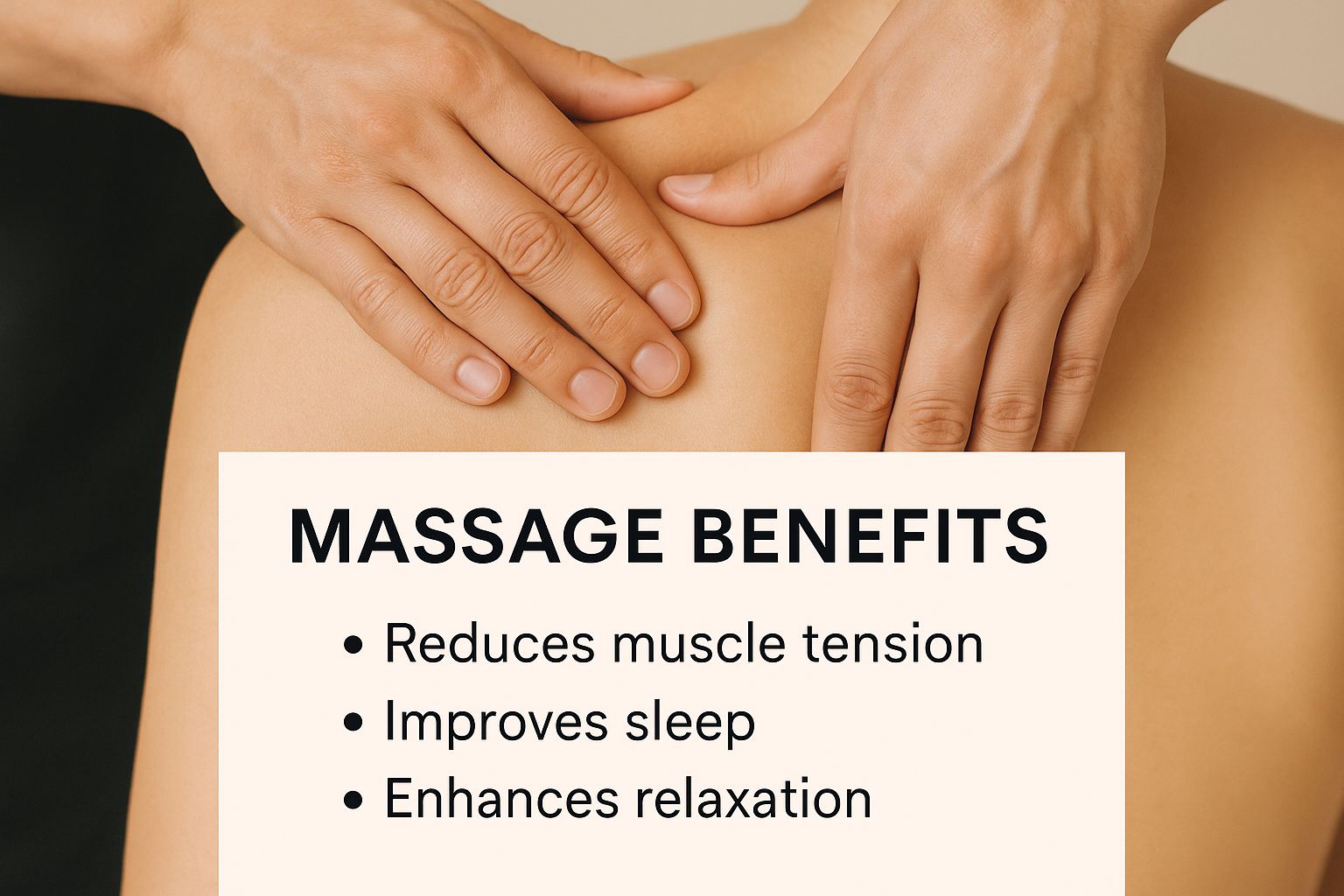
This visual highlights how specific techniques can lead to broader health improvements, moving beyond simple pain reduction to include better mobility and overall wellness.
To help you understand how a therapist might approach your specific issue, we've put together a guide. The table below matches common pain conditions with the massage techniques best suited to address them, giving you an idea of what to expect from a targeted session.
Pain-Specific Massage Techniques Guide
Strategic massage approaches matched to different pain conditions and expected outcomes
| Technique | Best For | Pressure Level | Expected Results |
|---|---|---|---|
| Swedish Massage | General relaxation, stress relief, minor muscle aches | Light to Medium | Reduced muscle tension, improved circulation, and an overall sense of calm. |
| Deep Tissue Massage | Chronic muscle pain, knots (adhesions), limited mobility | Firm to Deep | Breaks down scar tissue and muscle knots, improving range of motion and providing lasting pain relief. |
| Trigger Point Therapy | Referred pain (e.g., headaches from neck tension), localized muscle knots | Direct, Sustained | Releases specific points of tension, often eliminating pain felt in other areas of the body. |
| Myofascial Release | Widespread muscle pain, stiffness (e.g., fibromyalgia), fascial restrictions | Gentle, Sustained | Stretches and releases the connective tissue (fascia), restoring mobility and easing chronic tightness. |
| Sports Massage | Repetitive use injuries, pre/post-event muscle care, enhancing athletic performance | Varies (Light to Deep) | Reduces muscle soreness, improves flexibility, and helps prevent or treat sports-related injuries. |
| Lymphatic Drainage | Swelling (edema), post-surgery or injury recovery, inflammation | Very Light | Encourages the movement of lymph fluids, reducing swelling and supporting the immune system. |
This table shows there is a specialized approach for almost every type of pain. A skilled therapist will often combine modalities to create a session that is perfectly suited to your body's needs at that moment.
Tailoring Treatment to the Source of Pain
A therapist’s ability to diagnose the root cause of pain is what turns a simple massage into a powerful therapeutic treatment. They consider the type, location, and history of your discomfort to select the best modality. Let’s explore a couple of examples:
- Trigger Point Therapy: This technique is perfect for addressing "referred pain"—that annoying ache you feel in one spot that's actually caused by a tight knot somewhere else. By applying direct, sustained pressure to these trigger points, a therapist can release the knot and stop the referred pain. It’s like flipping a single circuit breaker to turn off a blaring alarm in another room.
- Myofascial Release: If you deal with chronic, widespread tension and stiffness, myofascial release might be your solution. This method uses gentle, sustained pressure to stretch the fascia, which is the web of connective tissue that surrounds your muscles. Releasing restrictions in the fascia can restore mobility and provide significant relief from long-standing tightness that other techniques can’t reach.
By understanding how therapists adapt their approach for everything from acute sports injuries to persistent arthritis, you can better communicate your needs. Don't hesitate to ask your therapist why they chose a certain technique; it can offer valuable insight into your own healing process.
Why People Choose Massage Over Traditional Pain Treatments
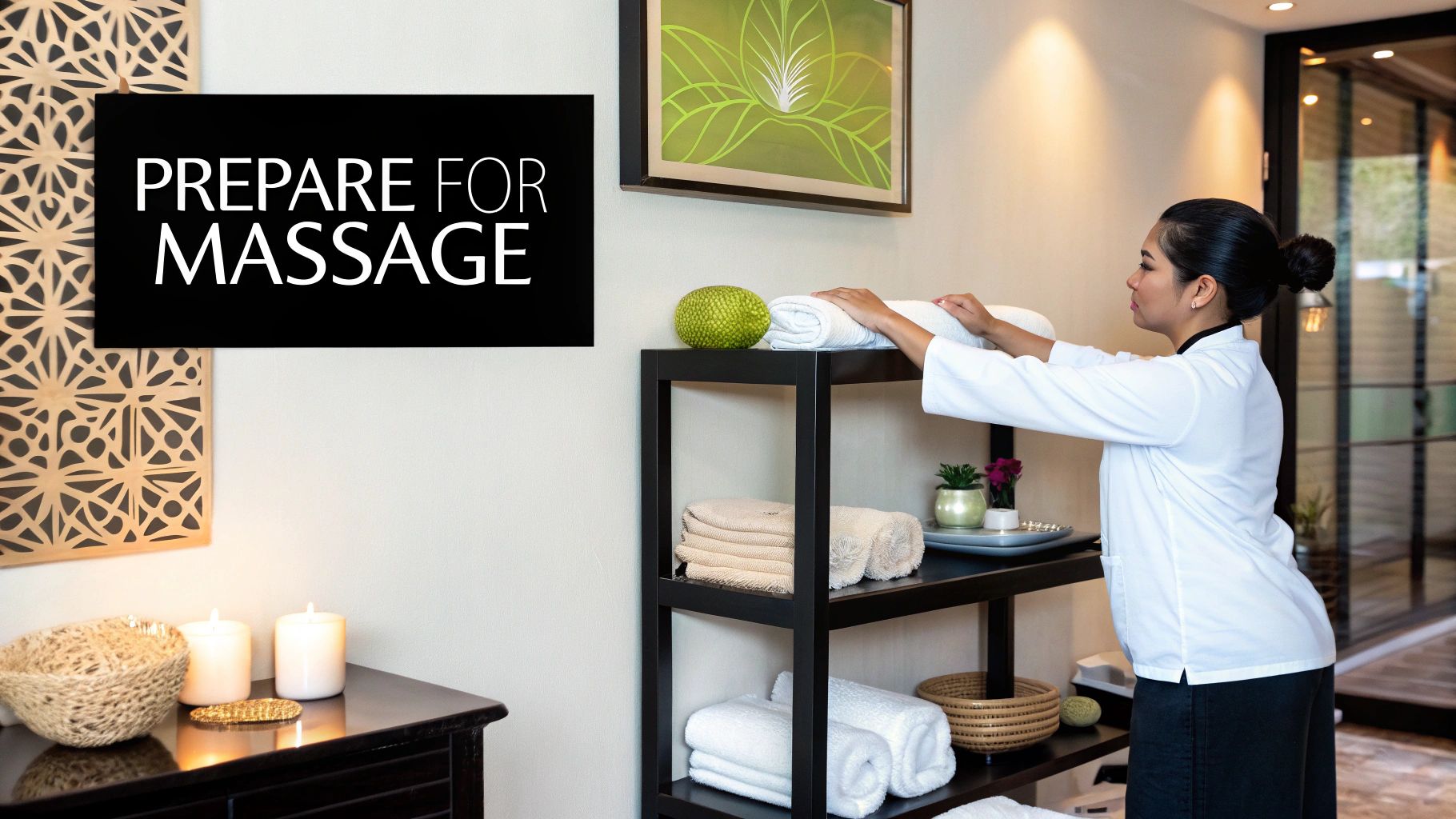
When you're dealing with persistent pain, finding relief can feel like standing at a fork in the road. On one path, you have conventional medicine with medication and procedures. On the other, you have alternative methods like pain relief massage therapy. Many people find themselves weighing these options, often looking for a solution that gets to the root of the problem instead of just silencing the alarm bells.
Therapeutic massage offers a different approach. Instead of just masking pain, it focuses on restoring proper function and correcting the physical imbalances causing the discomfort. Think of it as treating the body like an interconnected system, where muscle knots, stress levels, and poor posture all play a role in your well-being. This perspective is a major reason people turn to massage, especially when other treatments offer only temporary fixes or come with undesirable side effects.
A Growing Preference for Hands-On Healing
The trust in massage therapy isn't just a feeling; it’s a clear trend in how people manage their health. Recent surveys show just how effective this approach can be. In one study of U.S. adults who had a massage, 28% said that massage therapy gave them the most significant relief from pain. This number is striking because it's the exact same percentage of people who chose medication as their top pain relief method. For many, a skilled massage is just as powerful as a pill. You can see the full breakdown by reviewing the survey results about massage for pain relief.
This statistic reveals a significant shift: people are actively choosing a therapy that collaborates with their body's own ability to heal. For some, massage is their main form of treatment. For others, it's a key component of a broader care plan that includes doctors and physical therapists. Understanding the differences between treatments, such as comparing a sports massage vs. a regular massage, helps you select the right approach for your specific needs. Ultimately, choosing massage reflects a desire for a proactive and empowering way to handle pain and improve overall quality of life.
The Healthcare Revolution Embracing Massage Therapy
A major change is happening in healthcare: pain relief massage therapy is shifting from a spa luxury to a clinical necessity. What many once saw as a special treat is now becoming a critical part of patient care. This isn't a small trend on the edges of medicine; it's gaining momentum right at the heart of our healthcare system. Leading hospitals are adding licensed massage therapists to their pain management teams, insurance companies are broadening coverage for therapeutic massage, and medical schools are starting to teach future doctors about the power of structured, healing touch.
This integration is built on a solid foundation of growing scientific evidence and professional standards that promise safe, reliable, and effective care.
From Alternative to Essential
The way we think about massage is evolving because the data proves it works. For hospital administrators, it's a practical, non-drug option for improving patient recovery and overall satisfaction. Top-tier medical centers now offer massage not as an add-on but as a standard procedure for everything from post-surgery healing to managing chronic pain. This professional growth is marked by:
- Advanced Certifications: Therapists are now seeking out specialized credentials in areas like medical massage and oncology massage to meet specific patient needs.
- Evidence-Based Protocols: Treatment plans are increasingly shaped by scientific research to deliver the most effective care. If you're interested in how specific techniques work, you can learn more about the benefits of deep tissue massage in our other article.
A Market Reflecting Mainstream Acceptance
This growing acceptance in the medical world is matched by strong economic indicators. The global market for massage therapy was valued at $18.25 billion in 2023. It's expected to grow at a compound annual rate of 7.2%, climbing to an estimated $29.53 billion by 2030. This expansion is fueled by people actively looking for effective ways to manage chronic pain and stress-related conditions. As demand increases, the healthcare industry is responding by making these services easier to access. You can discover more insights about the massage therapy market and its impressive growth. The combined approval from medical experts and consumers alike signals a new chapter where therapeutic massage is a respected and indispensable part of modern healthcare.
Your First Session: What Actually Happens
Stepping into your first pain relief massage therapy session can feel a little uncertain, especially when you’re already dealing with discomfort. The great news is that this initial appointment is a collaborative process, built entirely around your needs and comfort. It's less about mystery and more about creating a clear, personalized roadmap to your healing.
The most important part of this session often happens before the massage even starts.
The Initial Consultation: Your Story Matters
First things first, your therapist will sit down with you for a detailed conversation. This isn't just casual chat; it's a vital part of the process where you and your therapist become partners in your care. Think of it as a strategy meeting for your well-being. They will want to understand:
- Your Pain History: When did the pain start? What actions or positions make it better or worse? How does it affect your daily life, from work to hobbies?
- Your Medical Background: It's important for them to know about any previous injuries, surgeries, or ongoing medical conditions to ensure the treatment is safe.
- Your Goals: What do you hope to get out of this? Are you aiming for better range of motion, fewer headaches, or simply the ability to sit through a movie without pain?
This dialogue is essential. An open and honest conversation allows the therapist to design a session that is both safe and specifically effective for you.
Communicating During the Session
Once the hands-on portion begins, communication remains just as important. Your therapist should check in with you about the pressure and your comfort level. It is crucial that you speak up if something doesn’t feel right. You are always in control of the session.
If the pressure is ever too intense, or if a particular spot feels too tender to be worked on, let them know right away. A good therapist relies on this feedback to adjust their technique. Remember, therapeutic massage should feel productive and effective, not just painful. Your comfort is always the priority.
Maximizing Your Results: Before, During, and After
To truly get the most out of your appointment, a little preparation beforehand and some simple follow-up care can make a huge difference. These steps help your body get ready for the work and prolong the benefits long after you've left the table.
To help you get the best results, we’ve put together a guide outlining simple, effective steps you can take before, during, and after your session.
Complete Session Preparation Guide
Step-by-step preparation and follow-up strategies to maximize your therapeutic massage benefits
| Before Session | During Session | After Session | Expected Timeline |
|---|---|---|---|
| Hydrate Well: Drink plenty of water throughout the day. | Communicate Openly: Provide feedback on pressure and comfort. | Rehydrate: Drink more water than usual. | 24 hours prior to your appointment. |
| Eat Lightly: Avoid a large, heavy meal an hour or two before. | Focus on Your Breath: Take slow, deep breaths to help muscles relax. | Gentle Movement: Take a slow walk or do light, approved stretches. | 1-2 hours prior to your appointment. |
| Arrive Early: Give yourself 10-15 minutes to fill out paperwork and relax. | Stay Present: Try to let go of outside distractions and focus on your body. | Warm Bath: Consider an Epsom salt bath to soothe muscles. | Within 24 hours after the session. |
| Share Your Goals: Be clear about what you want to achieve. | Don't "Help": Avoid tensing or trying to lift a limb for the therapist. | Listen to Your Body: Pay attention to how you feel and rest if needed. | Ongoing for best results. |
Following these guidelines helps turn your first appointment from a simple massage into a powerful step toward lasting relief. It’s a structured approach that combines a detailed consultation, open communication, and mindful self-care to set you up for success.
Your Most Important Questions Answered Honestly
Starting a journey with pain relief massage therapy naturally brings up some practical questions and a few understandable concerns. Getting clear, straightforward answers is the best way to feel confident and ready for your healing process. Let's dive into some of the most common questions people ask before they book a session.
Will a Therapeutic Massage Hurt?
This is probably the top concern for most people, and the answer is: it shouldn't cause "bad" pain. A therapeutic massage, particularly with methods like deep tissue or trigger point therapy, might have moments of intense sensation. However, it should always feel productive. Think of it as a "good hurt"—that satisfying feeling when a tight knot finally lets go, not a sharp or unbearable pain.
A professional therapist will always work within your comfort level. Your communication is vital. If the pressure ever feels like too much, it's important to speak up right away. Your feedback helps the therapist fine-tune their technique to be both effective and comfortable for you.
How Often Do I Need to Get a Massage?
The right frequency for massage is completely based on your unique situation and what you want to achieve. There's no single schedule that fits everyone.
- For Acute Pain: If you're dealing with a recent injury, coming in once or twice a week for a few weeks can help manage inflammation and support a quicker recovery.
- For Chronic Conditions: For long-term issues like persistent back pain or arthritis, a maintenance plan of once every 2-4 weeks is often effective for managing symptoms and keeping flare-ups at bay.
- For General Wellness: If your goal is stress relief and proactive self-care, a monthly massage can do wonders for your overall well-being.
Your therapist will collaborate with you to design a treatment plan after your first visit and will adjust it as you see progress. The focus is always on what your body needs to heal and function at its best.
How Do I Know if It's Actually Working?
Knowing if your treatment is effective is essential. Progress isn't always a dramatic, overnight transformation. Instead, you should look for gradual but meaningful improvements. It can be helpful to keep a simple journal to track how you're feeling.
Are you having fewer pain flare-ups? Is your range of motion improving? Can you do daily things, like carrying groceries or sitting at your desk, with less discomfort? These small wins are strong indicators that the therapy is making a difference. The goal of true pain relief massage therapy is to create lasting improvements in your quality of life, not just a fleeting sense of relief.
At La Moon Massage and Facial, our skilled therapists are here to support you through every part of this process, from answering your first questions to creating a treatment plan that delivers real, positive change. Experience the benefits of personalized wellness care with us today.
What Is Therapeutic Massage? Your Complete Healing Guide
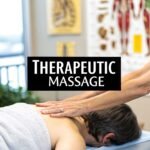
Beyond Spa Day: What Makes Massage Truly Therapeutic
When most people think of massage, they picture a relaxing spa day—a peaceful escape with soft music and scented oils. While that kind of pampering is certainly a treat, it only tells part of the story. The real distinction of a therapeutic massage isn't the atmosphere, but the intent and precision behind every movement. What is therapeutic massage? It's a targeted, outcome-based treatment focused on solving specific physical problems.
Think of it this way: a relaxation massage is like a gentle car wash, leaving the outside polished and feeling good. A therapeutic massage, however, is like taking your car to a specialized mechanic for a tune-up. The practitioner isn't just aimlessly rubbing muscles; they are applying calculated techniques to get to the root of your discomfort, whether it’s from a herniated disc, chronic headaches, or sciatica.
A Clinical Focus on Healing
This clinical approach often changes the environment. A therapeutic massage might take place in a setting that feels more like a physical therapy office than a luxury spa. Your session will start with a detailed conversation where the therapist assesses your posture, goes over your medical history, and listens to your specific complaints. The goal isn't just to pick a pleasant aroma; it's to build a personalized treatment plan.
This is why doctors, chiropractors, and other healthcare providers are increasingly recommending therapeutic massage as a key part of patient care. The practice has moved from a simple wellness activity to a respected field, backed by scientific evidence and countless success stories. This growing acceptance is also seen in its economic growth. The global market for massage equipment was valued at around USD 5.9 billion in 2025 and is expected to reach nearly USD 9.9 billion by 2033. You can review the full market analysis to see more data on how massage is becoming a central part of modern wellness culture.
Key Distinctions to Remember
So, what truly separates a therapeutic session from a standard spa massage? Here are the fundamental differences:
- Assessment: Therapeutic sessions always begin with a thorough evaluation of your specific condition and goals.
- Specificity: The techniques are precisely applied to certain muscles, tissues, and joints to address a diagnosed problem.
- Collaboration: Practitioners frequently work in tandem with doctors, chiropractors, and physical therapists to support your overall health plan.
- Focus: The main objective is functional improvement—like reducing pain, improving your range of motion, and restoring your body's health—not just simple relaxation.
The Hidden Science Of Healing Touch That Actually Works
Have you ever wondered why a skilled therapist’s hands can provide relief when other methods fall short? The answer isn't magic; it’s a fascinating combination of physiological responses that redefine our understanding of pain. To truly grasp what therapeutic massage is and why it's so effective, we need to look at how it communicates with your body’s internal control systems.
Think of your nervous system as a busy highway with constant traffic, where pain signals are cars rushing to their destination: your brain. A therapeutic massage acts like a sophisticated traffic control system. It creates new, non-painful sensations—like pressure and warmth—that travel along the same nerve pathways. This new “traffic” effectively closes the gate on the pain signals, preventing many of them from reaching the brain. This concept, known as the gate control theory of pain, is a cornerstone of how healing touch works. Instead of just masking pain, massage cleverly redirects your body’s attention.
A Cascade of Positive Changes
The benefits don't stop at blocking pain signals. Targeted pressure from a therapeutic massage initiates a series of healing effects throughout your body.
- Increased Circulation: The manipulation of soft tissue stimulates blood flow. Imagine it as a special delivery service that rushes oxygen and vital nutrients to damaged muscles, which speeds up tissue repair and helps reduce inflammation.
- Lymphatic Drainage: The lymphatic system is your body’s sanitation department. Massage helps it flush out metabolic waste and toxins that accumulate in tissues, which can otherwise contribute to pain and sluggishness.
- Endorphin Release: The applied pressure stimulates the brain to release endorphins, your body’s natural painkillers. These neurochemicals produce a sense of well-being and can provide lasting relief long after the session ends.
The following chart from a study on massage therapy shows how treatments can reduce inflammatory responses and promote muscle recovery.
This data reveals a significant drop in inflammatory cytokines after a massage, offering scientific support for its healing capabilities. By working with these powerful biological mechanisms, a skilled therapist at La Moon Massage and Facial can address everything from chronic discomfort to immune system function, demonstrating that therapeutic touch is a science-backed path to genuine recovery.
Matching Your Pain to the Right Therapeutic Technique
Knowing you need a therapeutic massage is the first step, but choosing the right technique is where true healing begins. Think of it this way: a mechanic wouldn't use a sledgehammer to fix a delicate engine sensor. In the same way, a skilled massage therapist uses a specialized toolkit of techniques, and they won't apply a general relaxation stroke to release a deep, stubborn knot. The key is to match the tool—the technique—to your specific problem.
This personalized approach is vital because different kinds of pain come from different sources in the body. A software developer with neck tension from hunching over a laptop needs a different strategy than an athlete recovering from a strained hamstring. The athlete's session, for instance, might involve more targeted stretching and pressure on overused muscles. If you're curious about how these specialized treatments compare, you can learn more about sports massage versus regular massage in our detailed guide.
Your Guide to Common Techniques
To get a better picture of what therapeutic massage is in practice, let's break down some of the most effective techniques and the problems they solve. Each method works on a distinct level to help restore function and relieve pain.
- Deep Tissue Massage: This is much more than just a massage with firm pressure. It involves slow, deliberate strokes that focus on the deeper layers of muscle and connective tissue. It’s a go-to solution for chronic aches and pains, particularly in areas like a stiff neck, upper back, low back, and sore shoulders.
- Myofascial Release: Imagine your muscles are wrapped in a fine web of connective tissue called fascia. When this web gets tight or restricted, it can pull on your muscles, causing pain and limiting your movement. Myofascial release uses gentle, sustained pressure on these tight spots, allowing the fascia to slowly stretch and release, much like carefully smoothing out a stiff, wrinkled piece of fabric.
- Trigger Point Therapy: Have you ever felt a small, painful "knot" in a muscle that, when pressed, sends a jolt of pain to another area? That's a trigger point. This technique applies direct, isolated pressure to these specific spots. The goal is to deactivate the trigger point, which helps break the cycle of referred pain. It’s especially useful for tension headaches that often start from knots in the neck and shoulders.
To help you understand which approach might be best for you, here is a quick comparison of these common therapeutic techniques.
Therapeutic Massage Techniques Comparison
A comprehensive comparison of major therapeutic massage techniques, their primary applications, pressure levels, and ideal candidates.
| Technique | Pressure Level | Best For | Duration | Recovery Time |
|---|---|---|---|---|
| Deep Tissue Massage | Firm to Deep | Chronic muscle tension, stubborn knots, postural problems, repetitive strain injuries | 60-90 minutes | Possible soreness for 24-48 hours |
| Myofascial Release | Gentle to Firm | Fascial restrictions, limited mobility, fibromyalgia, post-injury stiffness | 60-90 minutes | Minimal; may feel more open and flexible immediately |
| Trigger Point Therapy | Direct & Intense | Specific "knots," tension headaches, sciatica-like pain, localized pain referral | 30-60 minutes (often part of a longer session) | Soreness on the specific point for a day is common |
As you can see, the right technique depends entirely on the source of your pain. A deep tissue massage addresses widespread chronic tension, while trigger point therapy hones in on very specific problem spots.
Even gentle techniques are fundamental for stress relief, a critical part of any therapeutic plan.

The image reinforces that even gentle massage is a powerful tool for managing stress, which is often a primary goal for those seeking therapeutic care. The most important step is to clearly communicate your symptoms and goals to your therapist at La Moon Massage and Facial. This conversation ensures you receive the exact technique your body needs to heal.
Who Really Benefits From Therapeutic Massage (Hint: Probably You)
It's easy to think that therapeutic massage is only for specific people—like a professional athlete recovering from an injury or an older adult managing arthritis. While it’s certainly effective for them, this view misses the bigger picture. The truth is, if you have a body that carries you through the day, you're likely a candidate for the relief that targeted massage provides. The person who benefits isn't always who you'd first imagine.
Think about the modern professional. A software developer, for instance, might spend eight hours a day hunched over a keyboard, leading to repetitive strain in their wrists or a persistent ache in their neck. Focused sessions on the forearms, wrists, and upper back can release this built-up tension, making work more comfortable and productive. Likewise, a busy executive under constant pressure might struggle with stress-induced headaches and high blood pressure. Therapeutic massage can help by calming the nervous system and easing the tight muscles that trigger those debilitating headaches.
Beyond the Desk and Field
The applications of therapeutic massage reach far beyond office workers and athletes. Here are just a few examples of people who find significant relief:
- Construction Workers: The physical toll of manual labor often results in chronic low back pain. Consistent therapeutic work can help manage this pain, restore mobility, and potentially avoid more invasive treatments like surgery.
- Expecting Mothers: Pregnancy brings a wave of physical changes, from sciatica to swollen ankles. Prenatal massage is a safe, drug-free way to address this discomfort and promote relaxation for both mother and baby.
- Individuals with Chronic Conditions: For those managing conditions like fibromyalgia or multiple sclerosis, therapeutic massage can be a vital part of their wellness routine. It helps manage pain, lessen muscle stiffness, and improve overall quality of life when other approaches may not provide complete solutions.
A Growing Trend in Wellness
The expanding role of massage isn't just a feeling; it's a measurable trend. This rise in popularity shows a shift in how people approach wellness, preferring non-invasive options to manage chronic pain, musculoskeletal issues, and mental health. An aging population has also increased the demand for therapies that support long-term well-being. To learn more about this growth, you can explore insights on the rising demand for massage therapy.
Ultimately, the audience for therapeutic massage is incredibly diverse, from athletes pushing for peak performance to individuals just trying to get through the day without aches and pains. Whether you're an athlete or simply someone with sore muscles, the principles of recovery are the same. You might find our guide on the benefits of sports massage useful, as it details techniques that help anyone recover more effectively. The key is to listen to your body's signals—like persistent aches, limited movement, or stress-related tension—that indicate it’s time for targeted, therapeutic care.
Why Healthcare Is Finally Embracing Therapeutic Massage

A significant change is happening within the world of healthcare. For many years, therapeutic massage was often seen as a spa luxury or an "alternative" method, separate from standard medical practice. That perspective is shifting, as major medical centers and insurance providers now increasingly see its true value. This isn't a random development; it's the result of growing research, high healthcare costs, and people seeking effective, non-drug options for pain relief.
A Data-Driven Approach to Pain and Recovery
The acceptance of therapeutic massage into mainstream medicine is backed by strong evidence. As more studies show its benefits for conditions like chronic low back pain and post-surgery healing, doctors are more frequently prescribing it alongside traditional care. It's now quite common for a physician to refer a patient to a skilled massage therapist for specific, targeted bodywork.
This clinical validation is changing how therapeutic massage is understood—it’s not just for relaxation, but a strategic tool for healing. For active individuals, this is a major advantage. Our guide on sports massage therapy for recovery details how these same principles can help anyone stay active and pain-free.
Economic and Technological Catalysts
The economic landscape is also a major factor. The massage service market was valued at about USD 19.93 billion in 2024 and is expected to reach USD 30.57 billion by 2030. This growth points to a larger shift toward preventive and whole-body health. Insurance providers are recognizing that covering therapeutic massage can be more economical than paying for costly surgeries or long-term prescriptions. You can discover more insights about the massage service market and its impressive growth projections.
Technology is also playing an important part. Modern tools, like precision percussive devices, and methods for tracking progress give therapists the ability to provide more focused and measurable outcomes. This combination of ancient, touch-based healing with contemporary science is why therapeutic massage is no longer an outlier. It is becoming a vital piece of modern, patient-focused healthcare.
Your First Therapeutic Massage Session: What Really Happens
Walking into La Moon Massage and Facial for your first therapeutic session shouldn't feel like a leap into the unknown. Knowing what to expect can turn any nervousness into confident anticipation. The entire process is built around one central purpose: to understand and address your specific issue. This isn't a one-size-fits-all spa treatment; it's a collaborative journey focused entirely on improving your function and well-being.
Your visit begins with a detailed consultation, which is much more than just pointing to where it hurts. A skilled practitioner will ask about your lifestyle, daily activities, work habits, and any previous injuries. Think of your therapist as a detective on a fact-finding mission, searching for clues in your posture, movement, and health history to understand the root cause of your discomfort. This is the perfect time for you to clearly communicate your goals, pain levels, and any preferences you have.
What Happens During the Treatment
Once the treatment begins, your therapist will use professional draping techniques, meaning only the area being worked on is uncovered at any time. This practice is standard and ensures you feel secure and your privacy is respected throughout the session. Communication remains vital; your practitioner will check in with you about the pressure and how you're feeling.
A session typically follows a logical progression:
- Warm-up: The session starts with gentle, broad strokes. This isn't just to help you relax; it prepares the muscles for deeper work and calms your nervous system.
- Targeted Work: Next, the therapist applies specific, focused techniques, such as deep tissue or trigger point therapy, directly to your problem areas. You might feel some tenderness in these spots—this is a normal sign that the treatment is reaching the source of the tension.
- Integration: The session usually ends with soothing, broader strokes. This helps integrate the focused work into the rest of the body, leaving you with a sense of wholeness and promoting deep relaxation.
An effective session often results in an immediate feeling of increased mobility and less pain. It's also normal to experience some temporary soreness, which is a positive indicator that deep, corrective work has taken place.
To give you a clearer picture, here is a breakdown of what a typical session looks like from start to finish.
Therapeutic Massage Session Timeline
A detailed breakdown of what happens during each phase of a therapeutic massage session, from arrival to departure
| Phase | Duration | Activities | What to Expect |
|---|---|---|---|
| Arrival & Intake | 5-10 minutes | Fill out intake form, initial discussion with the therapist. | A welcoming environment. Be ready to discuss your health history, pain points, and goals for the session. |
| Consultation & Assessment | 5-10 minutes | In-depth conversation, possible postural or movement assessment. | The therapist will ask clarifying questions to understand the root cause of your issue. You'll discuss a treatment plan. |
| Preparation | 5 minutes | Therapist leaves the room for you to undress to your comfort level and get on the table under the sheet/blanket. | Complete privacy. The therapist will knock before re-entering the room. |
| Hands-On Treatment | 50-80 minutes | The massage itself, including warm-up, targeted techniques, and integration. | Constant communication about pressure. You might feel a "good hurt" on tense spots. Professional draping is used at all times. |
| Post-Treatment | 5 minutes | You get dressed while the therapist waits outside. | Time to slowly reorient yourself. The therapist will offer you water. |
| Wrap-up & Aftercare | 5-10 minutes | Therapist provides feedback, recommends aftercare (stretches, water), and discusses a follow-up plan. | Practical advice to extend the benefits of your massage. Opportunity to ask questions and schedule your next session. |
This timeline shows that a therapeutic massage is a structured process designed for your specific needs, involving much more than just the time spent on the table.
After Your Session: Maximizing the Benefits
The benefits of your session don't stop when you walk out the door. Your therapist will likely suggest some simple aftercare steps to help you get the most out of the treatment. These often include:
- Drinking plenty of water to help your system process and flush metabolic waste released from the muscles.
- Performing gentle stretches to help maintain the new mobility you've gained.
- Using heat or cold therapy at home to manage any post-session soreness.
Finally, you’ll discuss a potential follow-up plan. Therapeutic massage is most effective when viewed as a process rather than a one-time fix. Consistent sessions build on the progress of the last, guiding your body toward lasting relief and better overall function.
Building Your Personal Therapeutic Massage Strategy
While a single massage can feel like a mini-vacation, the real, lasting change from therapeutic massage comes from a consistent and thoughtful approach. Think of it less like a single spa day and more like a personal training plan for your body. The goal is to move beyond the occasional fix and build a roadmap to sustainable wellness. This journey starts with a simple conversation with your therapist to create a realistic plan that fits your body's needs, your schedule, and your budget.
Establishing Your Goals and Tracking Progress
A successful strategy needs clear, measurable goals. Instead of a vague desire to "feel better," work with your therapist to define what success looks like for you.
- For Chronic Pain: Your goal might be to reduce your lower back pain from a 7/10 to a 3/10 over six weeks. The real-world win? Being able to sit through a whole movie without that nagging ache.
- For Mobility: An objective could be regaining enough shoulder flexibility to easily reach the top shelf in your kitchen.
- For Performance: An athlete might set a goal to cut post-workout recovery time by 20% over a two-month period.
Keep track of how you're doing. A simple journal where you note pain levels, mobility changes, and how you feel after each session provides valuable feedback. This information helps you and your therapist see what’s working and fine-tune your plan along the way.
Integrating Massage with Your Lifestyle
Therapeutic massage delivers its best results when it’s one piece of your overall wellness puzzle. You can amplify its benefits by pairing it with other healthy habits. This could include targeted stretches your therapist suggests, making simple ergonomic adjustments to your desk setup, or practicing stress-reduction techniques.
This integrated view is catching on. The global market for massage equipment was valued at USD 11.37 billion in 2024 and is expected to grow, showing a clear demand for accessible, at-home wellness solutions. You can discover more about the massage equipment market trends.
This proactive approach ensures each massage session builds upon the last, creating a solid foundation for your long-term health. Are you ready to map out your own path to feeling your best?
Start building your therapeutic massage strategy with us. Book your personalized session at La Moon Massage and Facial today and take the first step toward lasting relief.
